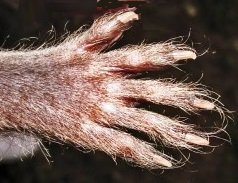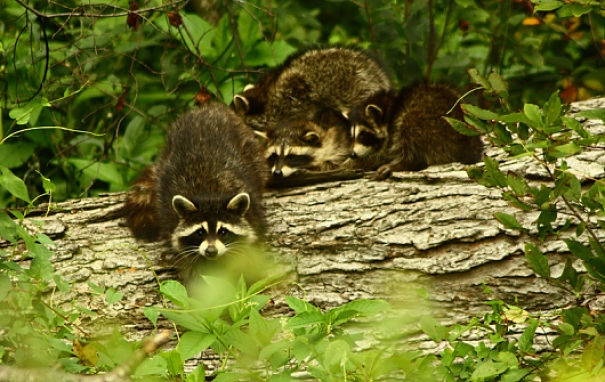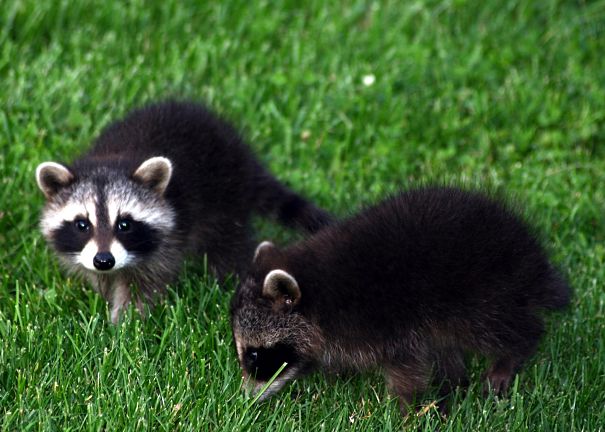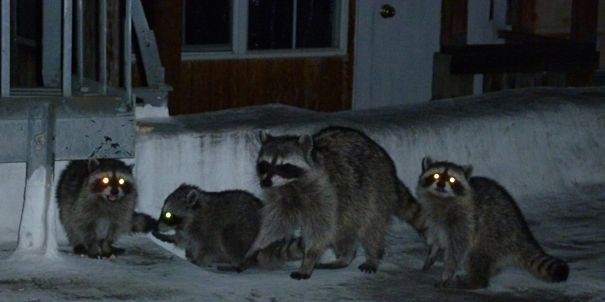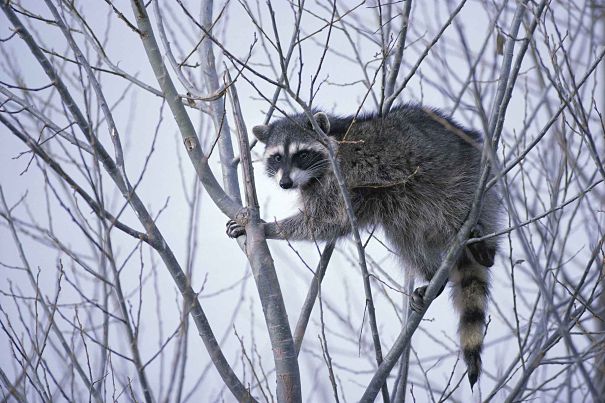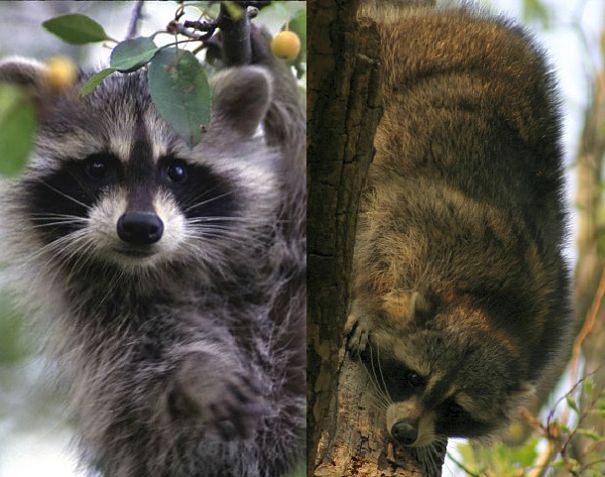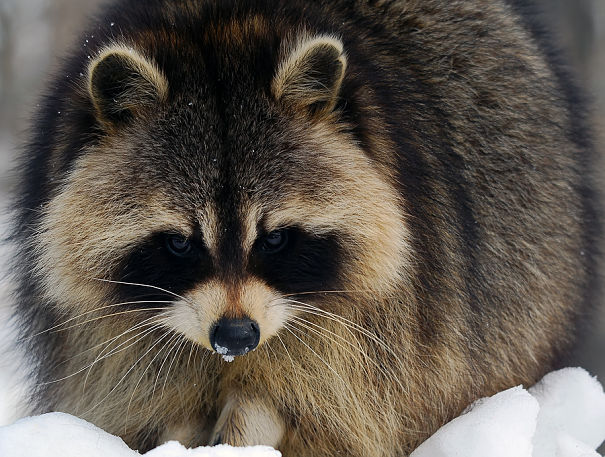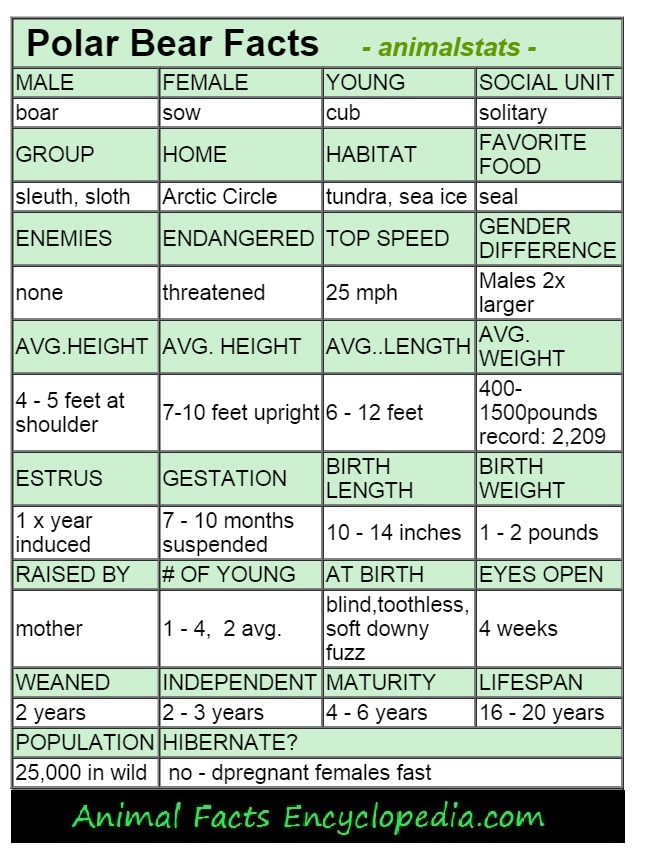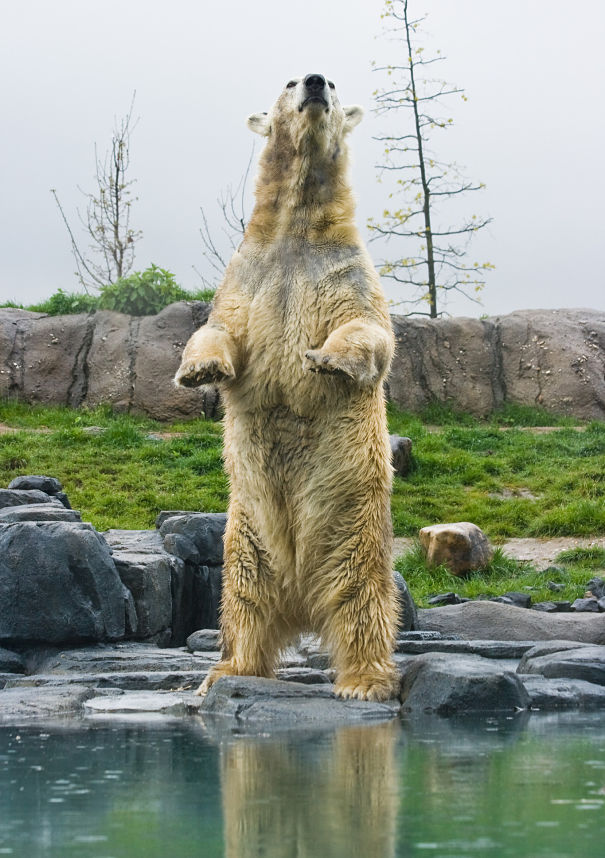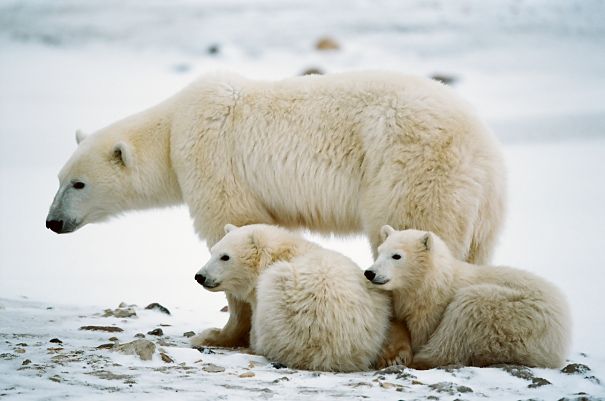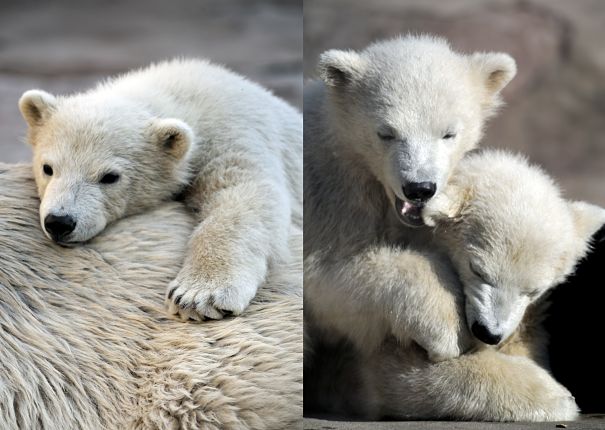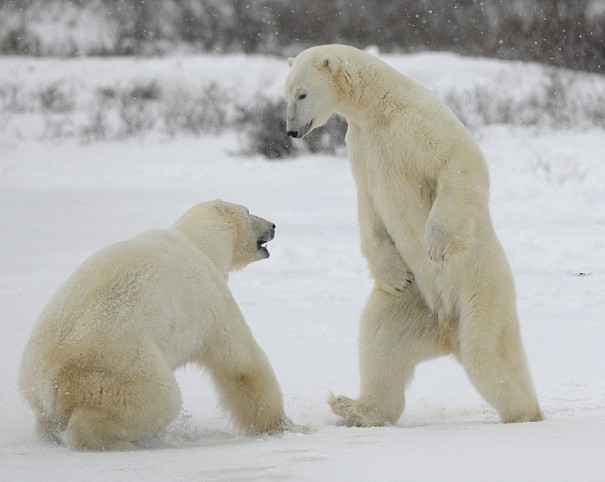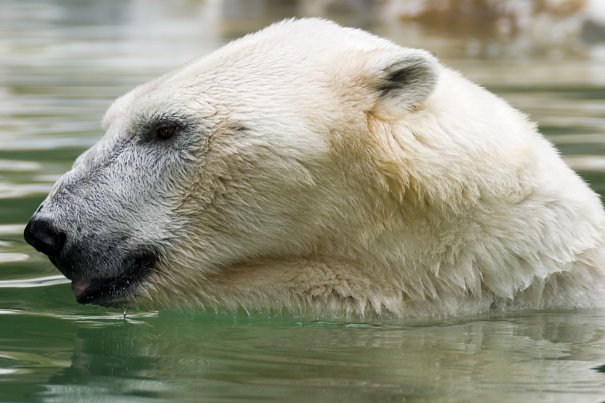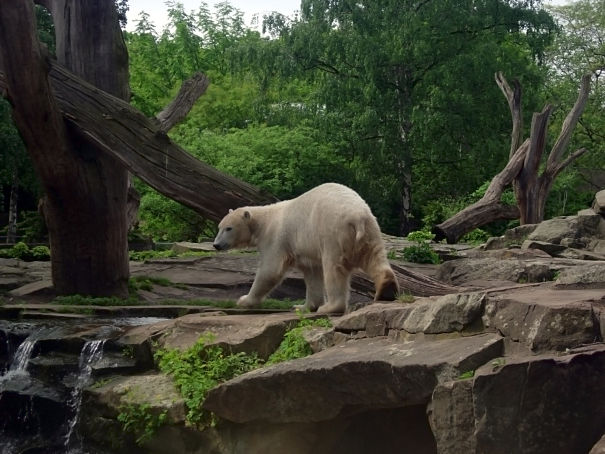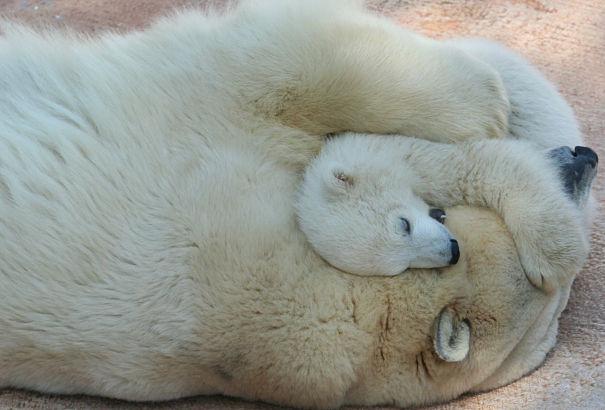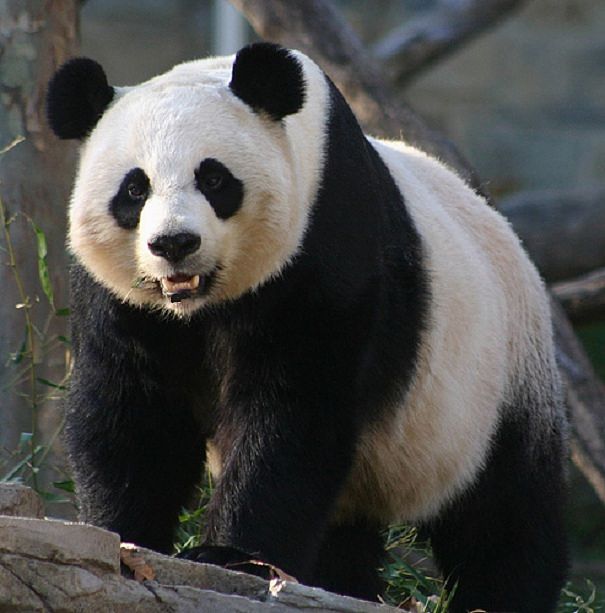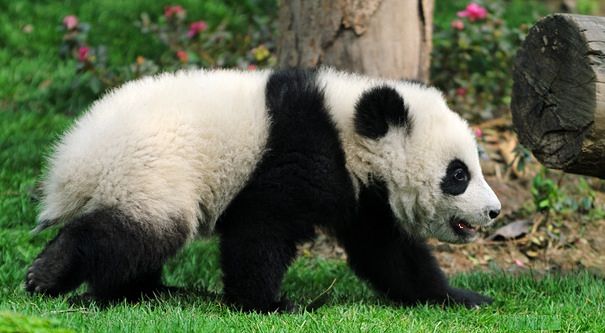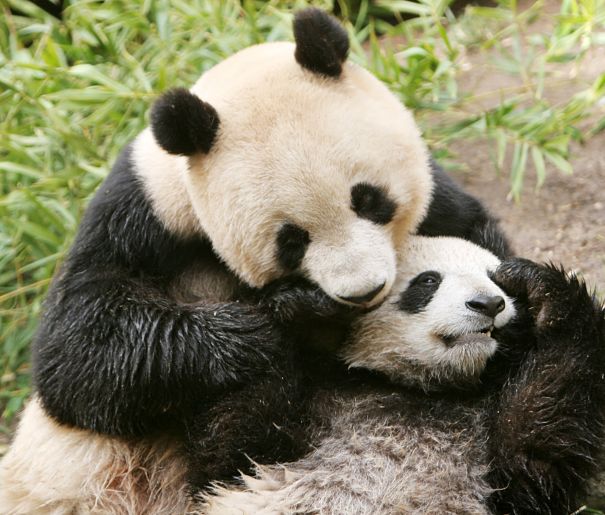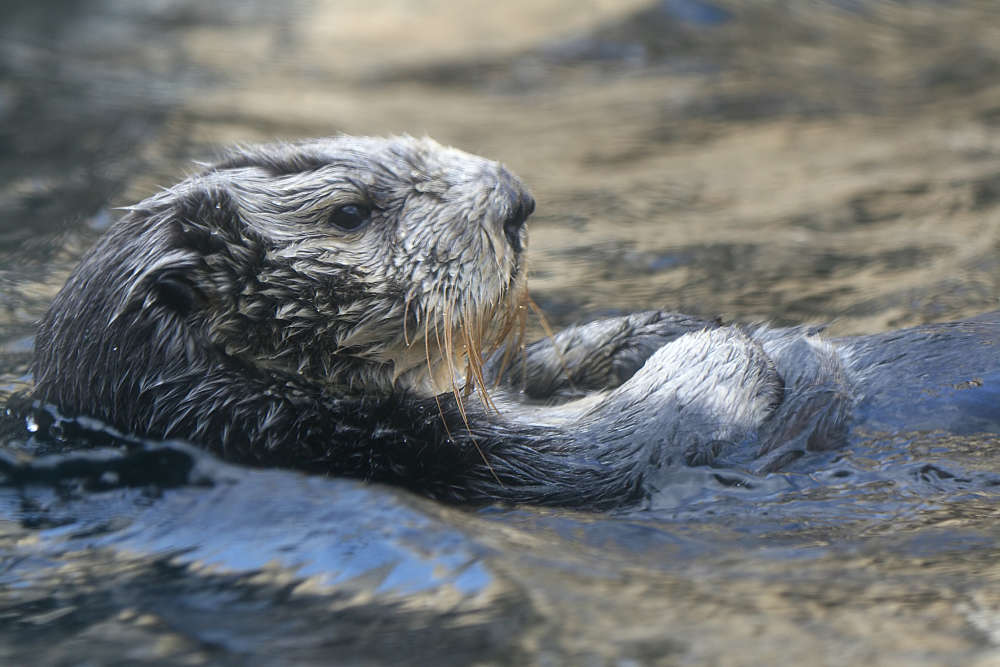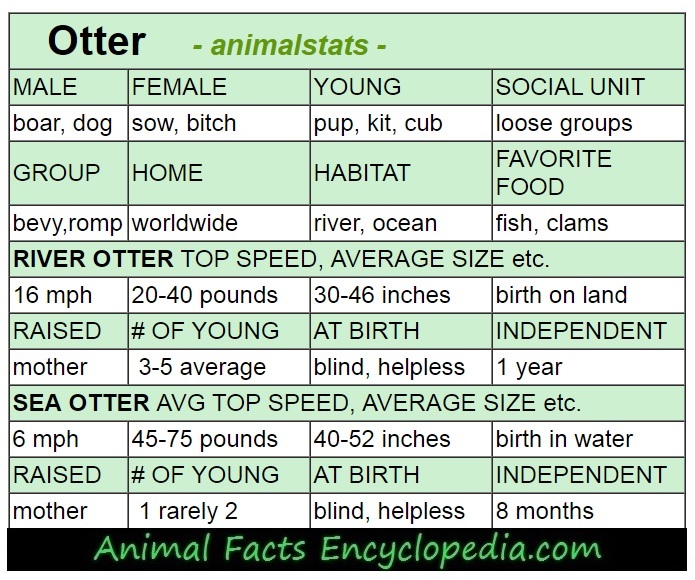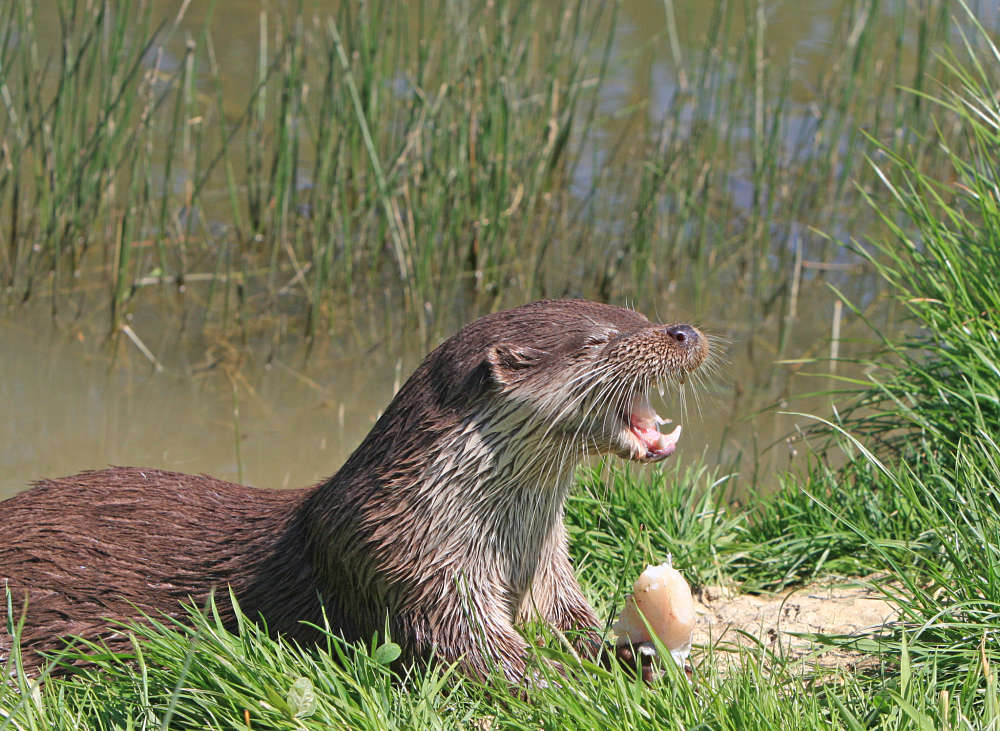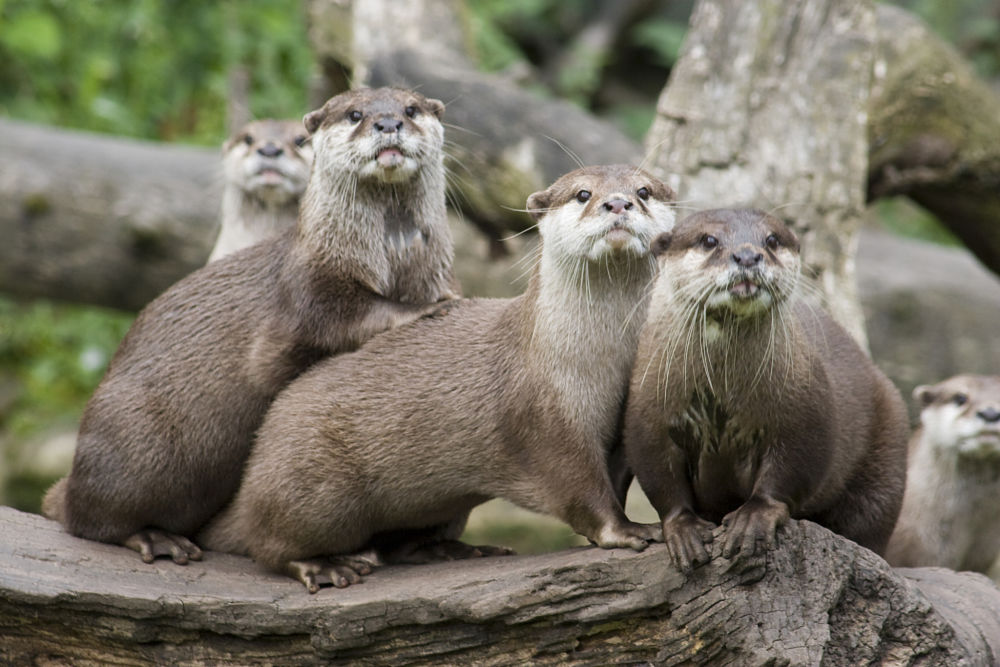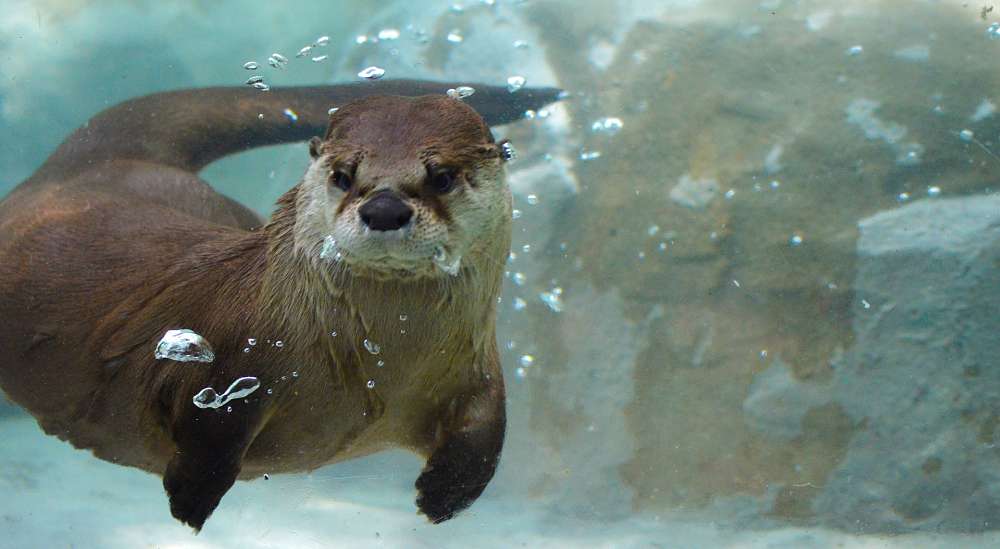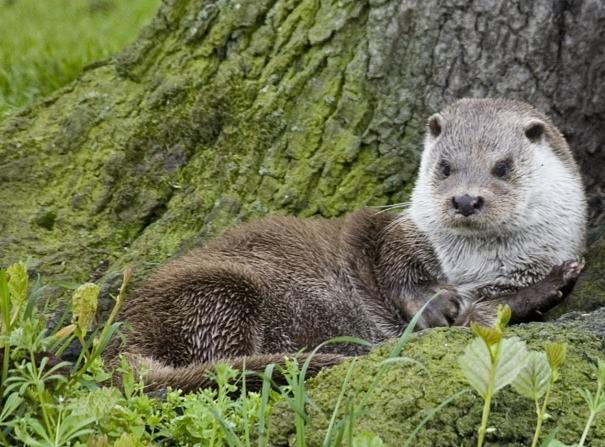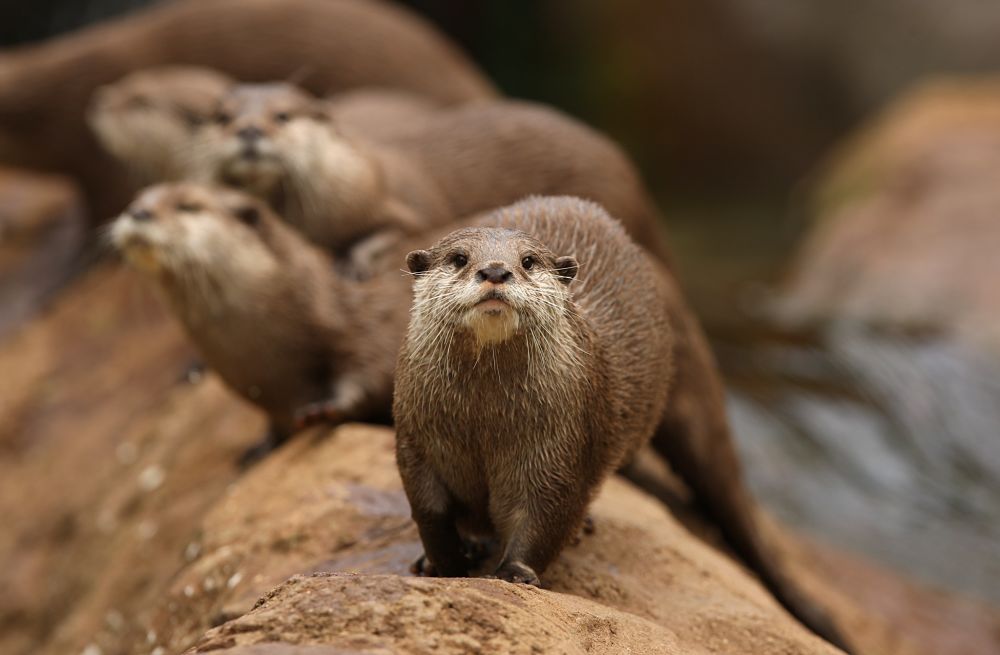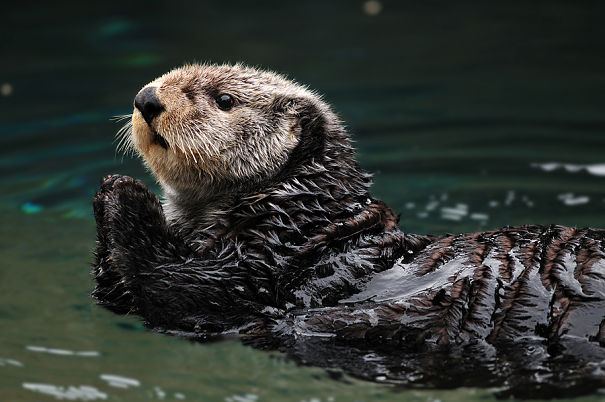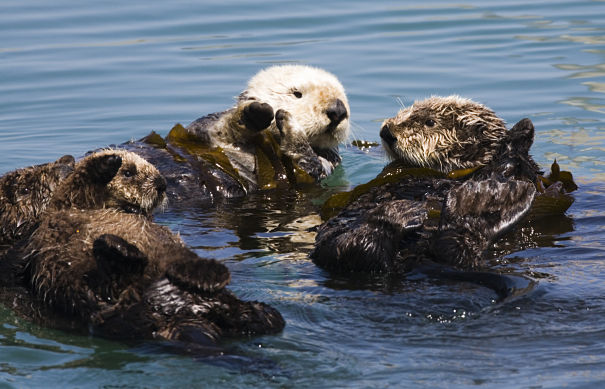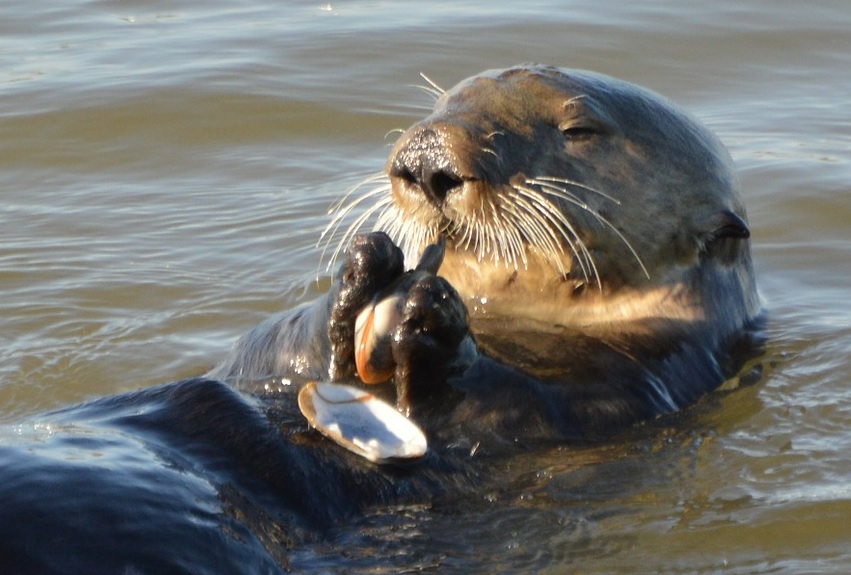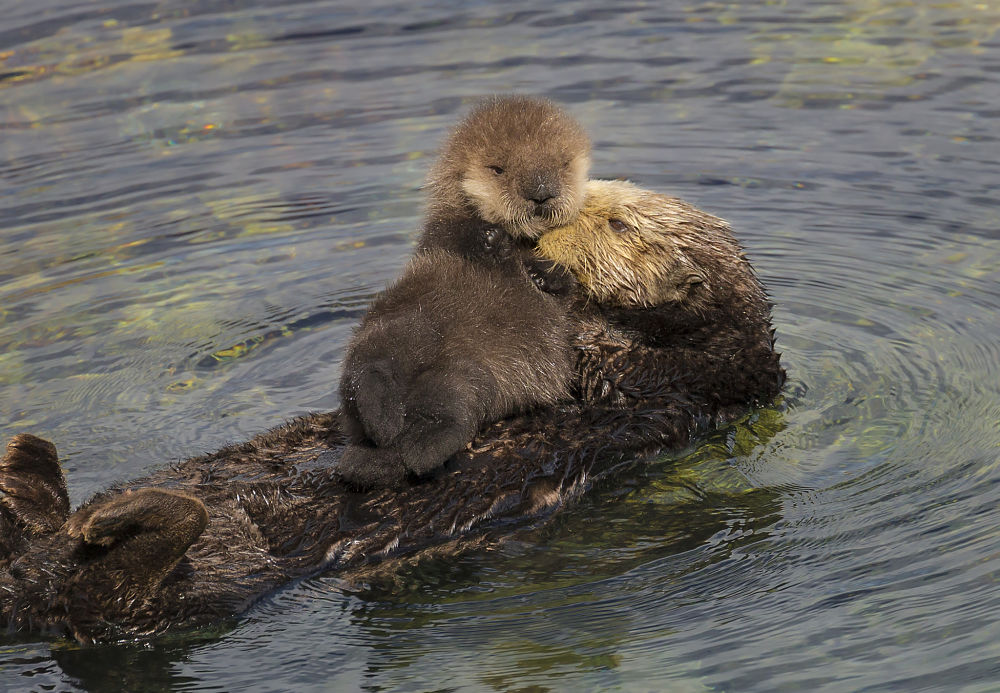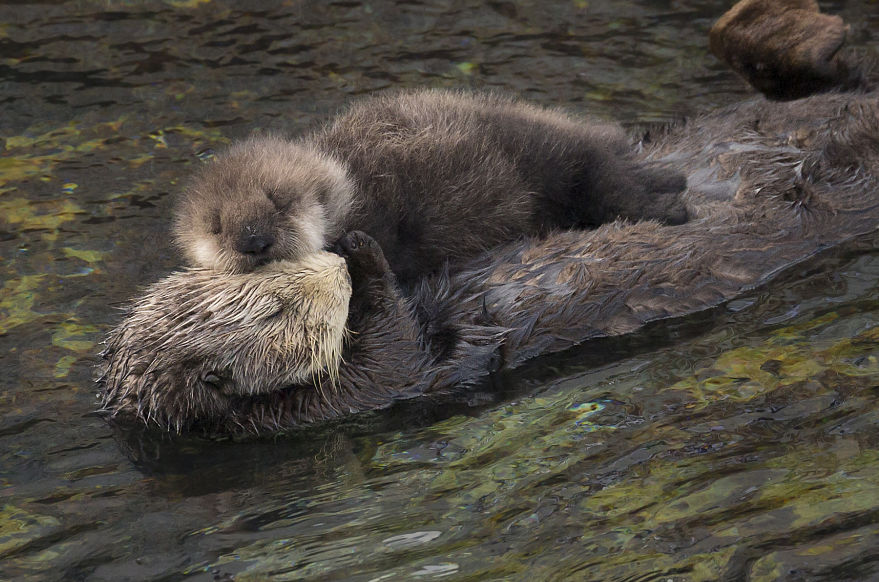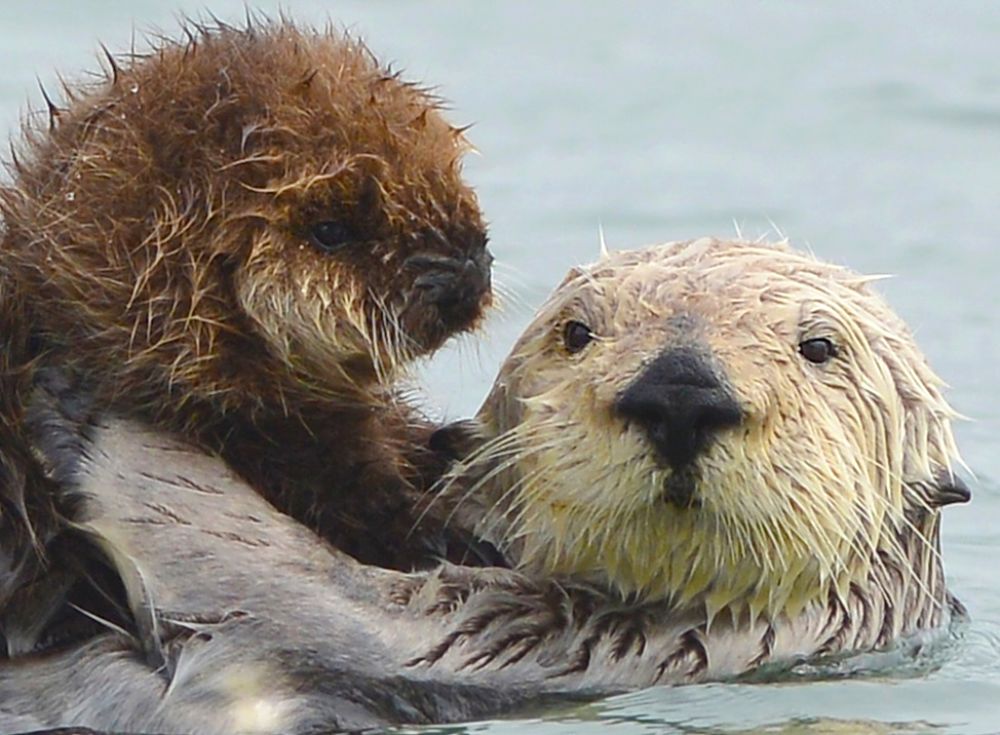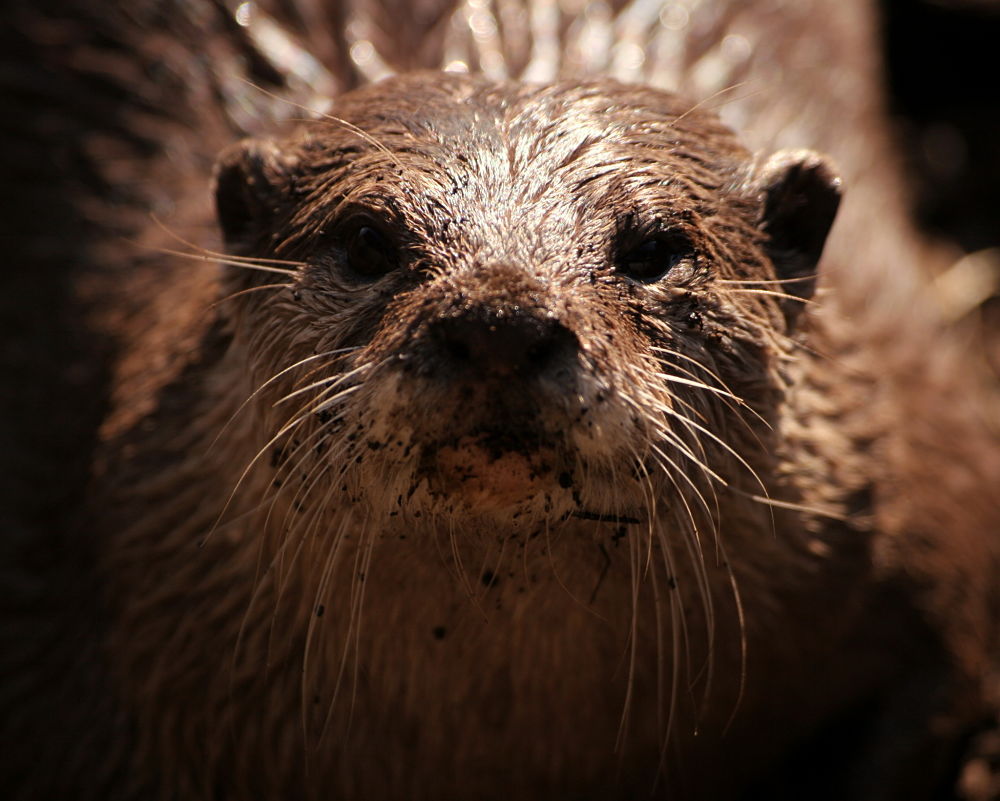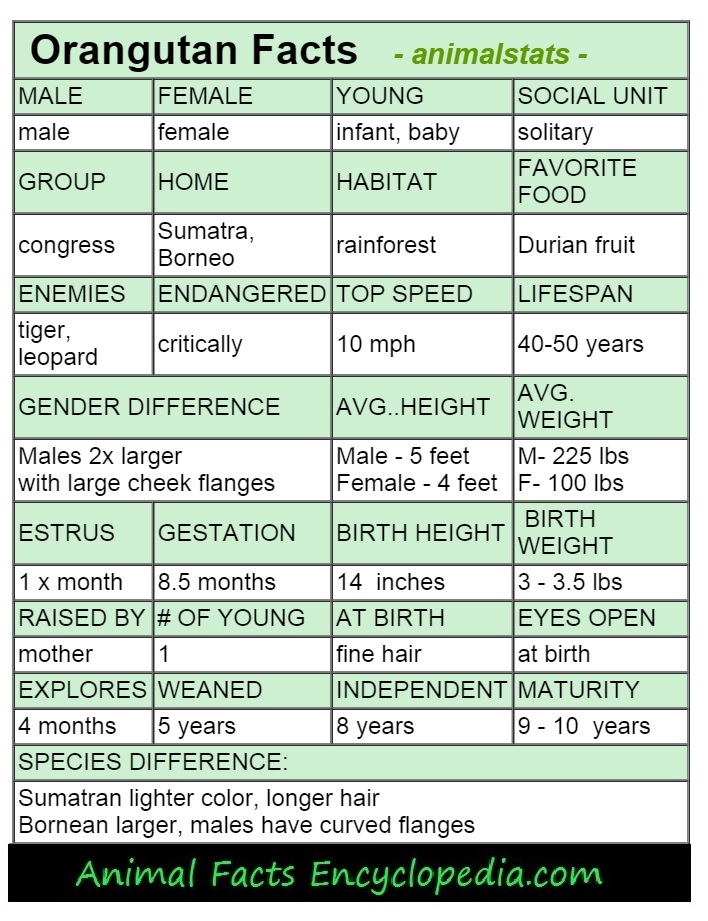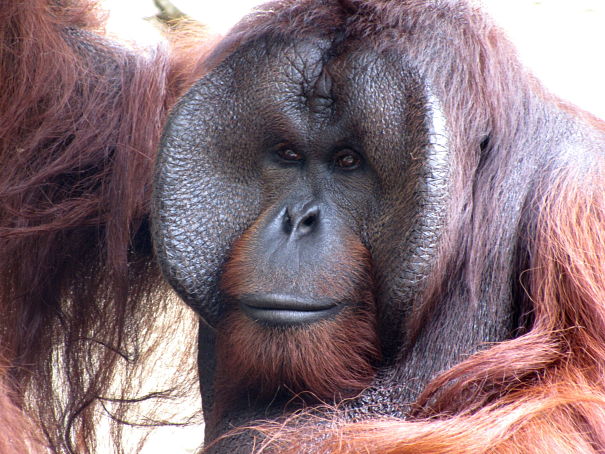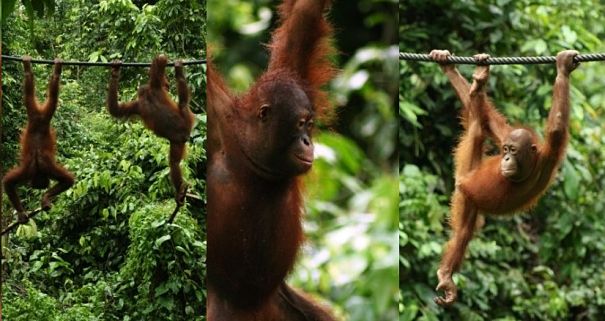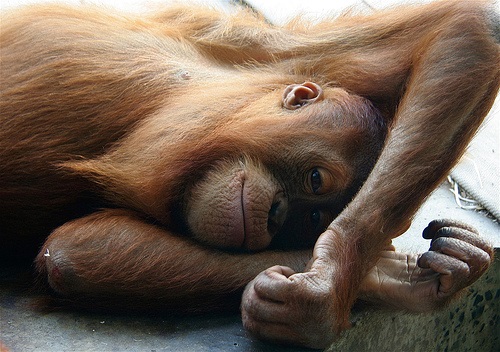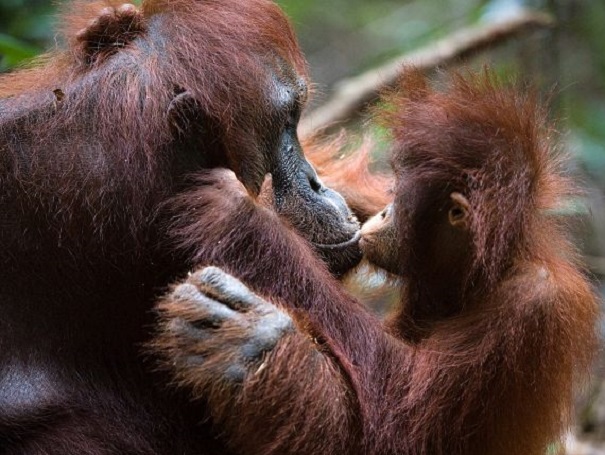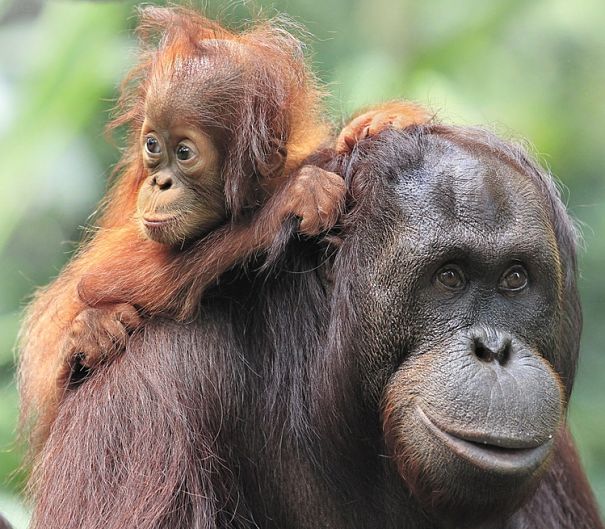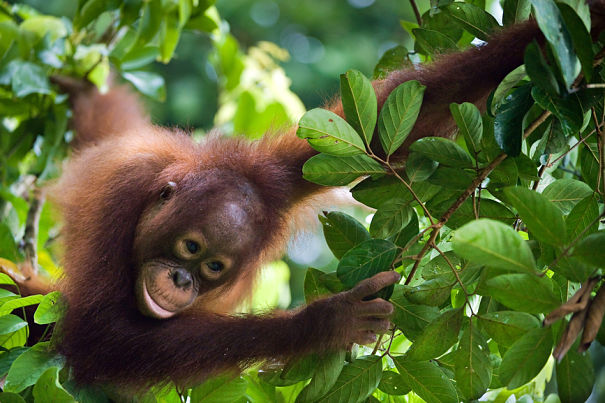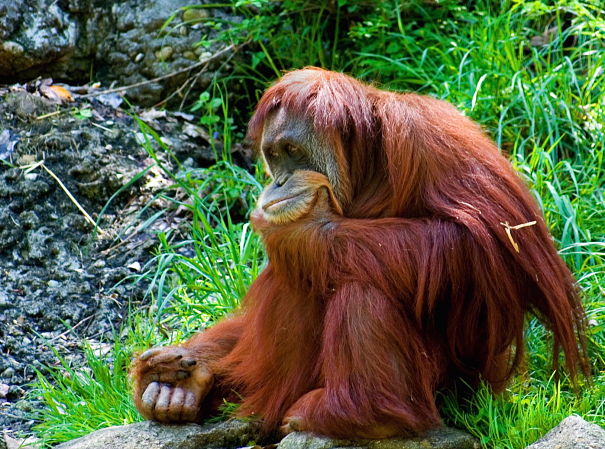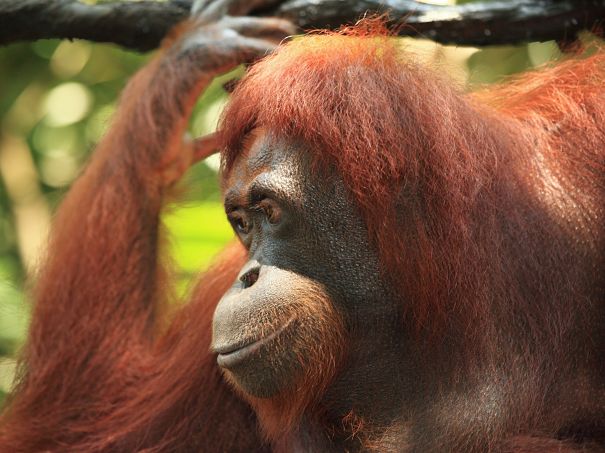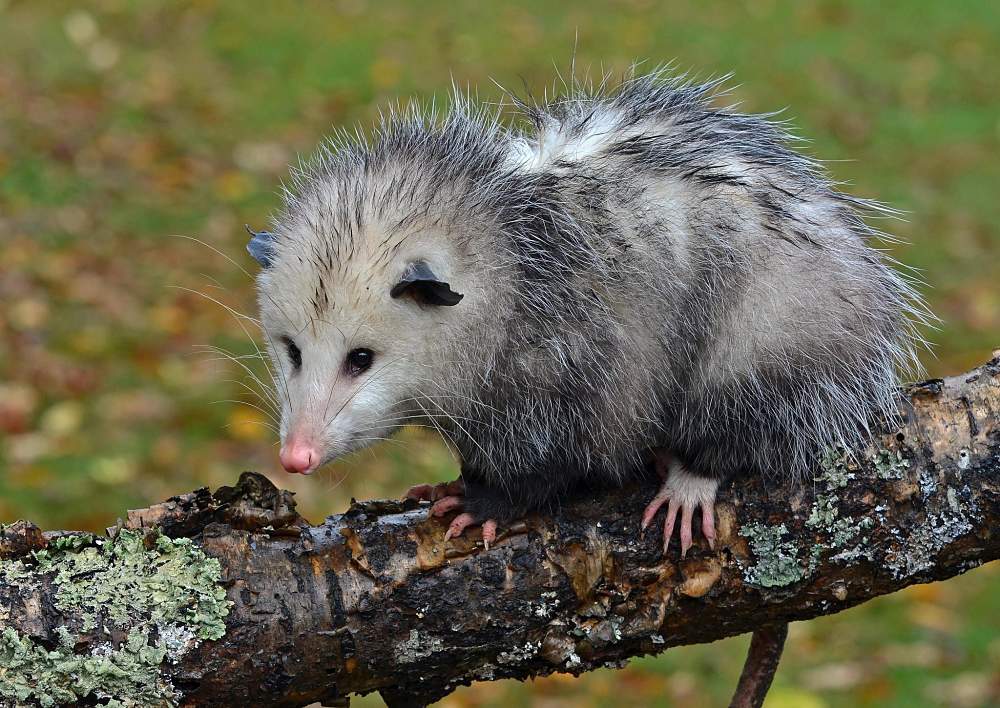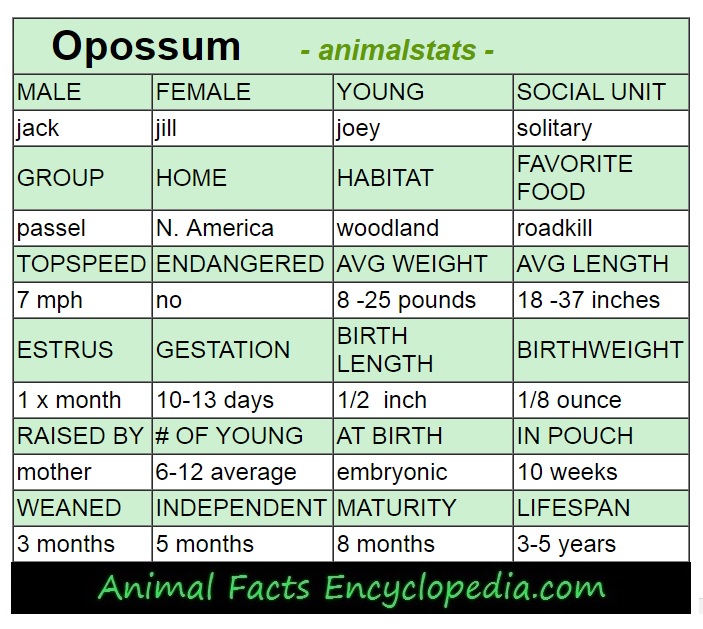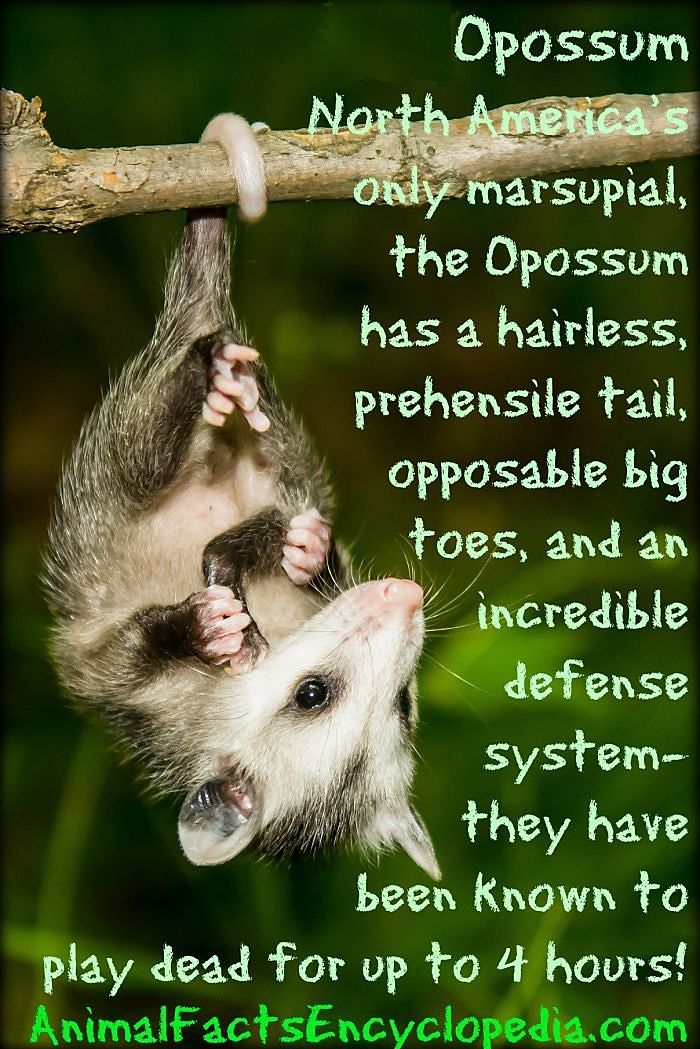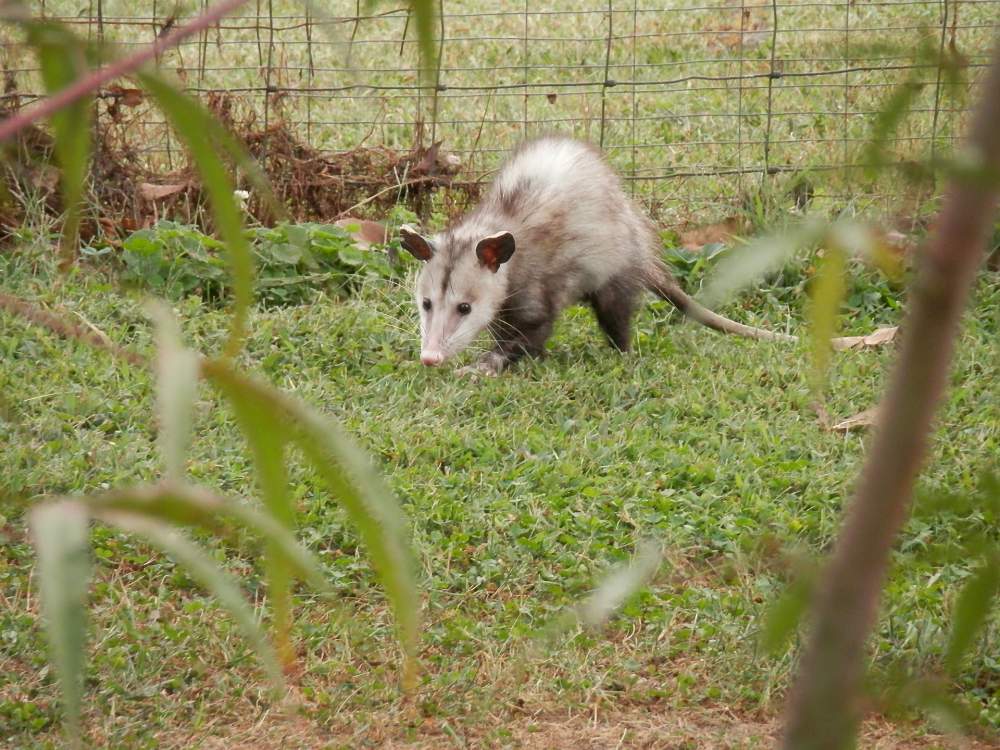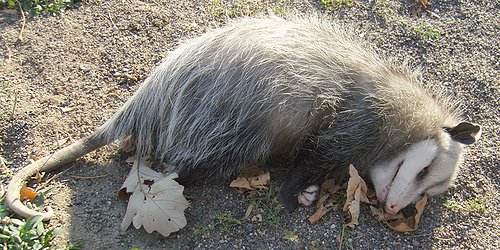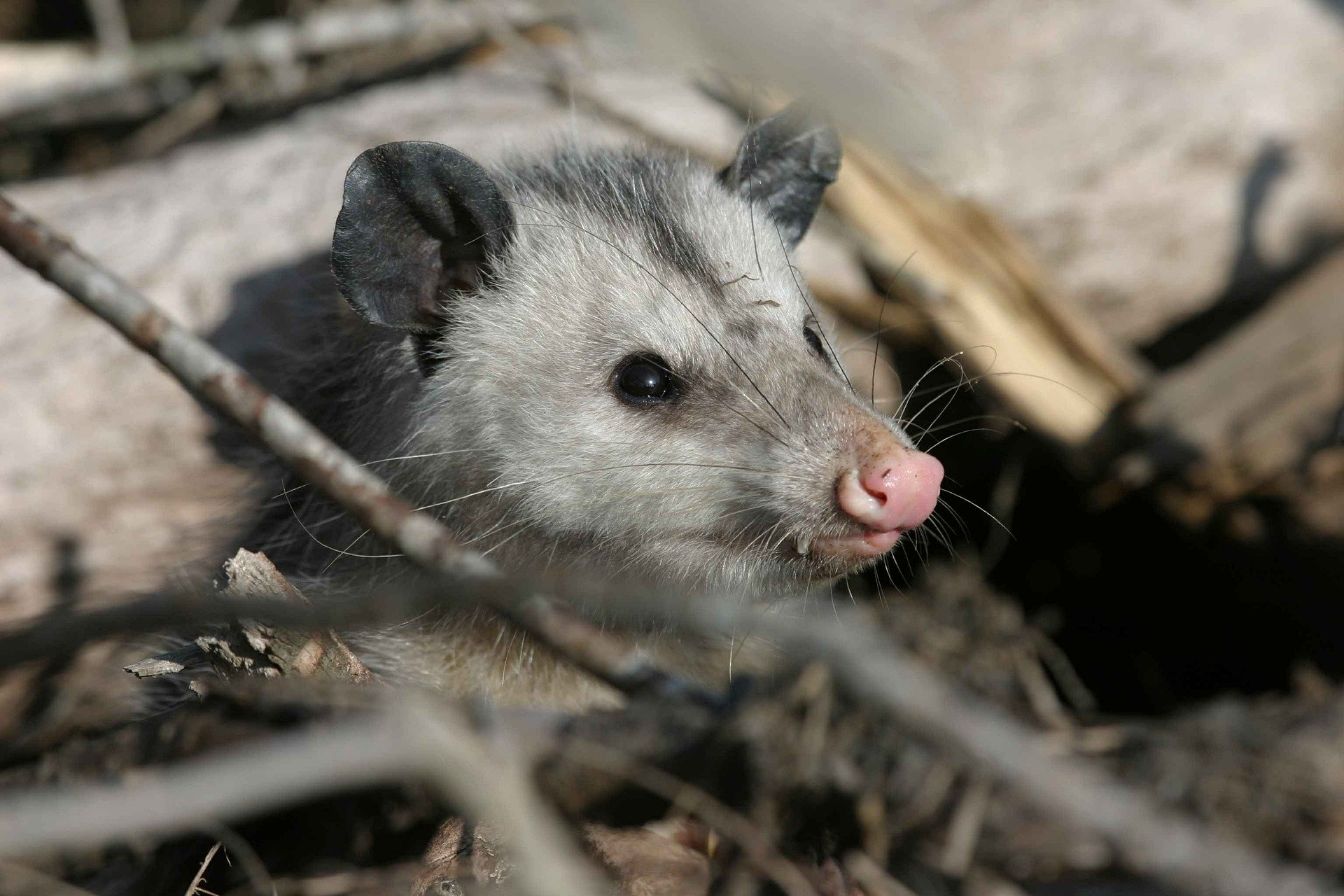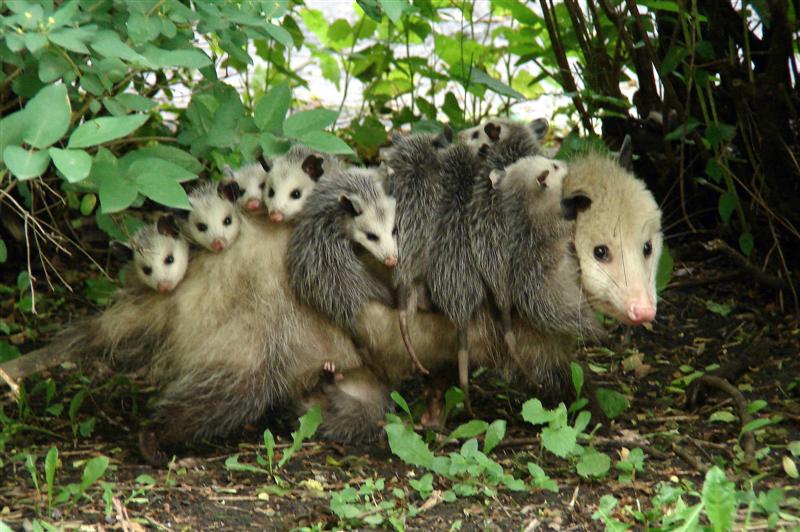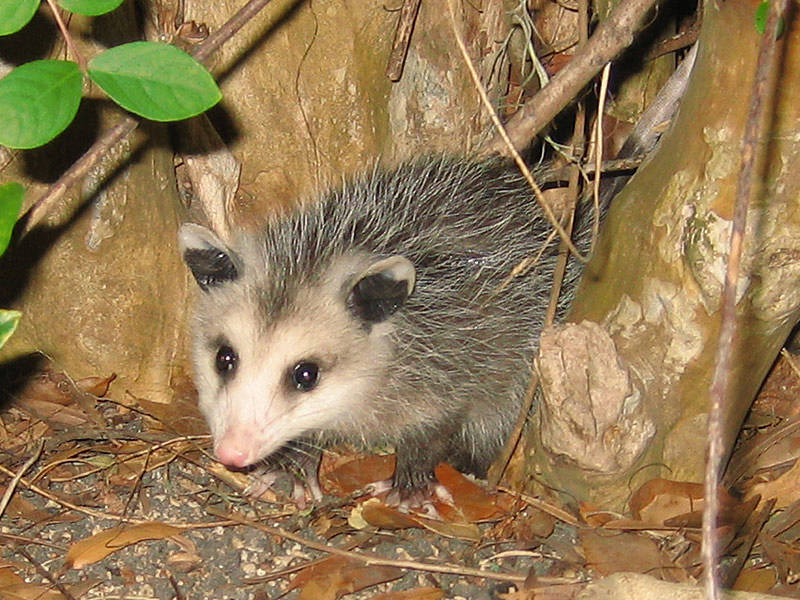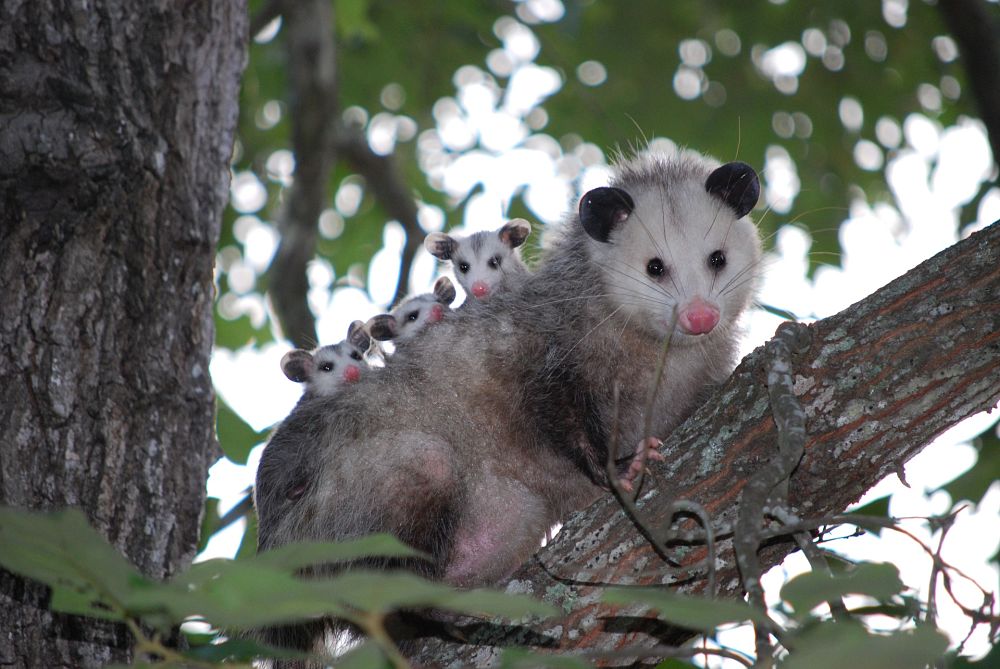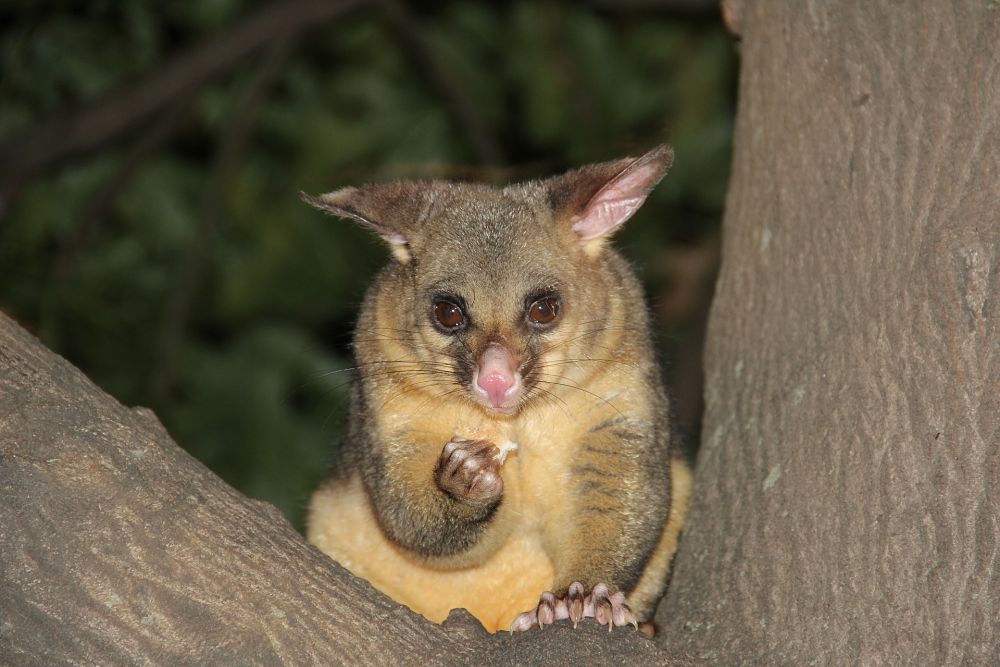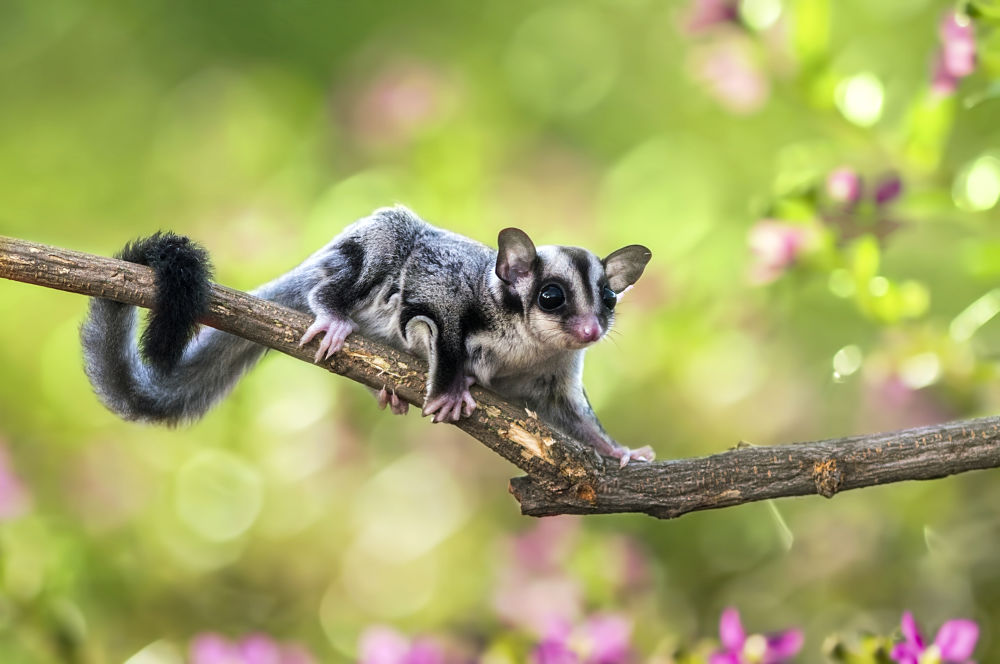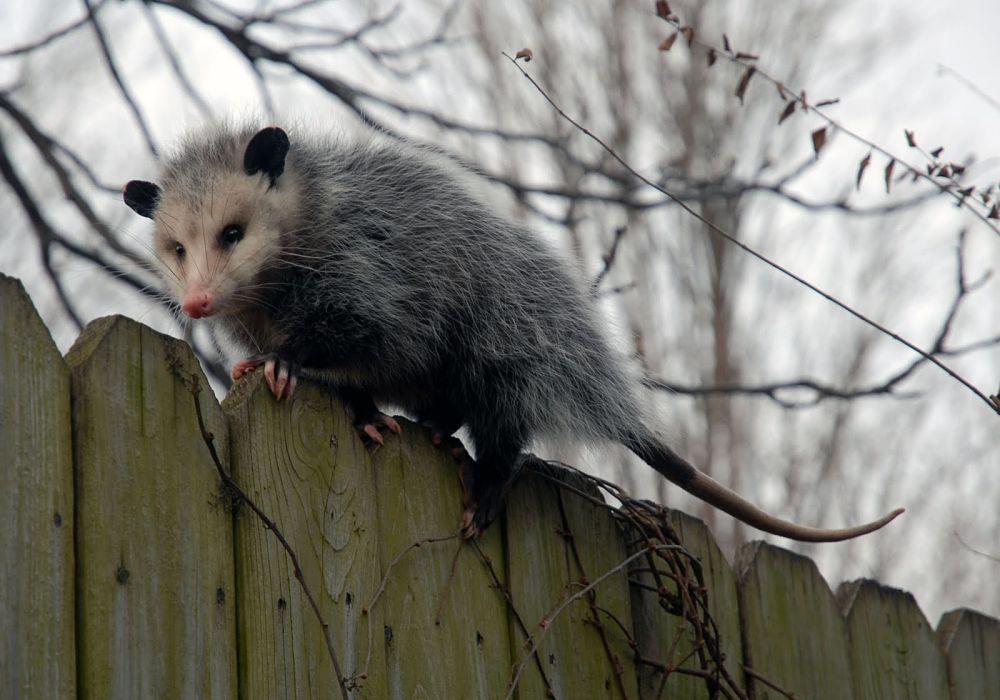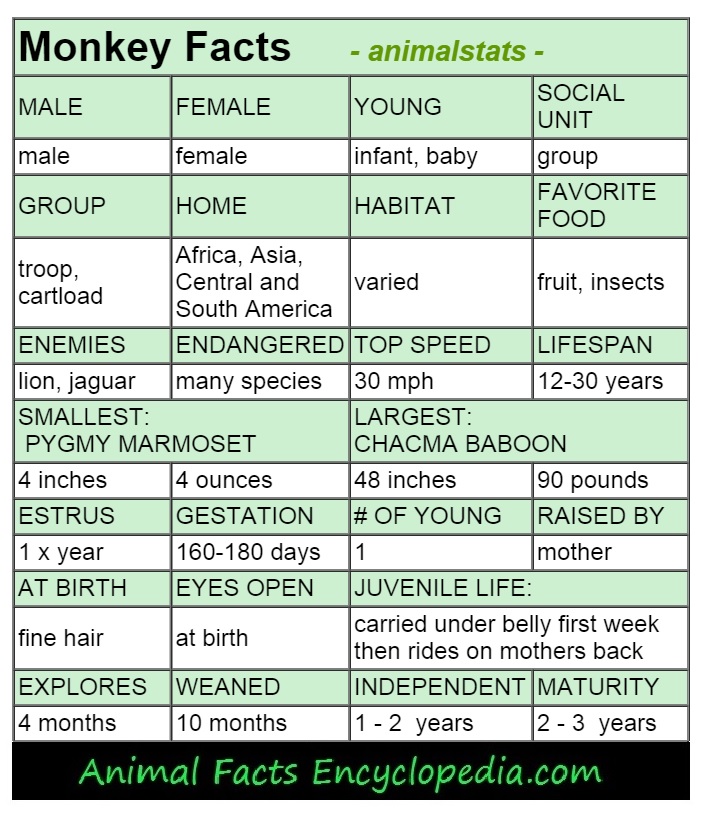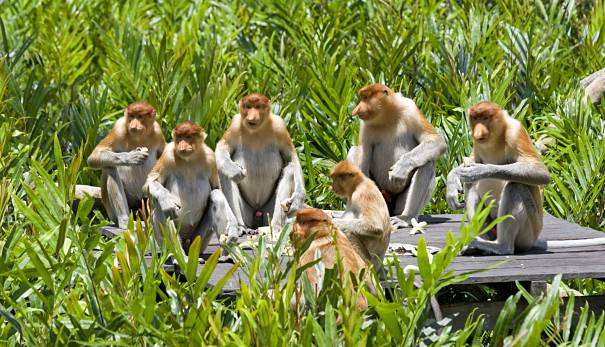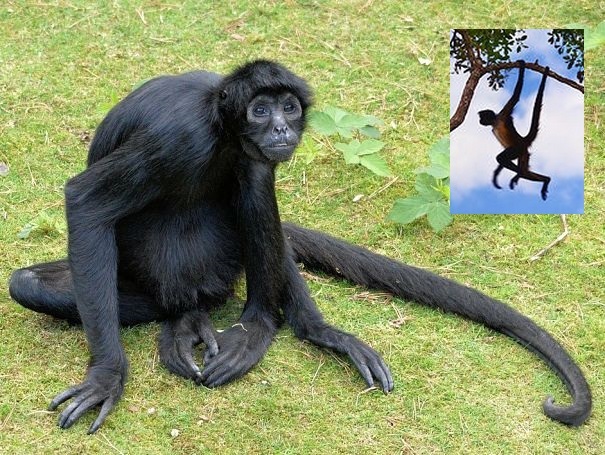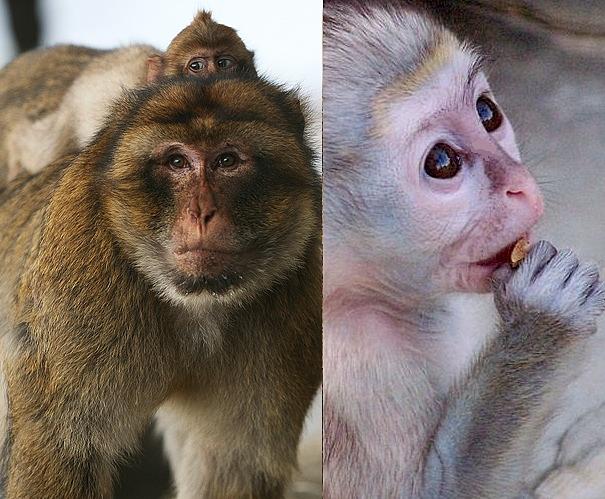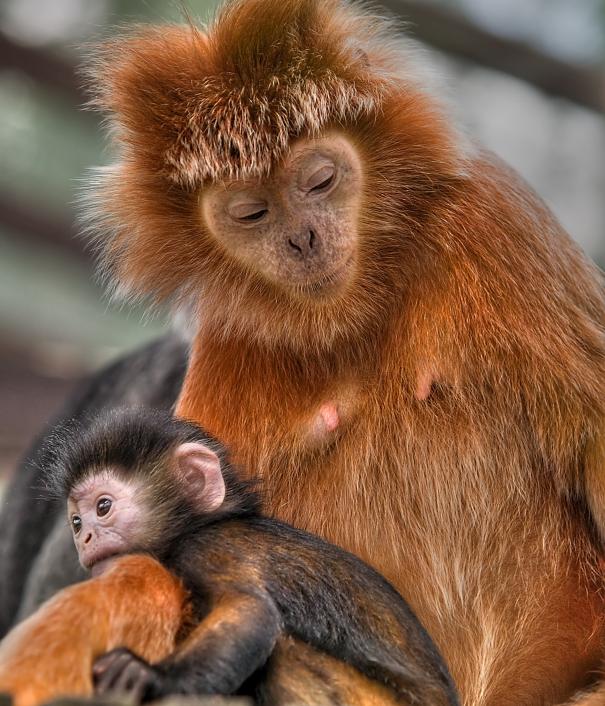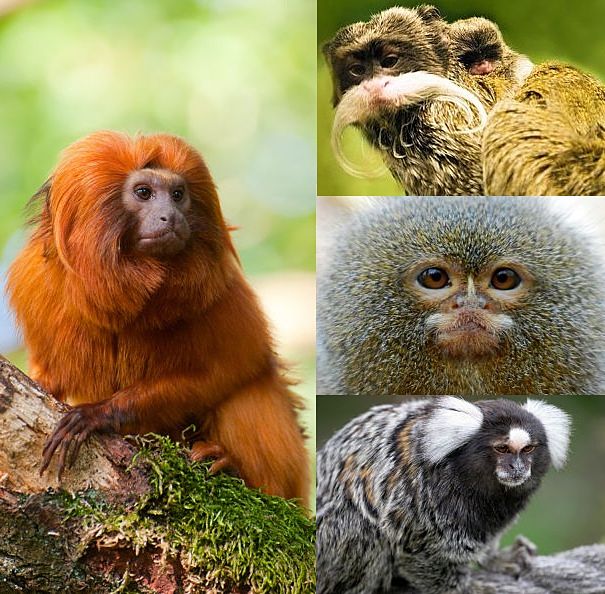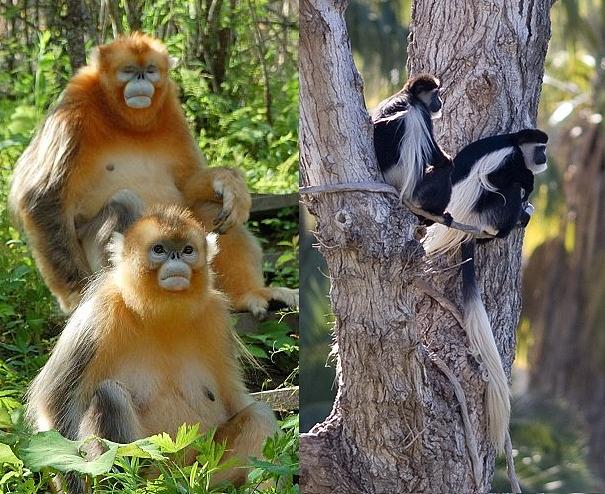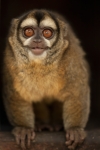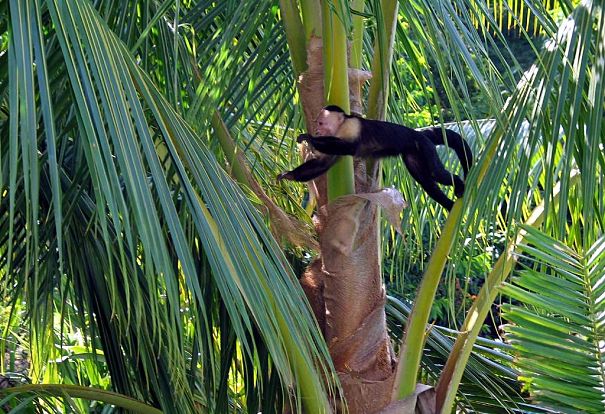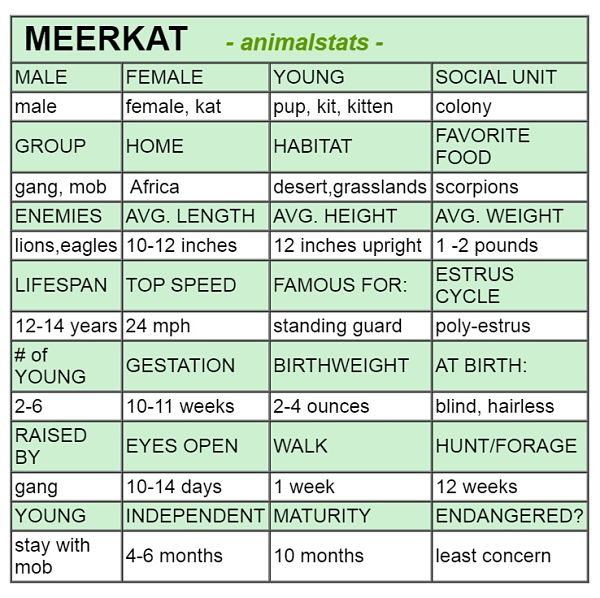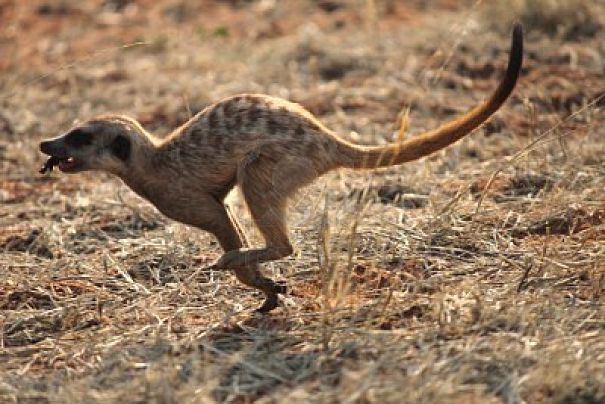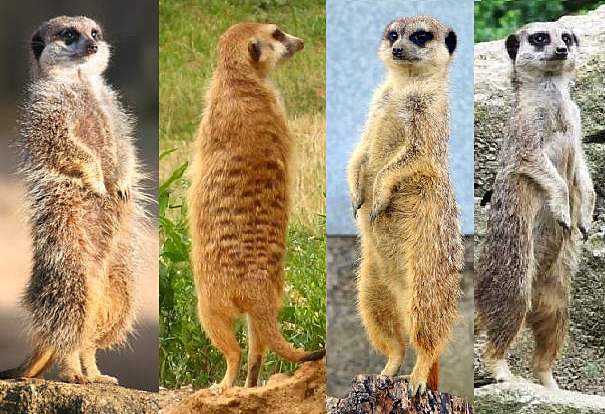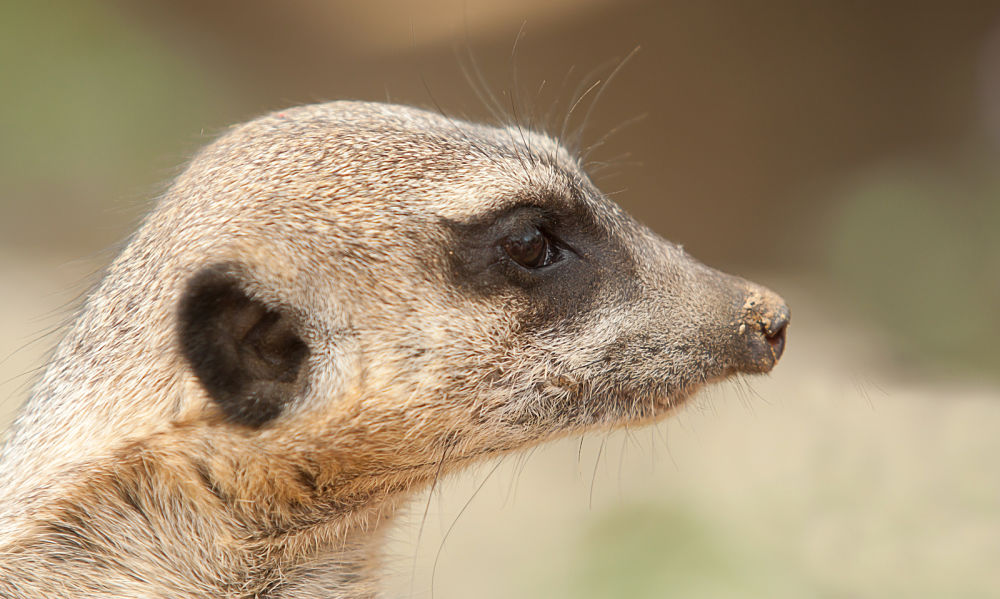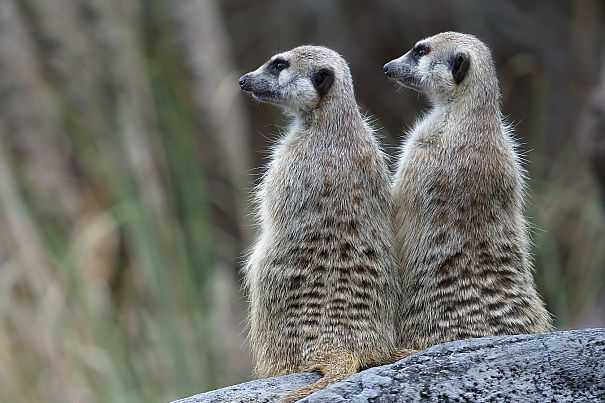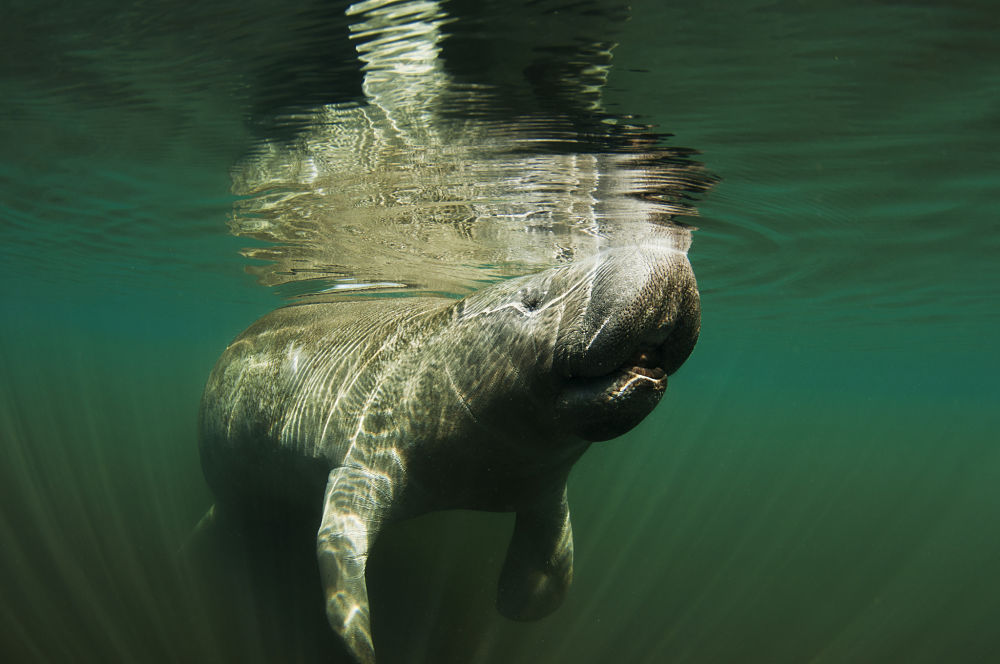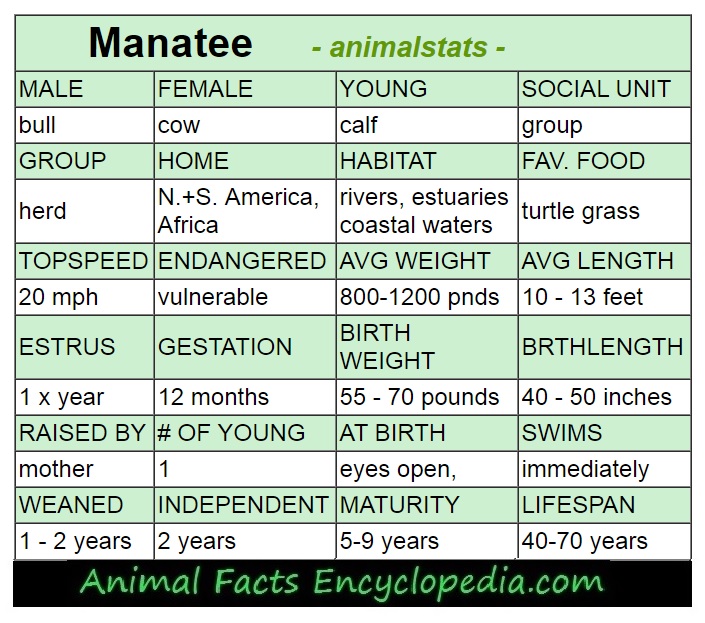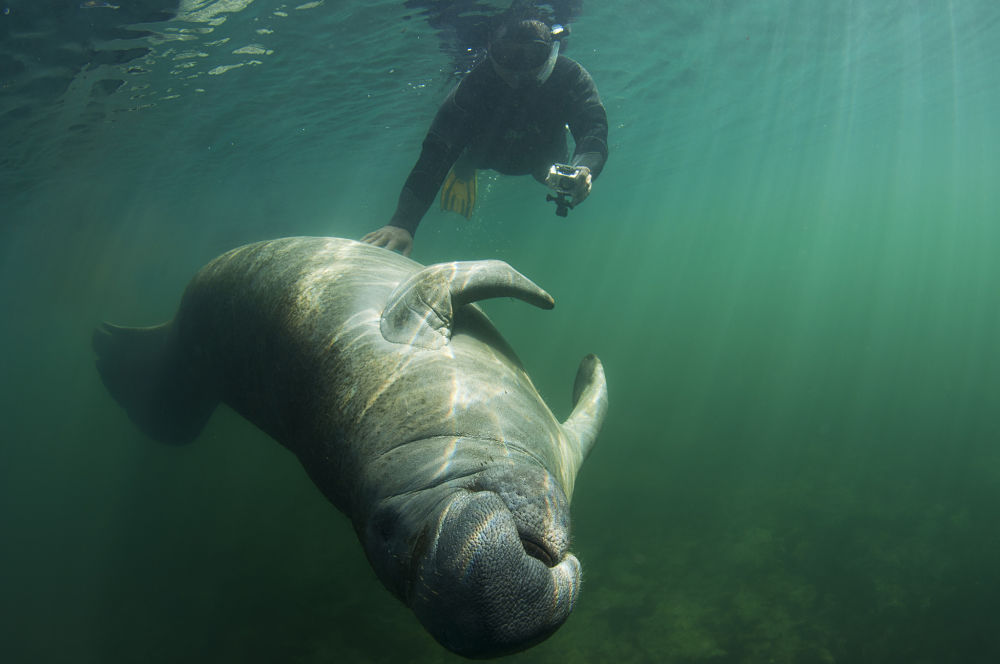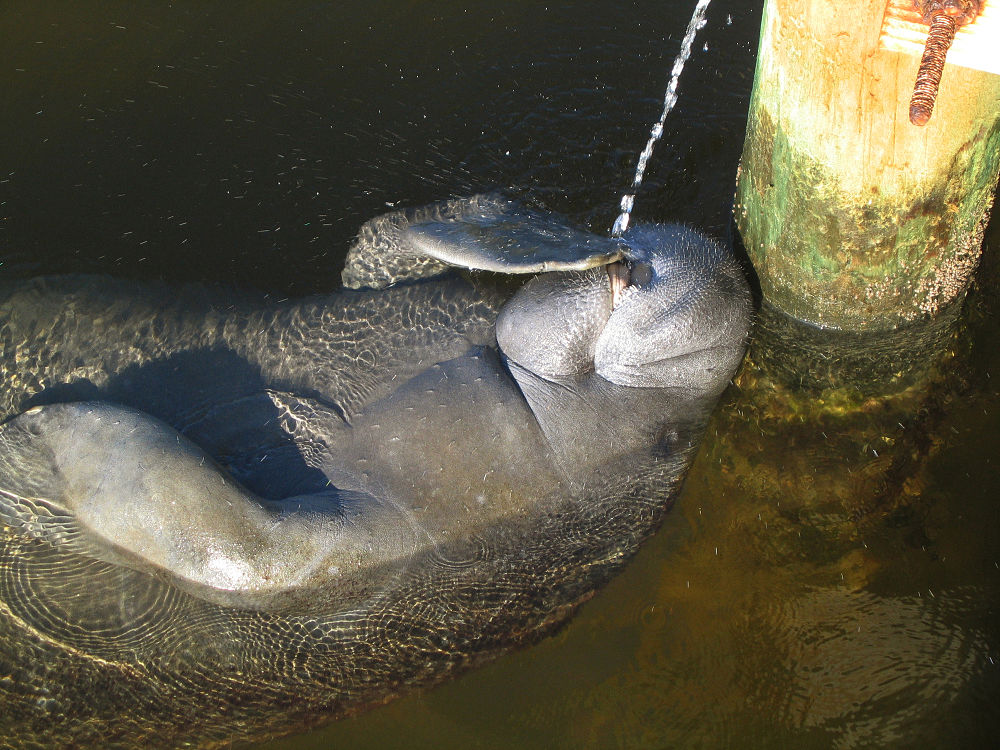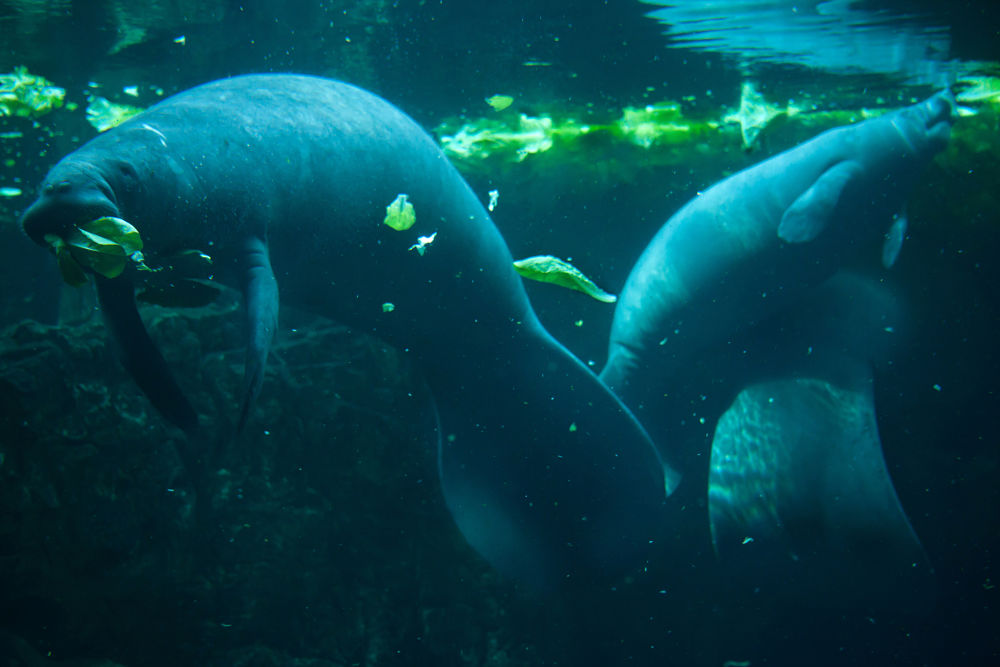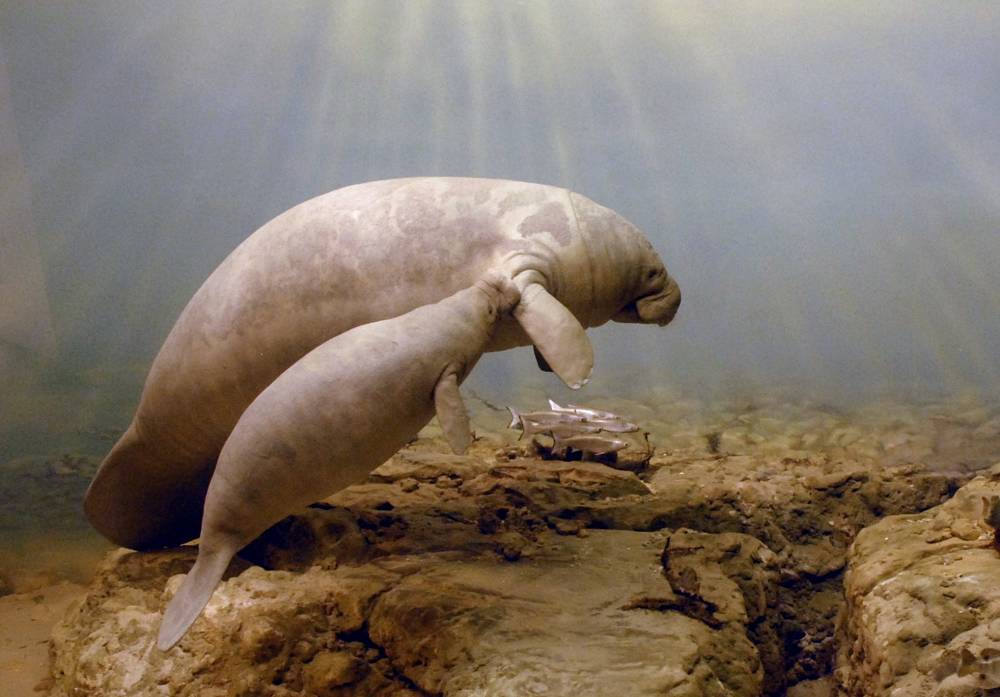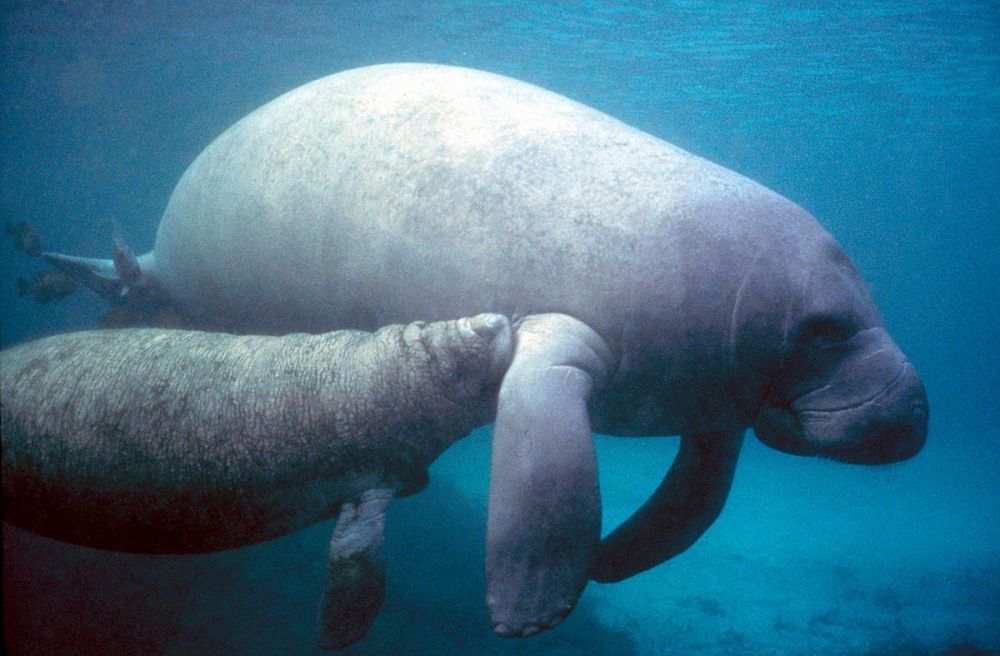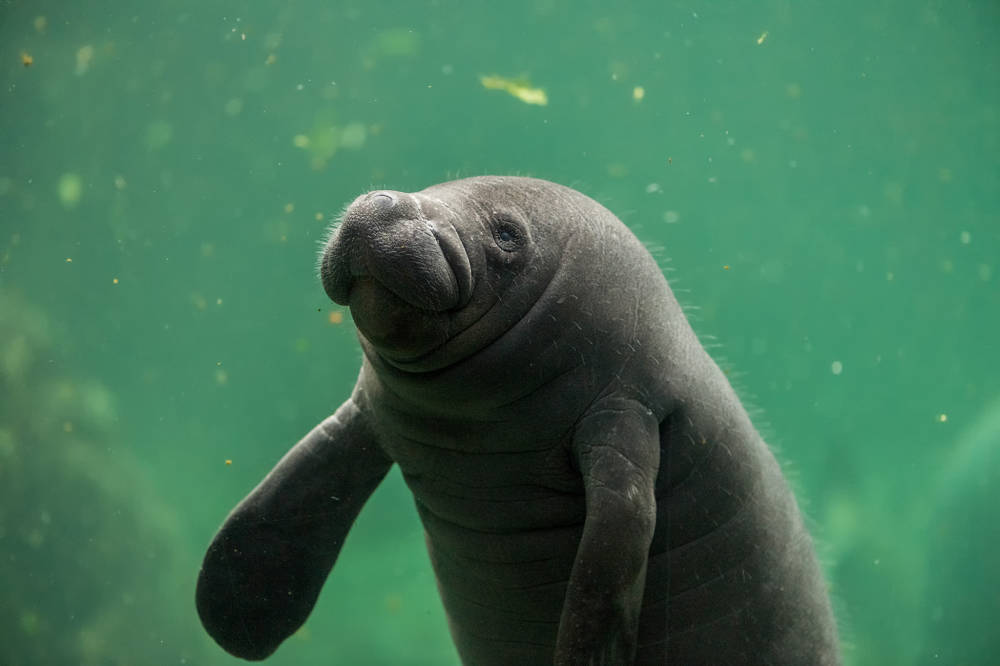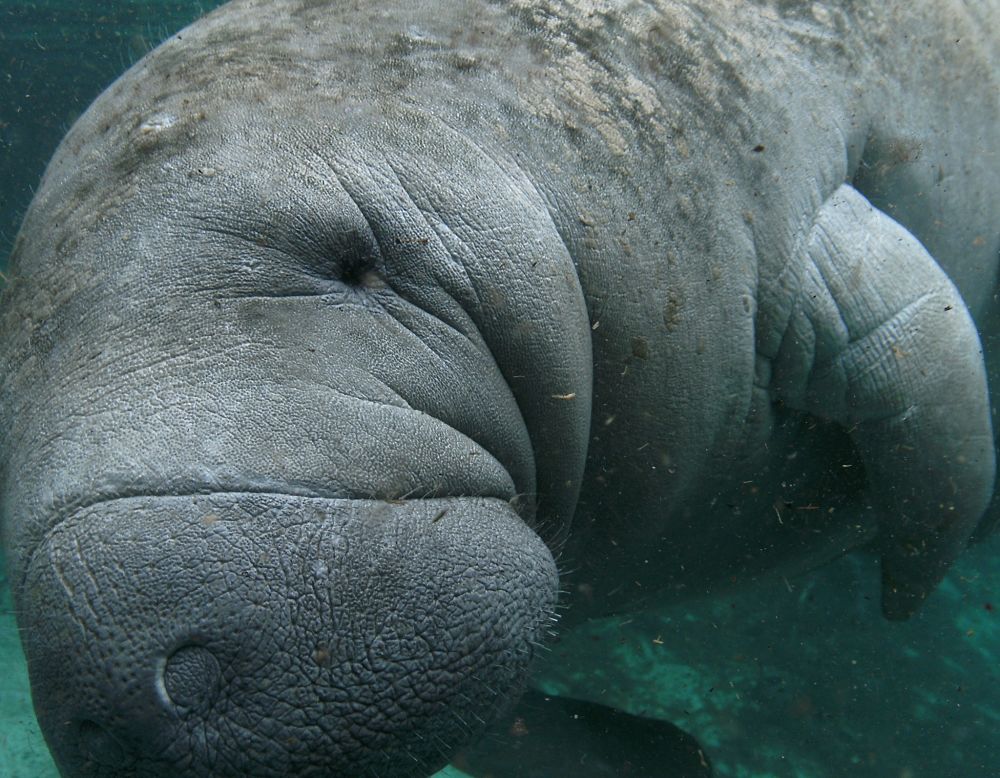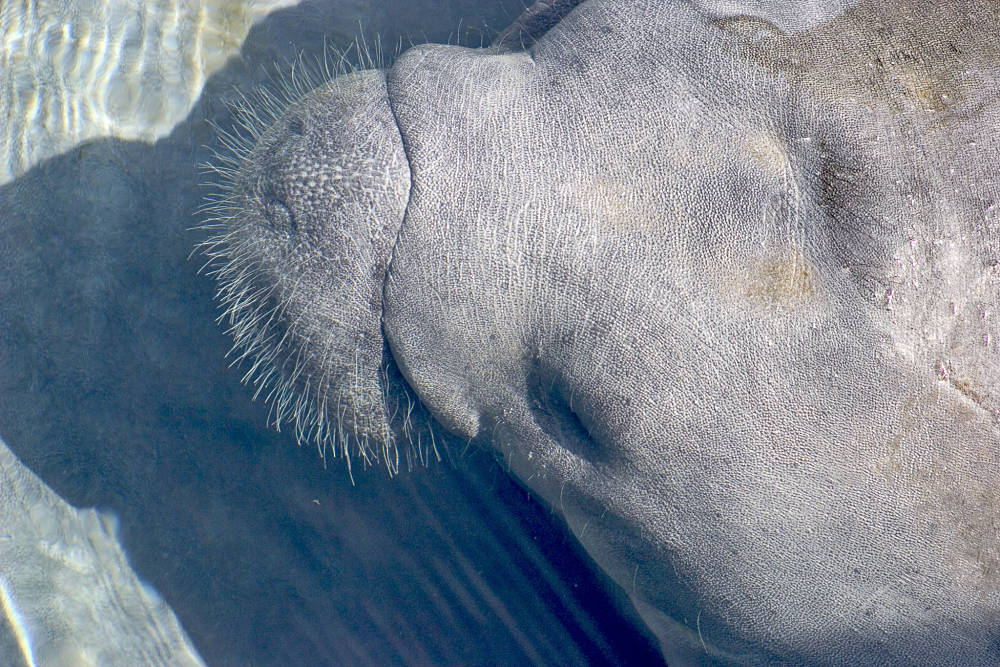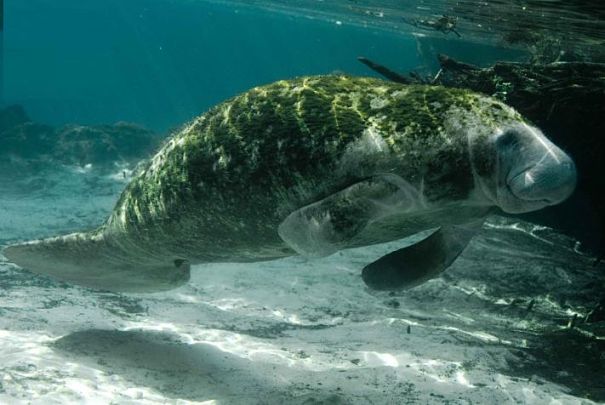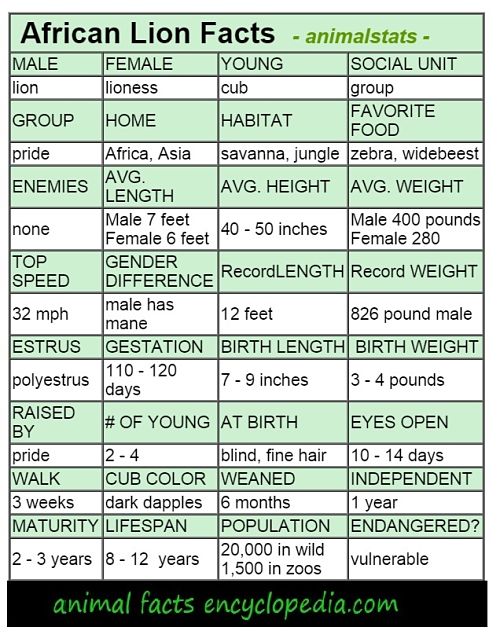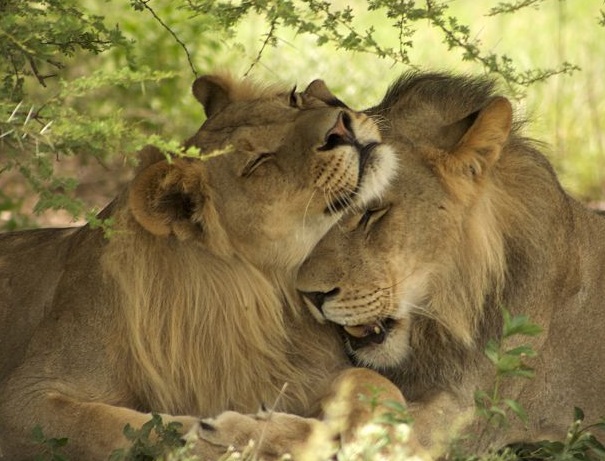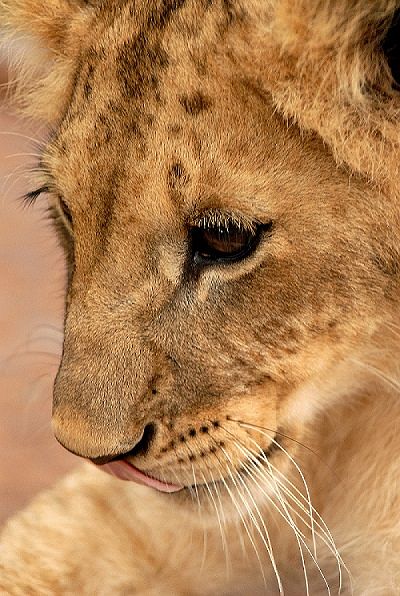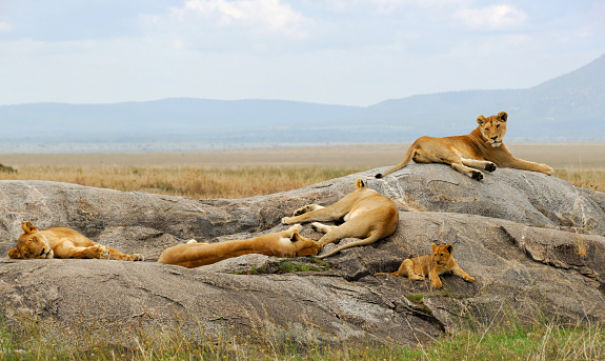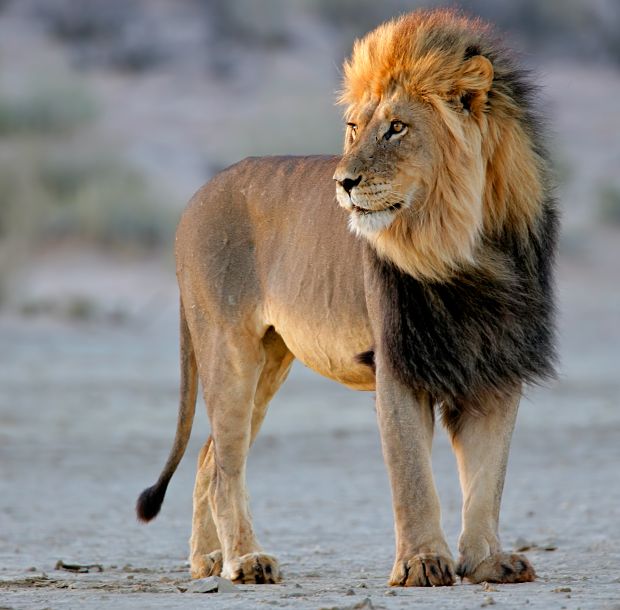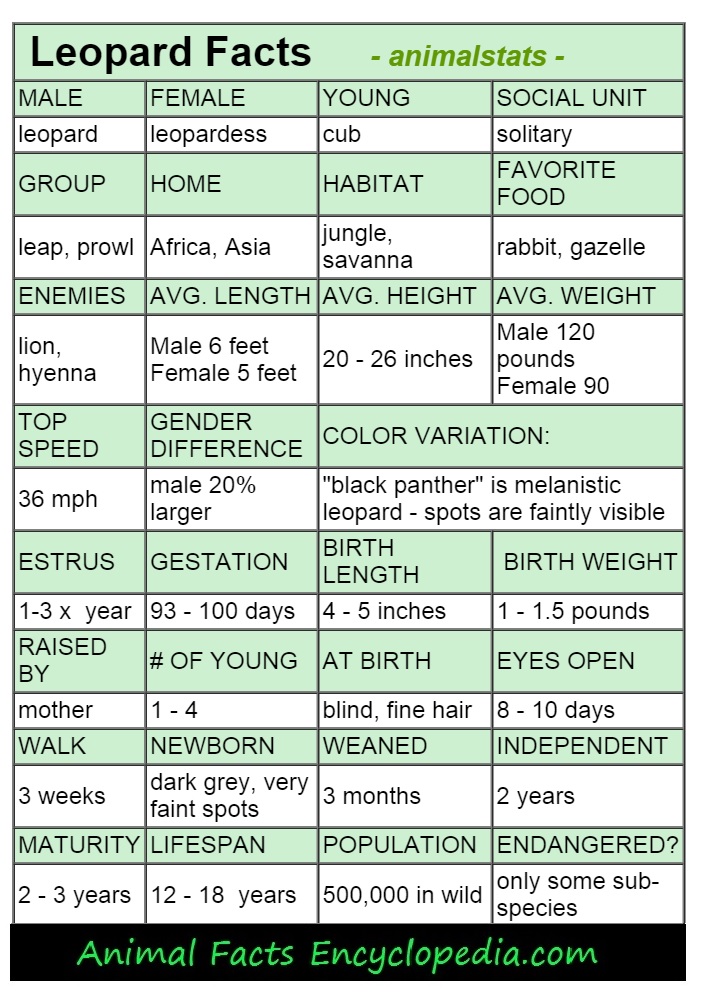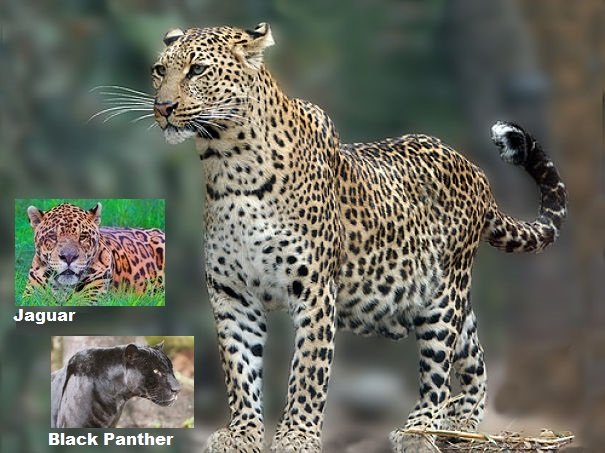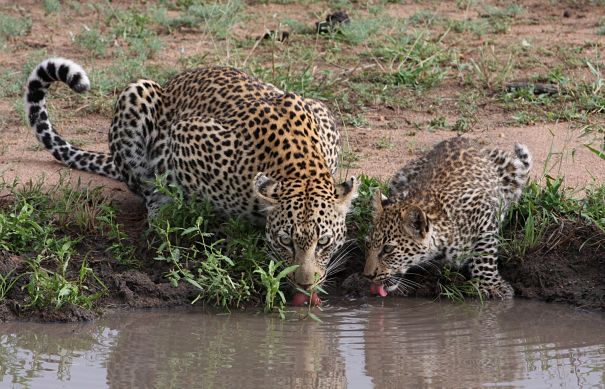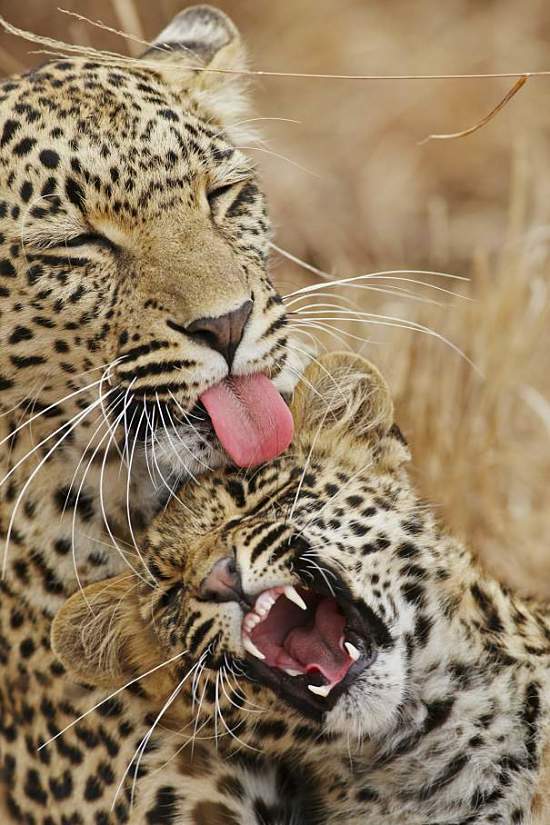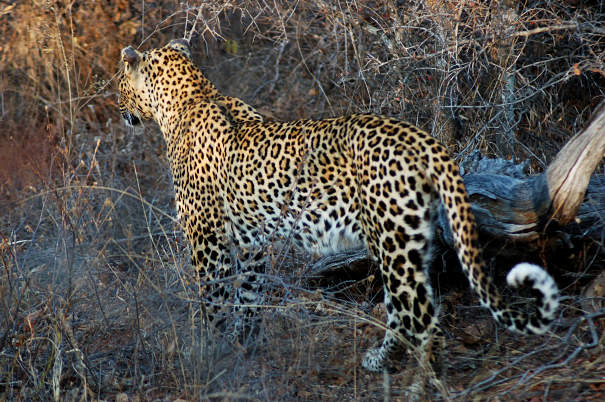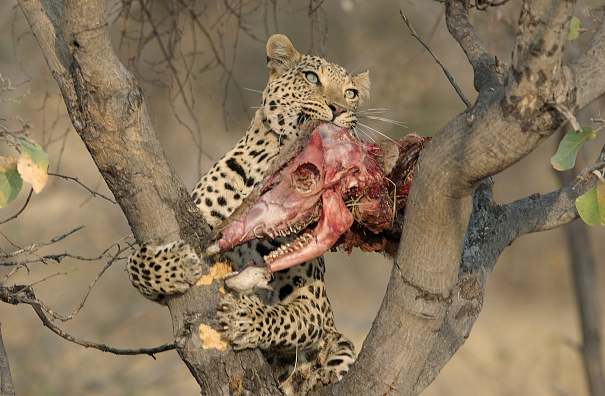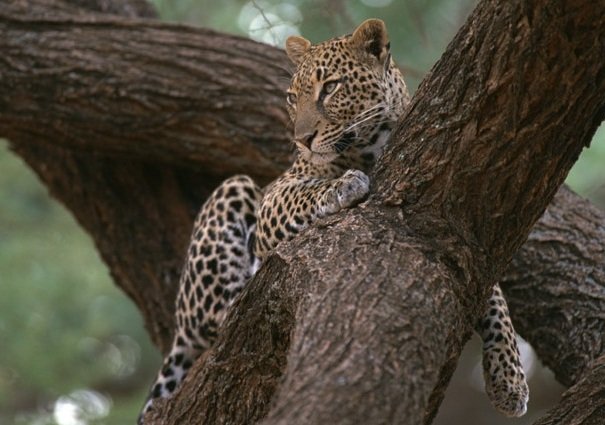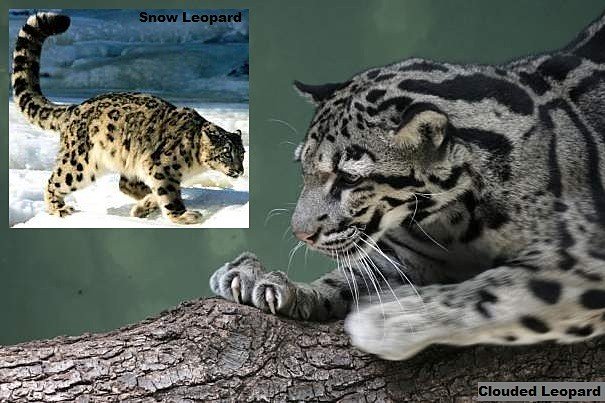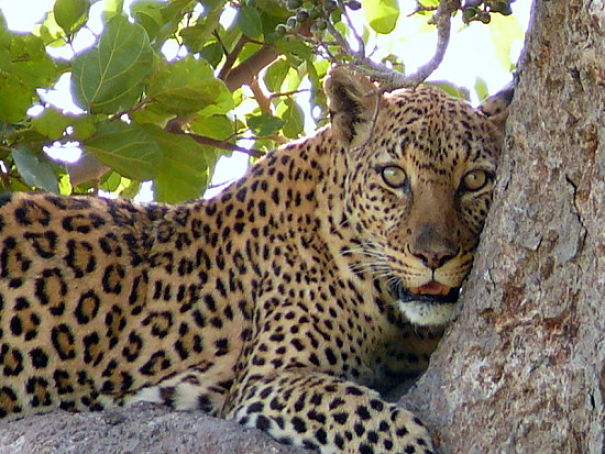Zebra Facts
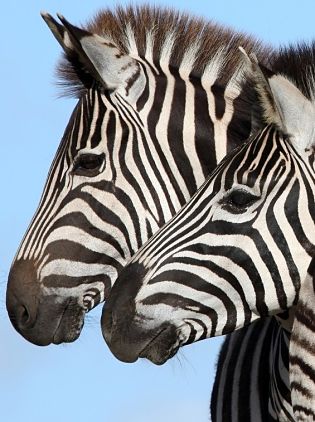
A glorious fixture of the African landscape, the zebra is a very flashy member of the normally mousy-colored horse family. Sporting a robust body of bold stripes, the zebra spends its busy life on the move seeking the best grazing in the mostly dusty world of the African savanna.
Because its skin is dark, many experts suggest that the zebra is a black (sometimes brown) furred animal with white stripes, while others will argue that the zebra has black stripes on a white field, pointing out the animals white undersides.
No matter, the effect is dazzling, and provides this gregarious herd animal with a confusing defense of fluctuating dark and light motion. When a group of zebras rumbles passed a lion, leopard or cheetah, it is virtually impossible for the predator to pick out just one individual target. For the zebra, as is the case with many herd animals, there is great security in numbers.
There are 3 main species of zebra. The most familiar are the plains zebras of which there are 5 subspecies each with slight variations in not only stripe pattern but color as well, some being decidedly brown instead of black. Of these, the Grant's, a hearty animal true, bold black and white stripes that grow wider as they reach the rump, is the classic zebra in type.
Although there are some more populous sub-species, and interbreeding occurs, the Grants remains one of the most iconic sights on the African plains. The mountain zebras consist of 2 subspecies most easily distinguished by the fishbone pattern across the top of the rump. Mountain zebras also have a dewlap - a flap of loose skin at the throat, the function of which is unclear.
Finally, the Grevy's zebra is in its own sub genus and is more donkey-like. It has thinner more numerous, and closely spaced stripes, often brown in color.
All the zebra species are herd animals, highly social and dependent on the camouflaging effect of a mass of striped bodies for survival. Constantly moving, always alert for danger, zebras have surprisingly good eyesight, and it is believed that, despite being monochrome themselves, they actually see the world around them in full color. - Zebra Facts
Why Does A Zebra Have Stripes?
Even at the edge of a watering hole there is danger, but zebras love a crowd. The herd instinct draws them together, the exquisite skin often keeps them in one piece in more ways than one.
Imagine a crouching lion or hidden crocodile trying to select just one target in a dazzling sea of stripes. For well-camouflaged animals such as the zebra, it is more often movement and not the outline of a form that attracts the predator to an individual. A stilted gait, the bobbing head that comes with a lame leg, a stumble, a hesitation, the curtain of healthy companions rush away and the target is revealed.
But despite being every bodies favorite meal, the plains zebra is an extraordinarily successful animal, and though nature channels are rife with scenes of tragic endings, the majority of zebras lead long lives of 15 to 20 years. Even with territories dwindling as human-kind encroaches, the plains zebra herds are over 3/4 of a million animals strong. - Zebra Facts
Zebra Reproduction
The very social zebra requires the safety and comfort of a herd to survive. Two types of zebra herds exist, one being made up of a "harem" of females and their foals escorted by 1 stallion, the other being a "bachelor herd" of males who are either too young, too old, or too timid to gather a harem of their own.
Stallions are males at least 5 years of age who have fought with other males for the right to accompany and mate with the females in the harem. The females have a hierarchy and will often walk in line in the order in which they joined the group.
The senior mare will make most of the decisions for the herd, leading them to pastures and watering holes. The stallion will bring up the rear or patrol the flanks on the lookout for predators and other males who might steal his mares away.
Pregnancy lasts for a year and the newborn struggles to its feet in a matter of minutes. The skull of a newborn zebra is less than 1/2 the length of its mothers, but the babies legs are 95% the length of hers.
Speed really matters in the perilous world of a baby zebra and within moments of birth the infant is on its feet and ready to run, keeping to the center of the herd as much as possible and dodging the large hungry jaws of cheetahs, hyenas, lions and crocodiles on a daily basis. The mother does the parenting and will nurse the foal for up to 18 months.
Young males will leave the herd at between 1 and 2 years of age to join a herd of bachelors. Likewise, young females will leave when they come into their first estrus joining with a new dominant male who has chased away all suitors.
Because both the males and the females leave their original herd, the harems that are formed are actually groups of unrelated females who form strong bonds and live together as a family, usually their entire adult lives. - Zebra Facts
Fight Club And The "Super Herd"
In some regions where populations are large, the plains zebras social structure can be rather complex.
Multiple stallions with their harems and youngsters in tow, will come together to form a "super herd" of up to 300 individuals. When a bachelor herd approaches a "super herd" the stallions greet them as a unit and work together to fight them off.
When the battles are over the stallions will return to their own harems. Within the "super herd" the harem structure remains intact with each mare remaining devoted to only her stallion, and each stallion keeping to his own mares. - Zebra Facts
Zebra Identification Guide - A Tale Of Some Tushies
Look to the rear when trying to identify a zebra species or subspecies.
Our first example is the broad black stripes of the famous Grant's zebra (the rare Selous zebra is similar).
Second: The 2-toned "shadow" stripes, and sometimes stripe- less legs of the Burchell's. (the Chapman's and Crawshay's zebras are similar)
Third: The Grevy's has narrow, close-set, often brown lines, a prominent dorsal stripe with white outline and plush dark dorsal hair. The stripes do not go under the belly.
Fourth: The "fish bone", or "gridiron" pattern across the top of the rump of the mountain zebra. The mountain zebra tends to have the biggest variation in stripe width across the body (see small inset photo) with narrow, close-set stripes on the ribs changing abruptly to broad, wide-set stripes on the sides of the buttocks. Stripes do not go under the belly. Without a top view you can usually still identify the mountain zebra from the side- look for the tips of the fish bones! -Zebra Fact
Which Zebra Is This?
Grant's Zebra
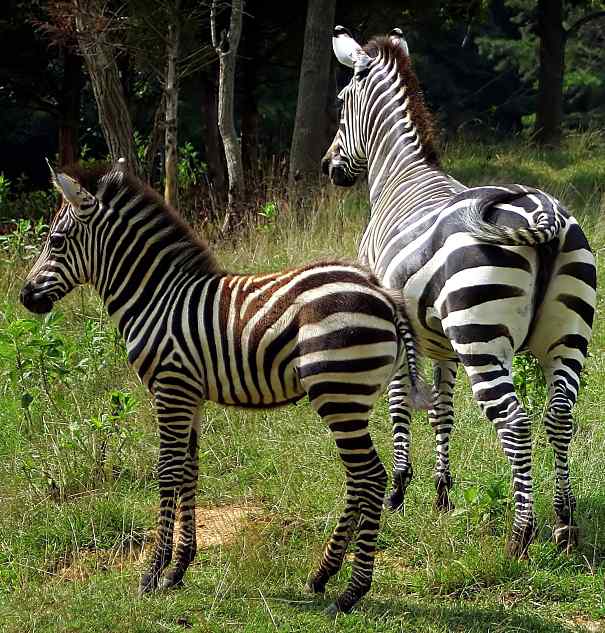 Beefy build, thick neck, big, broad, black stripes it is the Grant's zebra. A mother and baby Grant's zebra in glorious black and white! Just look at the length of that foals legs - baby you were born to run!.
Beefy build, thick neck, big, broad, black stripes it is the Grant's zebra. A mother and baby Grant's zebra in glorious black and white! Just look at the length of that foals legs - baby you were born to run!.


Burchell's Zebra
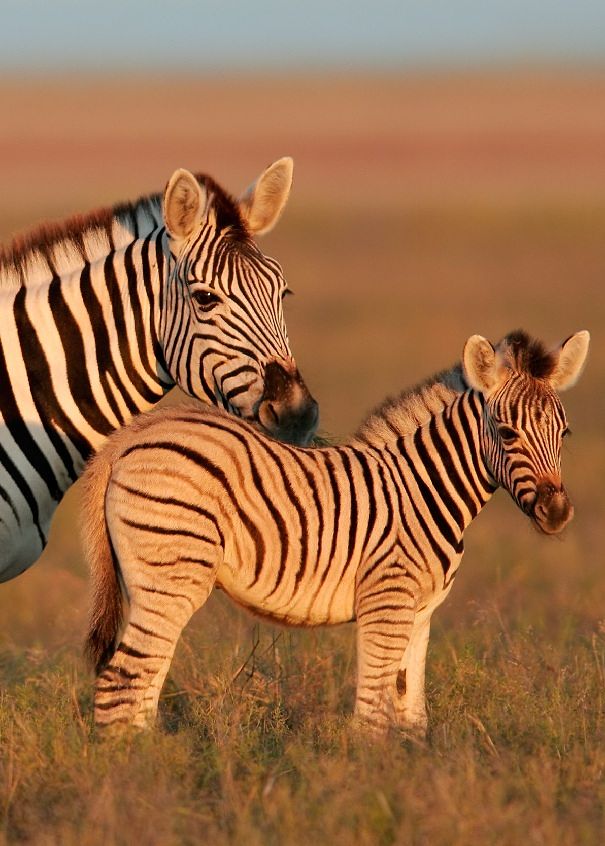
If the zebra has the Grant's sturdy build, but thinner two-toned stripes it is one of three subspecies. The Burchell's zebra, the Chapman's zebra and the Crawshay's zebras occasionally inter-breed and make positive identification tricky, but of the three, the Burchell's is the most common. In fact, the Burchell's is the most populous of all the zebra species. This is most likely a Burchell's zebra mare and foal. - Zebra Facts!
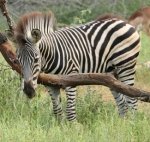
A Few More Zebra Facts
- Contrary to some claims, zebras, like all other equines, identify each other by smell and vocalization, not by their stripes.
- The zebras stripes make it more difficult for predators to target one individual out of the herd.
- Albino zebras occasionally occur in the wild. Often called "golden zebras" they are not true albinos, but have pale tan or golden stripes and light brown or even blue eyes.
Wolverine Facts
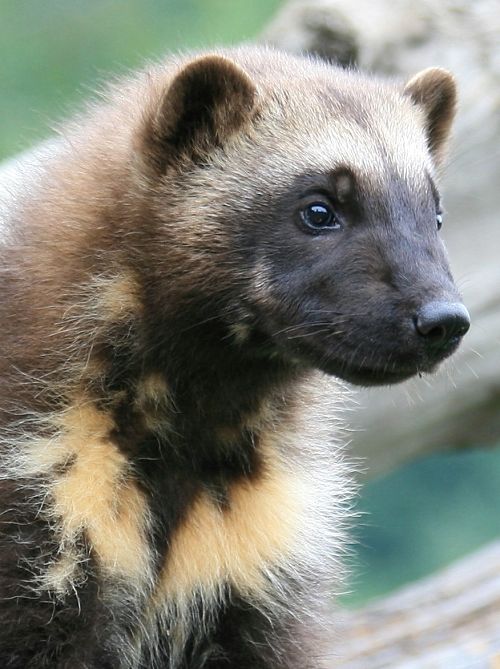 Portrait of a Wolverine
Portrait of a WolverineOne of the coolest wolverine facts is that their claws are used like climbers crampons to help them ascend icey slopes.
The wolverine is the largest member of the weasel family, which includes an assortment of very tough, often aggressive carnivores.
Burly and bear-like, wolverines are about as big as a medium sized dog, about 3 feet long, and 30 to 50 pounds.
Some exceptional males may reach up to 60 or even 70 pounds.
They have long, powerful, arching claws, and muscular forelimbs and shoulders, allowing them to ramshackle through and tear open rotted stumps in search of grubs and other insects.
They will also use their claws to literally dig voles, gophers and rabbits straight out of the ground.
They have also been known to eat fox, beaver and even porcupine.
Wolverines spend most of their time rummaging around in search of anything edible, including a small amount of vegetation likes roots and berries, but their diet consists mainly of carrion.
They have poor eyesight and average hearing but a tremendous sense of smell with which they can detect the presence of a rotting corpse from miles away, or from beneath several feet of snow.
Wolverines are fearless and may stalk and take down remarkably large prey like deer, elk or young moose, but are usually only successful with the help of deep snow to aid their hunt.
The wolverine is an impressive animal, with a long, very dense, water-proof coat of brown fur.
A distinctive lighter colored band covers the rump and extends up both sides fading out around the shoulder.
The head is a very broad wedge with small, dark eyes, and neat, widely set ears.
Wolverines are found in the Northern tundra and subarctic regions of the world, such as Siberia and Alaska.
They move about both day and night, but are generally nocturnal.
They are mostly terrestrial animals who move about their large territories with a brisk, loping gate, but they can also climb trees, and will pursue prey up in the branches.
They will also store larger kills in the crook of trees, similar to what leopards do, or cover a cache of meat with snow or earth to save for later.
Wolverines are mostly solitary animals who mark their territories with anal gland secretions.
Females are more territorial than males and will chase intruders.
They are often called "stink bears" or even "skunk bears" because of the powerful, musty scent.
They live in permanent territories and males may form permanent relationships with the females in neighboring ranges.
Male wolverines who form partnerships with females will visit their territories a few times a year, and may even spend some time with their offspring.
A Few More Wolverine Facts
- Wolverines have poor eyesight but a great sense of smell
- They can smell a dead animal buried 10 or even 20 feet below the snow
- A 30 pound wolverine can take down a deer weighing 150 pounds
- Wolverines have special teeth for slicing through frozen flesh
- Wolverine fur does not collect frost or ice and is used to line parkas and hoods
- The wolverine has 4 inch long claws
- Average lifespan for a wolverine is about 10 years
Wolf Facts
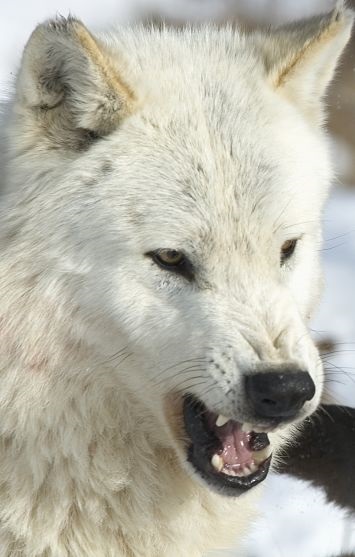 Portrait of a Wolf
Portrait of a Wolf
One of the least known wolf facts is that wolf pups are born with blue eyes. The wolf is the largest species in the dog or canid family. There are two species of wolf, the grey wolf which is found throughout the northern hemisphere, and the red wolf, which is limited to a tiny population in the state of North Carolina.
There are several subspecies of grey wolf in North America, and another 7 to 12 subspecies found in Europe and Asia. These subspecies vary only slightly in size and color, mostly as a result of the variations in climate, habitat and diet in the different locations they occur.
Wolves live in forest and mountain areas where large game animals like goat, deer and moose can be found. Many live in cold climates, and today, the largest numbers can be found in arctic regions, as the habitats in the south slowly disappear.
The Great Plains wolf, Mexican wolf, Arctic wolf, Rocky Mountain wolf and the Eastern timber wolf, (which some consider a separate species) are currently all considered subspecies of the grey wolf. Some of the largest individuals can be found in Alaska, including the largest on record, a huge male weighing 175 pounds.
Most grey wolves average between 70 and 100 pounds, 28 to 34 inches at the shoulder, with males averaging a bit bigger than females.
The domestic dog was once also classified as a subspecies of grey wolf, but recent DNA research shows that dogs and wolves have been evolving separately for more than 30,000 years. The ancestor of both the grey wolf and the dog was a small Eurasian wolf weighing less than 40 pounds, which has been extinct for nearly 15,000 years.
But wolves and dogs still carry many of the traits of that animal, such as an extremely cooperative personality, and a need for intense social interaction.
Wolves live in groups called packs, which are made up of a dominant male and female, called the Alpha pair, their offspring, and occasionally other relatives. On rare occasions unrelated individuals may win their way into the pack, but this takes lots of social skills.
The pack is a complex unit held together by a book of etiquette almost as intense as our own society.
Wolves are profoundly intelligent and remarkably expressive. Only primates display such a wide display of facial expressions and body postures, all with a specific message attached, and all part of their own unique politics.
Nothing exemplifies the spirit of the pack lifestyle more than the mutual howling that often takes place before they embark on a hunt. Like football players in a locker room, wolves boost eachother up with excited episodes of tussling, body slamming, and physical activity that is basically like hugging without arms.
They will occasionally place a foreleg over a packmate in the commotion to get close, but usually will wrap their necks around eachother and pull eachother near with their chins.
Howling sessions usually start with yips and short barks that build to howls that can last up to 15 seconds each. Group howling can take on a frenzied energy, and they will usually harmonize instead of all howling the same note, which makes it seem to the listener like there are twice as many pack members. Contrary to popular myth, a wolf howl does have an echo.
There is a bit of howling etiquette too, with the Alpha male and female correcting pack members or puppies that have howled at the wrong times.
Howling can build up spirit and bonding, but is also used by wolves to find eachother, or for solo wolves to find other solitary animals to form a new pack with. But it can be costly to howl at the wrong time, especially when they don't want hunters, prey or another pack to know their location.
Along with howling, wolves have a wide vocabulary of barks, yips, growls, grunts, whines and snorts that constitute an actual language, and wolves from different parts of the world have different dialects.
The Mind Of The Wolf
Wolves are some of the most gregarious creatures on Earth, emotionally bonded to eachother, and infused with an incredible drive to cooperate and conform to the social structure.
Pack life provides a clear order of dominance, and a powerful sense of community. Communal hunting and sharing of resources, the defending of common territory, and the cooperative raising of young, are the hallmarks of both humans and wolves.
The building blocks that made early wolves excellent subjects for domestication are still present in modern wolves, and clearly on display in the domestic dog.
One common suggestion is that wolves are far more intelligent than dogs, whose brains are actually much smaller. And experiments and studies comparing the two animals indicate that the wolf is a much better problem solver than the dog, able to learn by simply watching the actions of other wolves, but also far better at manipulating resources.
Wolves seem to have a better understanding of how things work, can solve mechanical problems like opening gates and retrieving hidden food, and are more willing to utilize their whole bodies if necessary, pushing things with their shoulders, getting low for leverage, or paddling water out of a trough to get to items on the bottom.
Dogs on the other hand, when faced with tricky problems, look to, and eventually implore humans to help them.
So wolves have the knowledge and logic to solve problems better than dogs. But it doesn't mean there is empty space in the dogs brain where this information used to be. No, there is a second language taking up space in the mind of the dog, and the complete text of an operators manual for one of the most ready resources and greatest tools available - people.
Consider the simple fact that many domestic dog puppies as young as a few weeks instinctively understand the human pointing gesture, while wolves, even those raised by people in a domestic environment, tend to ignore it.
Our Neanderthal ancestors had the brilliance and skill to survive an ice-age, but might have a little trouble using a GPS. On the other hand, think of all the knowledge we humans have lost over the last century or so. Most people today don't have the ability to start a fire, snare dinner or navigate by the stars, but we do have a grasp of technology and social outreach like no generation before.
So when it comes to modern dogs and modern humans, has evolution found us more perfect, or has it left us less intelligent and less capable...hmmm.
Wolf Lifestyle
The average wolf pack has 6 to 12 members and is very much like a big rowdy family.
The Alpha pair are the parents and make most of the decisions. The Alpha male and female are usually the only wolves in the pack that mate, will be the first to eat, and will control the packs comings and goings. Both the male and the female Alpha will mark their territory by lifting their legs and urinating around the perimeter. Other members of the pack, male and female, will scent mark as well, but only by squatting instead of lifting their legs. The Alphas retain their control over the pack by constantly asserting themselves.
They move about with confidence, head and tail held high, and expect pack members to show submission when approached. Submission can be displayed actively with the subordinate wolf crouching, keeping its tail tucked, slinking and ducking, licking at the lips of the Alpha as if pleading, or it can be displayed passively, by rolling over and exposing their bare belly and throat.
The Alphas may be benevolent rulers or may occasionally be overly dominant, biting and abusing pack members. Coups do occur, and one or both members of the Alpha pair may be deposed if all the other members rise up together. Leadership for the Alpha pair is a fine balancing act of political skill, and learning how to keep stress levels low while still displaying dominance. They rule together and will often stay together for life, but there is lots of intrigue in the world of wolves and some dramatic betrayals sometimes unfold.
Beta wolves are basically the second in command who may be siblings or other relative of the Alphas, or adult offspring. Beta wolves may challenge Alphas, and if they don't show the proper displays of submission actual fights may occur. Most Beta wolves will either mellow over time and sink back down in the ranks or leave to form their own pack.
Subordinates are the remaining adults in the pack. They may be on their way up or down in rank, or may be youngsters preparing to disperse. There is a clear hierarchy among these wolves and everyone knows their place, challenging and reaffirming themselves regularly with displays of dominance and submission played out on a much smaller scale than those involving the Alphas, but still clearly evident.
The Omega is the wolf at the bottom of the pecking order. This may be a male or a female, and generally gets the brunt of everyones frustrations. Omegas are the last to eat, and sometimes live more on the perimeter of the pack, not being allowed to participate in group play or howling sessions. Though the embodiment of powerlessness the Omega ultimately seems to play a very important role in the pack, reinforcing the structure of the society. And for those optimists out there, yes, occasionally they fight back and move up a few ranks, sending someone else to the bottom of the heap.
The wolf pack only uses a den in the springtime when pups are too young to travel, otherwise they are on the move throughout a territory that may be several hundred square miles in size. They spend over 30 percent of their lives on the move and can comfortably travel at 5 to 7 miles an hour over rugged terrain for hours at a time. If they leave the pack they must completely abandon their former territory and disperse as far as 500 miles away. Some tagged wolves have even been tracked over 1000 miles from their original location.
Wolves can hunt very large prey, often ten times their own size, because of their ability to live and work as a unit. They will approach a herd of elk, deer, caribou or musk ox, spread out their ranks and evaluate their prospects. Wolves will observe the herd and attempt to identify the weakest individual. They may begin to pressure the herd to move, judge their reactions and single out a target. They work in unison, weeding the target out and taking turns running it down in a type of relay race, and when the time is right they will strike as one.
Wolves don't generally use a kill bite on prey, and the kill may be long, messy and gruesome. All pack members will eat in order of their rank, and if there are puppies to feed, all pack members will regurgitate food for them, or present them with whole pieces.
Wolves spend a great deal of time tracking prey. They tend to live in desolate areas and have enormous territories, so a kill every 3 to 5 days is typical. When they make a kill they will rest beside it and feed from it until very little remains. They eat all organs, muscle and fat, and will also crush bones with their powerful back teeth to extract the marrow.
Antlers, horns, hooves and large bones become toys, and after feeding the entire pack will spend time playing which is a pastime wolves never outgrow.
Much like domestic dogs, wolves find great joy in the company of their pack mates, and may nap at the end of the day in a great pile, entangled together.
Wolf Reproduction
Generally only the Alpha male and female will mate, and only the Alpha female will find or create a den to have her puppies in. All female wolves of breeding age will come into estrus in late winter, but the Alpha pair will attempt to stop any breeding activity between subordinate wolves.
Occasionally, however, a Beta or subordinate female will mate and have a litter. This usually only happens when there is a good food supply and the pack is doing well. In lean times this is not allowed, and sometimes even the Alpha pair will not mate if food is scarce.
If another female does have a litter, the puppies may be welcomed by the pack, as long as the Alpha female allows it, and all the pups will all be raised together by the pack. Both mothers may nurse all the puppies, and females who haven't conceived may have a "false pregnancy" that allows them to lactate and nurse the youngsters as well. This can be an enormous benefit to the pack as the strain on the mother is reduced and the pups are well-nourished.
The female is pregnant for about 65 days, and will find a suitable den when she is within a few days of giving birth. Only the pregnant female will use the den, which may be a cave or a fox hole or badger cette she excavates to accommodate her.
She will have an average of 3 or 4 puppies that are born blind and helpless, and she will not leave the den for the first few days after their birth as they need to nurse and require her warmth and protection. During this time pack members will bring her food, both whole and also regurgitated, and they may regurgitate water for her as well.
At 10 days or so, the pups eyes open and are a startling blue color. They won't turn yellow or brown until about 10 weeks.
The entire pack is anxious to see the pups, who emerge from the den at about 4 weeks old. At this age they will begin to socialize with all the pack members, begin to receive some regurgitated meals and even join in group howls.
By 8 to 10 weeks the puppies are weaned off their mother's milk and can travel several miles a day with the pack. They may observe hunts, and will excitedly attack fresh kills.
As the youngsters grow, and their personalities emerge, it becomes clear who will accept life as a subordinate within the pack, and who will leave.
Leaving the pack, known as dispersal, is the most dangerous decision a wolf can make, but without that boldness the young wolf might never have the opportunity to reproduce. Male and female wolves may leave the pack usually between 2 and 4 years of age, occasionally with a sibling, but most often alone.
When they make the choice they commit to it, and they must completely remove themselves from their former territory. As they travel to find a place of their own they may be confronted by hostile wolves who have also dispersed or who are members of other packs. If they wander into the wrong territory, they may be torn apart by another wolf pack.
They may find a neighboring pack and shadow it for a while. Both males and females may do this, and they may sneakily try to lure a member of the opposite sex to join them. Rarely, they may be able to simply join a new pack and establish their own place in the hierarchy. If the wolf whose attention they have favored is part of the Alpha pair, there may be a mutiny. If this happens, the pack members may choose a side and run off the unwanted newcomer, or depose the former Alpha.
And sometimes they find some unclaimed turf, begin to define the boundaries by scent-marking around the perimeter and settle in. Before long a lone wolf of the opposite sex may wander through, and if the chemistry is right a new pack is born.
A Few More Wolf Facts
- Wolves are born with blue eyes
- When packs howl, they harmonize
- The wolf is the largest species of canine
- Wolves can be solid black and solid white as well as all shades of grey and brown
- It is a myth that wolf howls don't echo
- A wolf's sense of smell is 100 times more powerful than ours
- A wolf packs size seems to be determined by the size of game available
- Wolves regularly hunt animals like moose that may be 10 times their size
- Wolves lift their legs to urinate on trees just like dogs
Wildebeest Facts
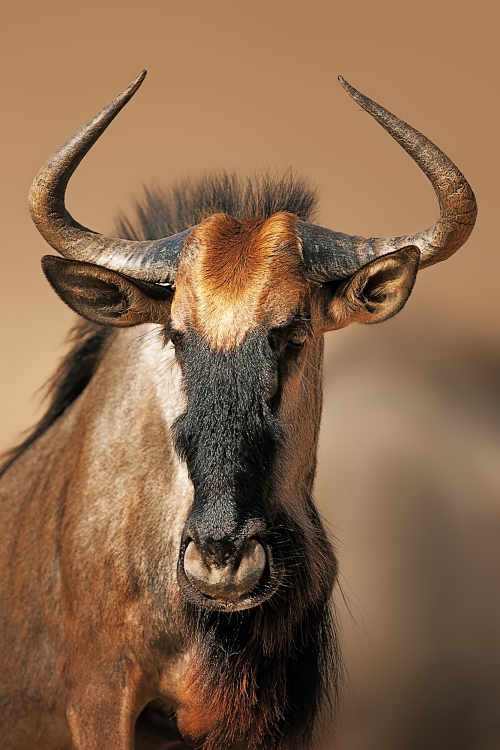 Portrait of a Wildebeest
Portrait of a Wildebeest
One of the most amazing wildebeest facts is that their journey across Africa is part of the Great Migration every year...
The wildebeest is the iconic antelope of the African plains, with a marvelous, rugged appearance, and unmistakable anvil-shaped head.
It is also commonly called the gnu - pronounced "new", and sometimes referred to as the "fool of the veld" or the "poor man's Buffalo"
Wildebeest live in massive herds of sometimes thousands, and many participate in the Great Migration, one of the most amazing spectacles in the animal kingdom.
Bizarrely proportioned, and seemingly anonymous in their large herds, the wildebeest is often overlooked, and sometimes even maligned as unattractive and unintelligent.
Well, beauty is in the eye of the beholder, but from an intelligence standpoint wildebeests are actually very vibrant animals with playful personalities and some very admirable traits.
One of the toughest creatures in Africa, the wildebeest is always on the move, grazing day and night, napping occasionally, while some keep watch.
In nature documentaries they are every predators favorite meal and seem to fall victim constantly.
But the wildebeest is one of the few African residents that has increased in numbers since the 1960's, and the fact is, many live remarkably long lives on the plains, sometimes reaching 20 years of age.
There are two species of wildebeest, the black wildebeest, and the far more common blue wildebeest.
The blue wildebeest has a silvery blue hue to the coat, with black mane and tail.
The black wildebeest is actually primarily brown in color, with a flaxen colored tail and a stiff upright mane of black and pale tan.
From afar, however, the black wildebeest may appear decidedly dark and even black in color.
Black wildebeest weigh between 250 and 400 pounds and 44 to 48 inches at the shoulder, while the blue wildebeest averages 300 to 600 pounds and stands 4 to nearly 5 feet at the shoulder.
The horn placement of the two species is different also, with the black wildebeests horns protruding first forwards, before dropping down and back up, while the blues horns extend to the sides, then down and up again.
Both males and females have horns, but those of a mature male are larger overall, and thicker in particular.
A mature male blue wildebeest may have horns over 60 inches wide.
During breeding season male wildebeests attempt to establish territories and impress females by battling other males.
Bulls will charge eachother, bellow, and kneel down and thrash horns in a dramatic display.
Females give birth standing up in the center of the herd, to one large, well formed calf.
Within 15 minutes of the newborn hitting the ground, it will be up and moving with the herd.
Not all populations of wildebeests migrate.
Most black wildebeest are actually permanent residence throughout their range.
But some herds of blue wildebeest must journey long distances in search of food and breeding grounds.
Every year some 2 million wildebeest along with 800,000 zebras and gazelles form one giant, continuous herd and travel about 1,800 miles following the rains.
A Few More Wildebeest Facts
- Wildebeest are energetic, active and playful
- A wildebeest can run at 50 miles per hour
- There are 2 species of wildebeest, blue wildebeest and black wildebeest
- Wildebeest have a lifespan of up to 20 years
- Both male and female wildebeests have horns
- Some 2 million wildebeest take part in the great migration each year
- Not all populations of wildebeests migrate
Tiger Facts
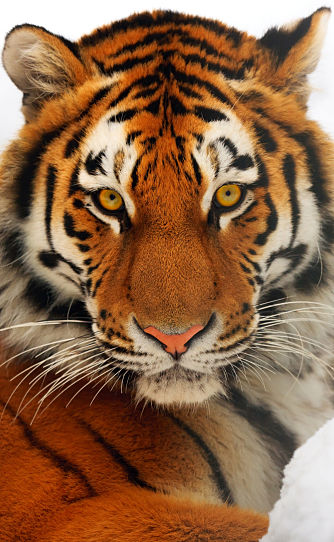 Portrait of a Siberian Tiger
Portrait of a Siberian Tiger
The tiger is, on average, the largest of the big cats, with the African lion a close second. A mature Siberian tiger can top out at 11 feet long and close to 700 pounds.
Tigers once inhabited most of Asia, from the tropical islands to Siberia. Today they are restricted to small patches of territory and very limited populations of each of the 6 living subspecies.
The largest of the tigers, the Siberian or Amur tiger, lives in the coniferous forests of Russia where its thick fur and full neck ruff keep it warm in deep snow.
In contrast, the much smaller Sumatran tiger lives in thick southern jungles and regularly bathes in ponds or streams to keep cool.
The Bengal tiger is the most common of the subspecies. They are almost as large as Siberians with top weights in the 500 pound range. Bengal tigers live in India, Bangladesh and Nepal in semi-tropical jungles.
The tiger is a stalk and ambush style hunter, and it's familiar stripes provide camouflage in thick underbrush as it waits for prey as large as 1000 pound water buffalo.
They have the largest fangs in the animal world and are very swift killers. The tiger is basically a solitary animal with a typical feline lifestyle. They roam wide and have very large overlapping territories but conflict and aggression between individuals is rare, and amazingly, wild tigers have been known to share their kill with other individuals, not always family members, who may happen upon them feeding.
This fascinating behavior, so different from the highly food-aggressive African lion, has been well documented.
The tiger, (and particularly the Bengal due to its proximity to civilization) is responsible for more human deaths then any other cat, hence the common term "man-eating tiger".
A symbol of conservation efforts, the tiger is critically endangered throughout much of its range, but many of its small, pocket populations have remained stable for years due to government crackdowns on poaching. - Tiger Facts
Tiger, Tiger
As the third largest carnivore on land, the tiger is smaller only than the polar bear and the brown bear.
But Bengal tigers in particular eat some of the largest prey, including gaur antelope, sambar deer, and massive water buffalo over 1200 pounds.
Tigers have been known to kill and eat sloth bears and Asian black bears, baby rhinos and even leopards. There have been isolated incidents reported of Bengal tigers taking down young elephants and even full grown infirmed adults.
Siberian tigers - the largest of the tiger subspecies - actually prey on smaller game than the Bengal, with deer and mountain goats being their most common fare.
The Bengal is also the most likely tiger to kill human beings because its range has been so severely impacted by advancing development.
Most wild tiger subspecies do not intermingle, because their populations are separated by wide swaths of civilization, but captive individuals in zoos, preserves and private possession have been housed together, and have inter-bred for decades and are not usually pure representatives of any one subspecies.
More often than not they are of mixed heritage, out crossed between the subspecies for so many generations of captivity that they are effectively "mutts". .
Tiger Reproduction
Male and female tigers will pair up when the female is in estrus. After mating numerous times over the course of 4 or 5 days the male will return to a basically solitary life.
The female tigers pregnancy is 3 1/2 to 4 months long. In the last few days of pregnancy, the tigress will secure a safe nesting place because where she will deliver her 3 to 5 cubs.
The newborn tiger cubs weigh only about 2 pounds, are blind, completely helpless, and fully striped. The mother only stays in the same nest for a day or two and moves her cubs from hiding place to hiding place one at a time for the first few months of their lives.
This is a very dangerous time for the cubs, as she must leave them alone while she hunts. Often entire litters are lost when they are discovered by bears, leopards or snakes.
Fathers do not take part in the rearing of the cubs, although they have been known, on rare occasions, to return to visit and rest nearby.
Mother tigers begin to take their cubs on hunts when they are about 6 months old, but they won't be able to successfully hunt for themselves until they are about 2 years old.
Once the tiger cubs are fairly efficient hunters, they begin to branch off from their family, slowly developing their own territory, which they will mark by clawing trees, spraying urine and leaving strategic droppings.
Young females with their new litters will occasional visit with their mothers to show off the grandkids. Alliances of adult females occur briefly, from time to time, but food of the size and quantity that tigers must have is scarce and requires that tigers spread out in order to survive.
The depletion of large game animals throughout their native lands is the single factor in the endangered status of the tiger. Most of their habitat is compromised by human expansion and the undisturbed acres they need to survive are hard to come by.
Popular To A Fault
In a recent poll, the tiger was voted favorite animal in the world, beating out the humble domestic dog by one percentage point.
The Siberian tiger and the Bengal tiger, with their impressive size, spectacular coloring, and breathtaking beauty, have captured peoples imaginations for thousands of years.
Unfortunately, capturing some of the tigers magic is a human obsession, and potions, remedies and good luck charms made from almost every tiger body part are big business.
Tiger blood, crushed bones, and entire paws or skulls are highly prized to this day, and even as every sub-species of tiger is endangered in the wild, illegal poaching still goes on to supply the trade.
Fortunately for the survival of the species, many people still like their tigers alive, and while less than 5,000 tigers survive in the wild, there are at least 60,000 in captivity, with over 10,000 kept as personal pets in the United States alone.
This Cat Loves Water
Unlike most other cats, tigers do not shun water, in fact, they regularly play, lounge and otherwise recreate in the ponds, lakes and rivers of hot Asian jungles, swimming not just to cool off but just for the fun of it.
Exceptional Hardware
Tigers have the largest fangs in the animal kingdom, in fact, the longest Siberian tiger teeth on record were close to 5 inches long.
That's nothing to snarl about!
Another well equipped creature was the long extinct Saber-tooth tiger.
The saber-tooth had fangs as long as 10 inches, theoretically to pierce the tough hides of woolly mammoths!
The saber-tooth was not actually a tiger though, it was a bear-like creature called a smilodon.
There is no evidence that the smilodon was striped, but we do know it had only a 9 inch tail.
A Few More Tiger Facts
- The Siberian tiger is also known as the Amur tiger.
- The tiger is the largest of the four "Big Cats"
- Tigers love water! Playing, swimming and snoozing in it!
- There are 3 times as many tigers kept as personal pets in the U.S. than exist in the wild.
- Tigers can eat 60 pounds of meat at one time.
- A group of tigers is called a "streak"
- Tigers can be found both on tropical islands and in the snow covered wilderness of Siberia.
Tasmanian Devil Facts
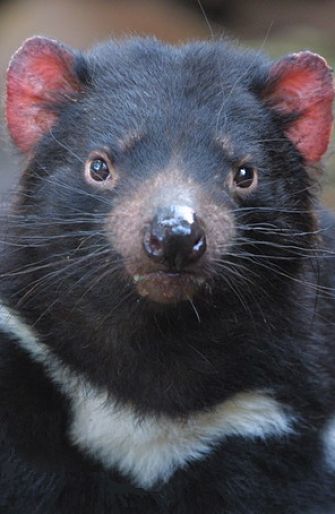 Portrait of a Tasmanian Devil
Portrait of a Tasmanian Devil
The fascinating Tasmanian devil is a carnivorous, semi-nocturnal creature, whose aggressive nature and wild hissing, growling and screaming earned it the name.
A full-grown Tasmanian devil is only about the size of a big housecat, but it is the largest meat-eating marsupial, and its voracious appetite is a thing of legend.
While devils are usually solitary, their excellent noses will often lead several of them to the same carcass at once, and communal feeding is rather common.
Tasmanian devils have powerful jaws filled with large sharp teeth, and a feeding group will devour every last bit of a meal, be it rabbit or kangaroo, bones and all.
Devils are mostly scavengers, and are considered very valuable to the environment as sort of 4-legged vacuum cleaners. They hunt as well, taking birds, insects and other small game.
Living in woodlands and eucalyptus forests on the Australian island state of Tasmania, devils can be seen out and about during daylight hours, but do most of their stalking and scavenging at night.
The growls, whines and cantankerous sounds of the devil are its single most fascinating characteristic, and it really isn't clear why they are so incredibly noisy, but the manic and popular cartoon character of the same name is quite accurate: massive head, full body, extra cranky. - Tasmanian Devil Facts
Tasmanian Devil Personality
Tasmanian devils fight allot, and are known for their fierceness, but they will often use a few clever techniques first, before resorting to full out combat.
When a dispute finds two devils face to face, their skin will flush red, turning the ears crimson, and they will gape their impressive jaws at each other, screaming and growling the whole time.
If the situation is stressful enough, the devil will release a musky odor that would clear most rooms. Finally, they will emit a stacatto sneeze that is sometimes so violent they loose their footing.
If all else fails, its time to rumble, and most devils have the scars to prove it.
It's not hard to snap a photo of a Tasmanian devil with its mouth agape - the familiar pose is used in many instances throughout the day, and expresses everything from joy to rage to the Tas version of nervous laughter.
Tasmanian Devil Reproduction
Tasmanian devils are marsupials, like kangaroos and koala bears, which means that their babies start to develop in the womb, but then move to a pouch on the mothers abdomen to continue growing.
Female Tasmanian devils come into heat in springtime, and the month long mating season is filled with lots of extreme activity.
Males battle each other viciously for the attention of mature females, but it does not end there. Once the most powerful male sends weaker competition fleeing, he must prove his worth to his sweetheart. The mating pair will engage in loud, highly aggressive wrestling sessions, and if the female is not impressed, she will move on to another fellow.
If the male is powerful and dominant enough, the two will mate several times over the course of a few days. Both males and females may mate with numerous partners during the season, and it is actually possible for one litter of babies to have two, three, or even four different fathers.
After about three weeks of pregnancy the female Tasmanian devil finds a comfortable den and settles in.
She will give birth to as many as 30 tiny babies that are blind, hairless, and less than the size of a single grain of rice. They are effectively still just embryos, and must make it to the mothers pouch in order to continue development.
Without their mothers help, an army of squirming babies crawl through a forest of belly-hair from the birth canal to the mothers pouch, which is a distance of about 4 inches, (a long trip for a grain of rice).
Then, in a true example of "survival of the fittest" the baby Tasmanian devils find only four teats in the mothers pouch. The four that make it to a teat first survive, the rest perish.
Four months later, the tough little devils emerge from moms pouch and explore their world.
The sound of a litter of devils play fighting is blood-curdling and constant, and by the time they are eight months old, they start off on their own, complaining the whole way.
A Devils Life In Three Easy Steps
Like a miniature African lion the always ravenous Tasmanian devil is a "gorge feeder" filling up to the brim as long as food is available and then collapsing flat on the ready-to-bust belly, legs outstretched, to digest the huge meal.
It goes like this -
Step One: Scurry about wailing and complaining till you find something dead.
Step Two: Eat till you're ready to explode.
Step Three: Sprawl out like a bear-skin rug and process, process, process...
Devil Facial Tumor Disease
In the late 1990's an unusual cancer began to appear in the wild populations of Tasmanian devils. Know as "devil facial tumor disease" or "DFTD" it has caused a disturbing drop in devil population.
Recent efforts to find treatments and cures have been positive, but the terrible disease persists and may cause the demise of a truly unique and fascinating creature. Lets hope not...
A Few More Tasmanian Devil Facts
- The Tasmanian devils jaws open a full 80 degrees and it has a bite strength of 1200 PSI!
- The devil stores fat in its tail so when food is scarce the tail is narrow and limp, when life is good the tail is fat and happy.
- Tasmanian devils spend more time biting each other than any other species
- The huge head, massive neck and powerful jaws allow them to eat parts of carcasses that others might leave behind - like the bones!
- The mothers pouch is called a "marsupium", and is where the word "marsupial" comes from.
Snow Leopard Facts
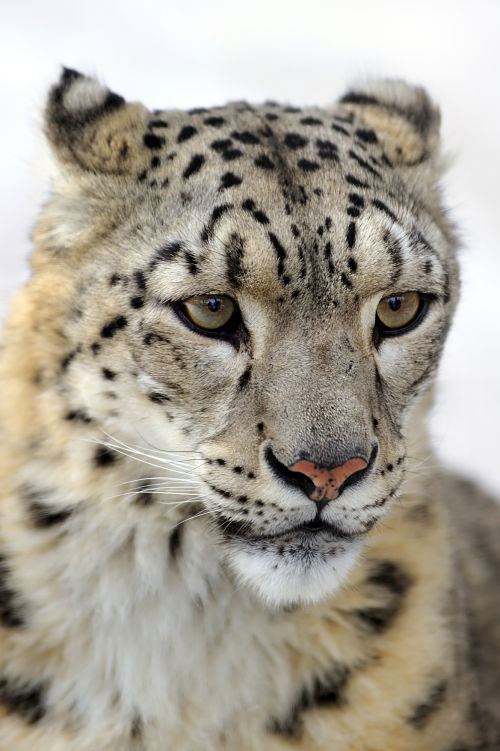 Portrait of a Snow Leopard
Portrait of a Snow Leopard
One of the saddest snow leopard facts is that this beautiful feline is an endangered species.
The magnificent snow leopard is native to northern and central Asia, and can be found in China, Russia, Afghanistan and several other countries.
Over 60% of the world's snow leopards live in China.
They are at home in the Himalayan mountains, and live in snow covered peaks as high as 17,000 feet in elevation.
This is a brutally harsh environment of rocky cliffs and steep outcrops.
Although they live in high elevations, they do not have the oxygen carrying adaptions of their blood hemoglobin that other high-altitude animals have.
It is actually a bit of a scientific mystery how snow leopards survive at such high altitude without this modification.
They are otherwise very well specialized to their habitat.
Very large, powerful and flexible paws act as snow shoes in drifts, and snow tires on ice.
A muscular, extra-long tail aids in balance as they climb and leap, and provides extra warmth wrapped completely around their curled up form as they sleep.
They have an incredibly thick, plush coat of fur, that sheds out and fills back in again as the seasons change.
And the hair coloration, brown and black spots on a field of cream and grey, allows these fairly large animals to practically disappear into their environment.
The camouflage coat, coupled with their elusive nature, nocturnal habits and unfriendly habitat, make them a very rare sight in the wild.
But humans, particularly goat farmers, are pushing further into the snow leopards terrain.
Wild species of goat are one of the prime food sources of the snow leopard, and as humans encroach, the leopards are hunted down to protect goat herds and other livestock.
The leopards magnificent coat can also be worth several hundred dollars on the black market.
For some people, that is more than they earn in an entire year.
So, it is estimated that less than 6,000 snow leopards exist in the wild.
And they are spread out over hundreds of thousands of square miles of hostile terrain, making reproduction, management and conservation, extremely difficult.
Is The Snow Leopard Really A Big Cat?
The snow leopard was discovered and officially classified in the 1700's. It was placed in it's own genus - Uncia - because of marked unique differences in skull structure.
It was not classified as a big cat, not only because of skeletal differences, but because the fibro-elastic tissue that forms part of the vocal apparatus in the Snow Leopard is underdeveloped in the snow leopard compared to the "big cats".
In short, the snow leopard cannot roar, and so was not considered a "big cat."
The "big cats" are the lion, tiger, leopard and jaguar, the members of the genus panthera.
Genetic studies done in 2007 seemed to indicate that the snow leopard was more closely related to the tiger.
Another study suggested that they had, at one time, interbred with lions.
As a result of these studies, the snow leopard was reclassified. It was placed in the genus panthera, and became the fifth "big cat".
There has been a general trend toward favoring genetics over physiology in recent years, but the motivation here may have been political.
The snow leopards reclassification as a "big cat", may help raise awareness of the plight of this stunning animal.
But science should never be stretched, no matter what the cause.
A Few More Snow Leopard Facts
- The snow leopard has been considered a "big cat" since 2008
- Unlike the other "big cats" they cannot roar
- Snow leopards are 22 to 24 inches tall at the shoulder
- Snow leopards weigh between 60 and 100 pounds
- Their large feet spread out and act like snowshoes
- Snow leopards are nocturnal, and hunt at night
- They can jump a distance of over 30 feet
Sea Lion Facts
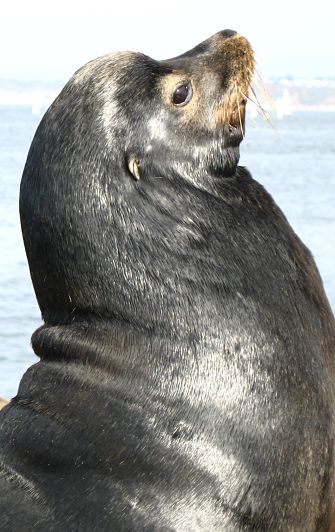 Portrait of a Sea Lion
Portrait of a Sea Lion
Sea lions are 7 species of large marine mammals in the pinniped (seal) family. The sea lions ancient ancestors were land animals somewhat similar to bears.
For reasons unknown these creatures returned to the ocean about 20 million years ago, where they have since become the most successful and widely distributed family of carnivores in the world.
The sea lions entire body is structured for life in the water, with a smooth, torpedo shaped torso and flattened, powerful flippers, like four large swim fins instead of feet.
In fact, the swim-fins scuba divers and backyard snorkelers use were modeled after a sea lions unique, compressed and web-toed hind feet.
Sea lions live in very large social groups called colonies that may come together to sunbathe in masses of hundreds, and take to the beach to mate and raise young in tightly packed gatherings of thousands.
On land they are relatively cumbersome, but, unlike the "true seals", the sea lions can lift their bodies up off the sand and walk on all fours, and even run if necessary.
This ability finds sea lions and fur seals commonly referred to as the "walking seals", while their external ears are why they are also referred to as the "eared seals."
The "true seals", such as elephant seals and harp seals, do not have external ear structures and are not capable of walking, but rather must roll or wriggle from place to place when on land.
In the water, sea lions shine with balletic grace, spending the majority of their time hunting in reefs and ocean waters where they can dive as deep as 900 feet and remain submerged for over half an hour.
Sea lions are true carnivores and individuals may eat as much as 50 pounds of fish and squid in a day. They are solitary hunters and rarely if ever take large game such as penguins or seals, concentrating mostly on small squid and school fish such as herring and anchovy, which they can swallow whole, without any chewing at all.
Sea lions stalk schools of fish which they rush through with jaws agape spearing their quarry with impressively sharp teeth. They also forage through reefs using their long, stiff whiskers, known as vibrissae, to flush out assorted invertebrates, crabs, and their favorite food, squid.
Sea lions are highly social, and happy to live in very close company. They will notoriously pack together on beaches, rocks, boardwalks and boats, smushed against one another in huge, languorous piles.
Sea lions have thick fur and even thicker layers of blubber to keep them warm in their preferred cold climates, but they exist in all the oceans of the world except for the Atlantic ocean.
Species of sea lions and fur seals can be found on the Bering strait, Australia and New Zealand, South America and California.
Like many marine mammals, sea lions are remarkably intelligent with excellent senses of sight, hearing and smell.
In captivity, and when interacting with humans, they are extremely quick to learn, and have been exhibited in shows and circuses for centuries.
The typical performing seal is most likely a California sea lion, one of the most common and familiar of the seven sea lion species. - Sea Lion Facts
Sea Lion Lifestyle And Reproduction
Sea lions display extreme sexual dimorphism, (marked differences in appearance or size between males and females of the same species), with adult males being at least two times, and as much as four times larger than adult females.
In addition to just overall size, mature males over 10 years old are recognized by their impressive, crested foreheads and massive necks.
A bony ridge down the centerline of the skull known as a sagittal crest begins to develop at about 9 years of age and, over time, gives the males head a distinct, and impressive look.
Male sea lions gather at specific breeding grounds early in the mating season, and actively attempt to establish their own territories before females arrive.
The breeding ground is known as a "rookery" and is usually on a quiet island with sandy beaches. Much of a males dominance is related to size, with smaller animals almost always giving way to larger ones.
Males will develop a territory of only a few dozen feet in any direction and when another male attempts to enter, lots of bluffing, barking, roaring, hissing and growling occurs.
Actual fighting occurs as well, and injuries can be serious or fatal, but most disagreements are settled by ritualized, sumo-style shoving matches, and games of chicken involving extraordinarily loud full-speed charges at each other.
Once an area is established, the male will patrol his patch of beach and also a few yards of ocean in front of it, barking nearly constantly as he goes.
When all of the beach is claimed, younger, weaker or smaller males unable to gain a territory, form bachelor groups on the outskirts of the beach, and may continue to be chased about from one mating ground to another by the established males.
When the females arrive weeks later, the males try to attract them to their territory and gather a harem of as many as 15 females.
Males with prime, beach-front properties attract the most mates. This is a vitally important time in the life of a mature male sea lion, and he actually may not eat for the entire length of the mating season - up to 30 days- while he struggles to maintain control of his territory and the females who have chosen to reside there.
The female sea lion usually arrives already pregnant from the season prior, and the single pup that she delivers is probably not the offspring of the male whose territory she resides in this season, unless she happened to have hooked up with the same male the prior year.
Females will give birth within a few days of arriving at the rookery, and will be ready to mate 10 to 14 days later. The fertilized embryo develops in the womb for only a few weeks and then becomes dormant. It will not begin to grow again for another 4 months or so, when it will become implanted in the wall of the uterus and start to fully develop.
The entire pregnancy lasts between 8 and 12 months depending on species. This process is known as embryonic diapause and is fairly common in many large mammals.
The pup is quite large when born, weighing up to 55 pounds, sighted and fully furred. The mother remains on the beach with her new pup for the first 5 to 15 days, and fasts this entire time.
When she finally goes back to the sea to hunt and feed, she leaves the pup in a little playgroup of several other pups who will play and sleep together while they wait for their mothers to return.
A mother sea lion may be gone for days at a time, but when she returns, she will be able to find her own pup, in a sea of sea lions, by calling for it with her own distinct vocalization.
The pup has a distinct yelp of its own, and when it hears its mother nearby, begins to call to her desperately. Mother and pup may stay together for up to two years before the youngster heads out on its own.
Why Is It Called A "Sea Lion"?
Many of the sea lion species we commonly see, actually don't bear a very strong resemblance to lions, so where does the name come from?
All sea lion species are carnivores with large canine teeth, or "fangs", and a muzzle full of stiff whiskers, and may also make loud roaring noises which are all lionesque features, but the most shockingly lion-like species is the incredible South American sea lion.
Males of this species can reach 9 feet in length, weigh over 800 pounds and have huge, broad heads and necks that can be thicker than their torsos in circumference.
The neck and head structure are dazzlingly leonine, but the South American sea lion also has ruff of long hair that makes everything very clear.
The "mane" is most obvious when the fur is dry, and leaves no doubt that the name "sea lion" is deserving.
The largest species of sea lion, the Stellar sea lion, also has a noticable mane, and males of this species can reach 2200 pounds and 12 feet in length.
The California sea lion, notorious for staking its claim along the entire West coast of North America from Alaska to Mexico, is probably the most well-known of the sea lion species, and is the most likely to appear performing in circuses and water parks.
Male California sea lions do have a full, round neck and develop a bony sagittal crest atop the skull cap as they mature that makes for a cool silhouette, but without the mane it doesn't really read "lion", and females of all the species never develop the truly lion-like physical features that ultimately must have inspired the name.
After all, just look at these guys!.
What Is The Difference Between Sea Lions And Seals?
Sea lions are members of the seal or pinniped family. The word pinniped means "flipper feet" or "feather feet" and includes three types of semi-aquatic marine mammals. The walrus, the "true seals" and the "eared seals" or "walking seals".
There are 7 species of sea lions, and 9 species of fur seals that make up the "eared seals". Eared seals differ from true seals in that they have external ears, larger, more powerful forelimbs, and can rotate their hind limbs forward and beneath them.
These differences in skeletal structure allow the sea lion and fur seal to not only sit in a semi-upright position, (that classic pose) but also to walk and even run on all-fours.
The rear limbs of true seals are fused together and are permanently facing rearward, making walking impossible. All pinnipeds, even walruses, are considered seals in the broad sense that leopards are considered cats, so it is not incorrect to call a sea lion a seal, just less precise .
Eared seals spend a great deal of time on land, breeding and sunning on the shores. With long, powerful front flippers, their natural position is upright with the chest raised off the ground.
Their rear legs are two separate, front-facing flippers that can be rotated under the body and they can rise up and move around with a two beat gate. Also often referred to as the "walking seals", the eared seals can actually move, even run, quite rapidly when necessary.
The "true seals" have no external ear flaps, smaller front flippers and rearward facing hind limbs that are fused together into one scalloped flipper. They move across land by stretching their upper bodies out and arching their backs to pull themselves forward.
True seals also swim differently from eared seals, getting most of their propulsion from their fused, tail-like rear flippers and undulating motions similar to a dolphin to propel themselves, while the eared seals use their strong front flippers as big, highly effective oars, appearing to fly through the water like birds.
Walruses have skeletons designed more like the eared seals, but have no ears. They move like the true seals in the water, but like the eared seals on land, and so are somewhere in between these two groups, and are classified in a genus of their own. - Sea Lion Facts
Sea Lions Are Amazingly Noisy
Although sea lions do not make a wide range of sounds, they are very noisy, and easily one of the most vocal mammals on Earth.
Anyone who has observed large groups of sea lions sunning themselves on beaches or piers, knows that not only is there a continual racket while the animals move about to find good resting spots, but even while they are apparently fast asleep.
Grunts, groans and snores abound in a colony of sea lions. Groans and squeals may occur with the mouth closed, often accompanied by billowing cheeks, but classic barks and roars are delivered with jaws agape, and the noise is nearly constant.
Arguments erupt over possession of prime basking areas, yet they all seem to end up on top of each other.
Sea lions appear to have an innate need to be in close contact with each other, and to literally be surrounded by their peers. The social structure is loose and very uncomplicated except during breeding season. All other times a warm body and a friendly "ark, ark, ark" means this is home.
All In The Colony - Sea Lion Invasions
Some sea lion colonies are permanent residence throughout their range, while other species are partially migratory.
The California sea lion may or may not migrate. Many females live on barrier islands year round, raising their pups in large daycare groups with multiple mothers keeping an eye out for danger.
Most males migrate back to the mainland where they have been known to takeover private boats, beaches and even the famous pier 39 in San Francisco.
Legend has it that California sea lions began to appear in extremely large numbers after an earthquake struck California in 1989. On one pier in particular - pier 39- the numbers were uncontrollable.
These sea lions showed little concern for humans desires to utilize the docks, would show aggression when people attempted to move them, and transformed a peaceful dock into a noisy, odorous free for all.
Folks who had docked their boats in the area for decades simple moved out, and the wildlife took over. Now an amazing tourist attraction, the sea lions lounge while onlookers take pictures.
Crowding is a sea lion thing, and they would prefer to sleep three bodies deep than move to an unoccupied platform.
When they aren't crowding the San Francisco piers, the California sea lions are crowding the islands for mating season, where their bodies fill the water and the dunes, and their constant barking, roaring and growling can be heard from over 5 miles away. - Sea Lion Facts
A Few More Sea Lion Facts
- Sea lions are known as eared or walking seals
- A male sea lion is called a bull, a female is called a cow, and a baby is called a pup
- A group of sea lions is called a colony on land, and a raft when in the water.
- The male stellar sea lion can grow to the size of a compact car weighing over 2000 pounds and measuring over 10 feet long.
- Some sea lions can stay underwater for over half an hour without taking a breath
- Male sea lions may fast for up to 40 days during mating season.
- Female sea lions may fast for up to 16 days when their pup is first born
- The sea lion is known as the "angel of the sea" because their front flippers look like angels wings while they are swimming and sometimes when they are sleeping.
- The trained seals seen in water parks and circuses are usually California sea lions.
Rhino Facts
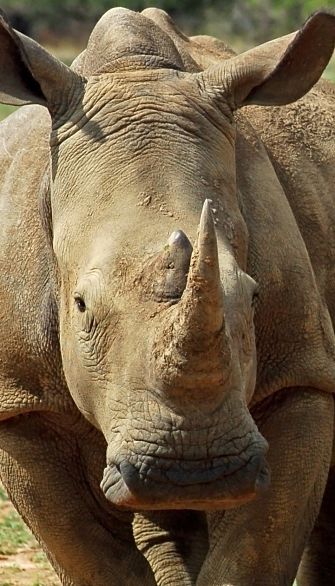 Portrait of a White Rhino
Portrait of a White Rhino
The rhino is the second largest land animal after the elephant. They have thick, bare skin, which is sometimes arranged over their bodies like plates of armor, barrel-like bodies, gigantic heads, and incredible horns protruding from their faces.
The mass is supported by short, stout legs and wide feet that have three both front and rear. Each individual toe ends in a hoof, which leave a footprint that looks like the Ace of clubs.
These animals have remained unchanged for thousands of years, so the resemblance to dinosaurs like triceratops is intriguing, but their closest relatives are actually tapirs and horses.
There are 5 species of rhinoceros, 3 living in Asia, and 2 in Africa. All rhino species are endangered, except for one subspecies of white rhino, which has recently been brought back from the brink of extinction.
The most familiar rhinoceros species are the black rhino and the white rhino, but both of these animals are actually grey in color. The term "white" stems from a misinterpretation of the word "wide" describing the shape of the white rhinos mouth, and the black rhino is so called because it is often the color of the mud it covers itself with.
The African rhinos can be 6 feet tall at the shoulder and average about 3000 pounds. They have massive, low-slung heads that feature unusually forward eye placement, and long, sharp, dramatic looking horns.
The word rhinoceros basically means "nose horn" in Latin.
The white, black and Javan rhinos have two horns, while the Indian (also known as the greater one-horned) and Sumatran, (also known as the hairy rhinoceros), have one. These horns are made of keratin, like human nails, and grow out of the skin in a similar fashion.
Rhinos are intimidating looking creatures, and will charge when confronted or threatened, but they are not generally aggressive towards humans, and only 2 or 3 attacks are reported a year. In comparison, fatalities from elephant attacks number 400 to 500 a year, and hippos kill about 2,900 people annually!
The Asian rhinos in particular, are shy, reclusive, and even timid.
The rhinoceros is strictly vegetarian, grazing on grasses or browsing trees and shrubs for leaves, shoots and fruits. They are mostly solitary, especially when feeding, since their food intake of 40 to 80 pounds of vegetation a day, requires them to spread out.
Small social groups do form, consisting of females and their young, or young males banding together, and herds of as many as 30 individuals may be created near water sources during drought conditions.
Wallowing in mud is somewhat of a social event as well, and favorite spots may attract large numbers of rhinos at a time, but generally, they are not gregarious. - Rhino Facts
Rhino Lifestyle
The white rhinoceros and the black rhinoceros live in small pockets of grasslands on the floodplains of Southern and Eastern Africa. Because of their size they require a home range of about 5 square miles that is rich in resources.
Abundant vegetation is vital to survival, but unlike many African animals who regularly go for many days without drinking, the water from the plants rhinos eat is not sufficient for them, and they will visit watering holes multiple times a day, drinking heartily.
During drought, they may have to walk up to ten miles between their water source and their food source.
Wet areas also supply them with muddy banks that they will wallow and bathe in, coating their sensitive skin with mud as protection from heat and insect bites.
Rhinoceros skin is a paradox. It can be an inch thick in some areas to protect them from battles with other rhinos, but it is actually very soft, and subject to sores and sunburn.
The black rhinoceros is particularly prone to inflamed red areas of skin called "rhino sores". Usually forming in the region of skin behind the front legs, rhino sores are parasitic infestations of tiny worms living just below the skin.
Rhinoceroses spend over 12 hours a day foraging and grazing across their territory. They are both nocturnal and diurnal, being most active at dawn and dusk, and alternating a few hours each of feeding and resting throughout the day and night. During the hottest seasons, they will feed mostly at night, and rest and wallow in the heat of the day.
The white rhino is by far the most social species, often seen in small communal herds of 5 to 10 individuals, and it is believed that loss of territory is forcing them to become more and more tolerant of each other.
Black rhinos are far less gregarious, and are also the most pugnacious of the rhino species. Adult male black rhinos can be quite territorial and may battle to the death.
Although the rhinos within a given area may not see or socialize with each other much, they use communal dung heaps that act as message boards. Both males and females will relieve themselves in these areas, usually kicking around in the pile to spread their scent.
Rhinos have very poor eyesight, but excellent senses of smell and hearing. They are fairly vocal as well, with approximately 10 to 12 specific snorts and calls of warning, greeting, excitement, anger and delight.
- Amazing Rhino Facts
Rhino Reproduction
Dominant male rhinos establish territories by marking the perimeters with urine and dung, and actively defending the area against other aggressive males.
A large number of male rhinoceroses, although sexually mature, take a subordinate role in rhino society, and are tolerated by dominant males so long as they display submissive behavior. These males may never even attempt to establish a territory, and will never have the opportunity to mate.
The female rhinos home range may overlap several male rhinos territories. She and her youngsters freely move throughout these areas, and females themselves are not generally territorial with other females.
She comes into estrous several times a year, and males can detect her condition through the scent of her urine.
Dominant males will follow and court her, attempting to herd her into their territory. Once there, the male may try to keep her close until she is willing to mate. At this time, males may become extremely aggressive with each other, and violent fights may occur.
White, black and Indian rhinos have courtship rituals that involve males and females sparring with each other. The Javan and Sumatran rhinos are so shy and rare, that very little is known about their reproductive habits.
Once the female accepts a males overtures, the pair may stay together for a few days or even weeks, even sleeping in close contact. Or, the mating may be over in just a few hours, and she may go on to mate with other males during the same period.
The female is pregnant for approximately 16 months. When she is close to delivering she will drive off any youngster she currently has.
The birth may take place standing or lying down, and the newborn rhino is gigantic, weighing anywhere from 75 to 150 pounds.
The baby is born without a horn, which begins to grow within a few weeks, but is otherwise a miniature adult.
Their eyes are open, they are vocal, and they stand and nurse within minutes. Rhino calves begin to sample solid foods at just a week or two old, and are generally weaned at 2 years. They grow very quickly over the first few months of life, gaining as much as 5 pounds in a day!
When traveling, white rhino calves usually walk in front of their mother, probably because, with her poor eyesight, she can keep track of it better. Black rhino calves, however, always follow behind. This may be because the black rhino lives in heavier vegetation, and the mother must clear the way for her calf.
Young rhinos are raised by their mothers only, and will stay with her for 2 to 5 years, until she is ready to give birth to a new baby.
Juveniles that have been driven off by their mothers may band together in pairs or little groups until they reach sexual maturity at 3 to 6 years. Females usually have their first birth at 5 or 6 years old. Most males will not attempt to claim their own territory until they are at least 10 years old.
Rhinos reach full size, including full horn length, at about 8 years old, but males may continue to fill out for another 3 to 4 years, sometimes reaching 15 feet in total length, and weighing 6,000 pounds at the high end for white rhinos. - Rhino Facts
The Rhino's Horn
Both male and female rhinos of most species have horns, and in the black and white rhino, the females front horn is often longer, although thinner, than the males.
Rhinos have been hunted for thousands of years for the magical and medicinal powers people believe their horns possess.
Thought to cure anything from cancer to impotence, rhinoceros horn can demand thousands, sometimes tens of thousands of dollars a pound.
At an average weight of 7 to 8 pounds each, a white rhino horn could be worth $100,000 dollars by the time it makes it to the markets of highest demand, China and Vietnam.
These are life changing numbers, and the temptation is worth the risk for many poachers finding a way out of poverty, and usually being exploited by other players.
Approximately 500 poachers were shot and killed by authorities in South Africa's Kruger National Park in the last 5 years. Many more are fined or imprisoned. But the trade remains a healthy one, and international efforts may not be enough to save the rhino in the wild.
The rhinoceros horn, like a human nail, will grow back in a few years if cut off, so some groups are choosing to tranquilize and de-horn adult rhinos. The operation is done with a chainsaw, and a large amount of the horns base, where nerve endings are still present, must remain in order not to harm the animal.
While most poachers kill rhinos outright in order to remove the horn, even if they were to tranquilize, they will not leave any priceless horn material behind, and the animal would still die.
Furthermore, in areas where dehorning is carried out by conservation groups, the poachers will kill de-horned individuals anyway, so that they don't waste time and resources tracking the same animal again. - Rhino Facts
The White Rhino
The largest of all the rhinos, the white rhino can reach over 6 feet at the shoulder, 15 feet in length and 6,000 pounds! But the white rhino isn't white, it is grey.
The assumption is that the term "white" came from a misinterpretation of the word "wide", referring to the animals wide, squared-off lips. The species is also known as the square-lipped, or wide-lipped rhino, and the lip shape is the easiest way to identify the species
This is a grazing animal, built with a gigantic, downward dangling head, that is just long enough to mow the ground, with methodical, side to side sweeping motions. The top lip is soft and mobile while the bottom lip is stiffer and serves to shear grass blades very close to the ground.
The head of the white rhinoceros is proportionately larger than that of the other species, allowing it to comfortably graze for hours on end, and there is a corresponding shoulder hump of powerful muscles to support it.
When turning around in tight spots they will rotate their rear ends around their front legs in a movement reminiscent of a tractor trailer, but out in the open, and when moving in a straight line, they can be quite swift, with a powerful, and even graceful trotting gate.
There are two subspecies of white rhinoceros. At an estimated 20,000 wild individuals, the Southern white rhino is the most populous of all rhino subspecies, while the Northern white rhino is extinct in the wild, and is, as of 9/16, represented by only 3 captive individuals.
These 3 precious animals, 1 male and 2 females, are kept under armed guard at Ol Pejeta Conservancy, a sanctuary in Kenya.
Attempts are being made to save the Northern white rhinoceros through in-vitro fertilization, but time is running out.
White rhinoceroses live on the grassy plains of Africa, and are specialized eaters. They mow grass blades close to the ground, massive mouth fulls at a time, with their broad muzzles and strong lip pads.
They are a bit more social than other species, and confrontations tend to be more ritualized and less violent. Dominant males maintain territories but allow submissive males to pass through without much incident. Females move through the territories of numerous males, and females with young will occasionally travel together.
Adult white rhinos have no natural predators, but juveniles may be taken by lions, hyenas and crocodiles. - White Rhino Facts
The Black Rhino
The third largest of all rhino species, the black rhino can be 5 1/2 feet at the shoulder, 12 1/5 feet long and over 3,000 pounds.
The origin of their name isn't really understood, because, like the white rhino, the black rhinos skin is also grey. In fact, there really isn't any difference between their average skin color of the black and white rhinos, but it is possible that the mud black rhinos cover themselves with is darker, overall, in the areas that they live, occasionally making them appear black, or ashy in color.
Black rhinos are mostly solitary, with adult males staying almost exclusively by themselves, and females co-mingling mostly just with their own offspring.
The individuals in a particular range are called a "clan", and the dominant males will maintain territories whose boundaries overlap. When two males meet, they may engage in ritualistic horn wrestling, which allows for a test of strength, without the risk of injury or death.
Black rhinos are designed for foraging, not grazing. They don't require open grasslands, but instead live in more rugged terrain, often hilly, rocky or wooded. They make trails throughout their range that tunnel directly through the brush, and will simply crash through vegetation when no trails are present.
Black rhinos have much smaller heads than the white rhinos, and so don't have a prominent shoulder hump. They have a more forward head placement that puts their mouths in line with the low shrubs and bushes they feed on.
A pointed, prehensile upper lip, that almost resembles a birds beak, curls around shoots, leaves and fruits, and pulls them into the mouth. Because of this feature, the black rhinoceros is often referred to as the "hook-lipped" rhino.
The black rhino has a reputation for being a far more dangerous animal than the white rhino, but its habitat may be part of the reason, since most rhino attacks occur when the rhino is startled, and the black rhino lives in much denser areas where visibility may be limited.
The adult black rhinoceros has no natural predators, but elephants will often run them off, and mature female elephants, for whatever reason, are often intolerant of them.
Violent confrontations between black rhinos and African elephants have been documented, with fatalities reported on both sides. - Black Rhino Facts
The Indian Rhino
The Indian rhino is more recently being referred to as the "Great one-horned" or "Great Indian one-horned", or simply "One-horned" rhinoceros. In the past, it was regularly referred to as the Asian rhino.
This is the second largest rhino species, but is sometimes considered the largest. Indian rhinos are, on average, taller than white rhinos, often at 6 1/2 feet at the shoulder, but white rhinos tend to be heavier, and the largest individuals recorded are white rhinos.
The Indian rhino has a single horn on its muzzle, and incredible, thickly folded skin, that absolutely looks like a full coat of armor. The skin even has numerous warty bumps, called tubercles, across the shoulders and flanks that look like rivets, and the effect is positively amazing.
Despite its aggressive appearance, the Great one-horned rhino is a relatively peaceful creature, with very little of the territorial jousting that occurs among the more familiar black and white rhinos of Africa.
In fact, the Indian rhino doesn't even use its single 2 foot long horn in battle. If they do have confrontations, they use their large, tusk-like lower incisor teeth, to bite or jab their opponent.
Indian rhinos eat both grass and brush, and so their lips are less pointed than the black rhino, but still have a small prehensile tip. They spend evenings and mornings feeding, and hot afternoons wallowing in swampy areas.
The indian rhino is mostly solitary, only coming together to mate. Babies are particular large, and are rarely under 125 pounds at birth.
This is an endangered species that has experienced an amazing comeback over the last several decades. With population estimates at less than 600 individuals in 1975, they have regained a solid foothold with well over 3,000 animals as of 2016.
The citizens and governments of Nepal and Indian have achieved an unprecedented conservation success, and continue to monitor and defend these incredible animals in the wild. - Indian Rhino Facts
The Sumatran Rhino
The Sumatran rhino is the smallest of the five rhino species, with individuals rarely reaching 10 feet in length or more than 4 1/2 to 5 feet at the shoulder.
These rhinos have a reddish brown color, and can have quite a bit of hair, particularly on the legs and belly. The hair tends to disperse as the animals mature, and older Sumatran rhinos also tend to loose the reddish tinge.
Sumatran rhinos are solitary and secretive, living at higher elevations than the other species, in tropical rainforests of Sumatra and Borneo. They have been recorded at altitudes of up to 6,500 feet, but logging ventures have depleted their available territory, and the future looks bleak for these fascinating creatures.
They are very critically endangered with only 80 to 100 individuals believed living in the wild as of 2016. There are some specimens living in Zoos, but they do not thrive in captivity, and many have perished, even under expert care.
Sumatran rhinos are rather primitive, and are most closely related to the extinct whoolly rhino, a common ancestor of the Asian rhino species.
Sumatran rhinos live in heavily forested and hilly terrain, and are remarkably adept climbers, pushing through the gnarliest brush, and straight up slopes too steep for a person to climb except on all fours.
They create tunnel like pathways through the thickest undergrowth, that remain for other animals to utilize.
They are far more likely to be heard in the wild than seen, because of the impenetrable nature of their jungle environment, and because they are reported to be very vocal, snorting, chirping and chortling to themselves as they go about their day. - Sumatran Rhino Facts
The Javan Rhino
With its single horn and heavily pleated skin, the Javan rhino, also known as the Lesser one-horned rhino, looks and acts very much like the Indian rhino.
The Javan rhino has a small head by rhino standards, and the horn is also small, rarely reaching more than 10 inches. Females don't usually develop a pronounced horn at all, but the base is present.
The Javan rhino is one of the rarest large mammals in the world. In 2016 less than 50 individuals survive in Indonesia’s Ujung Kulon National Park, on the island of Java. These few are the only population left in the world, and none exist in zoos.
The Javan rhinoceros once existed throughout Cambodia, Sumatra, Thailand and Vietnam, but the last wild individual outside of Java was poached in Vietnam in 2010.
Vietnam is the largest consumer of rhino products, for medicinal, spiritual and ritualistic purposes, which are not only made from the horn, but from hide, hooves, blood and urine. Even rhino ears and tails are highly prized in Vietnam, so the Javan rhinos small horn, or the lack of a horn on Java rhino females, did not protect them from extreme poaching.
One encouraging point about poaching in Nepal and throughout Asia, is a trend since the late 1980's towards the use of liquid and powdered rhinoceros urine in place of rhino blood, for medicines to treat asthma, lung ailments and fever.
Some zoos and nature preserves collect the urine and supply it for free, which may have an impact on poaching. - Javan Rhino Facts
A Few More Rhino Facts
- White rhinos and Black rhinos are both actually grey in color
- White rhinos are probably called "white" due to a misinterpretation of the word for "wide" referring to their wide, straight lips.
- The Black rhino may be called black because they often cover themselves with very dark mud.
- The largest rhino horns can be over 4 feet in length!
- Rhinoceros skin is over an inch thick in some parts of the body
- Rhinos are not nearly as dangerous as they look, and only about 3 attacks a year are reported.
- It is occasionally suggested that rhinos have "extra ribs", but they actually have 18 pairs, which is the same number of ribs that horses have.
Raccoon Facts
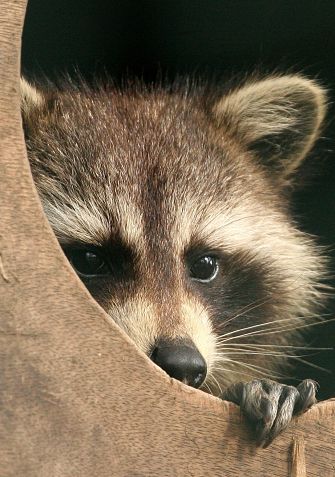
The clever, busy and beautiful raccoon is a very common sight across much of North America. They can be found in woodlands and farmlands, but they have also adapted to a variety of human habitats including suburbs and big cities.
Raccoons are mostly nocturnal, highly intelligent and will eat just about anything, so making their way through an urban environment is not challenging.
Their main requirement in any habitat is a water source. Raccoons are rarely found denning more than a few hundred yards from some constant source of water.
Streams and ponds are ideal, but in urban and suburban situations raccoons will make use of fountains, backyard pools and koi ponds.
The raccoon is a carnivore which enjoys catching lots of very small prey including insects, mice, birds and fish. They have been seen fishing with their hands, and will catch toads and turtles and crayfish with their front paws as well, coming in quickly with a kill bite lest their quarry escapes their grasp.
The raccoon does not have opposable thumbs, and in fact, their front paws do not look human, or even primate. They are similar in shape to a weasel or ferret paw, but there is no webbing between the front toes at all, giving the digits the look of fingers.
The "pinkie" finger and "thumb" are offset from the middle three digits and can come together across the middle of the palm allowing the raccoon to grasp things and manipulate items with reasonable strength and extreme dexterity.
Raccoons have been know to unscrew jars, undo locks and untie knots. The combination of bright mind and dexterous paws is highly effective and the raccoon has a reputation as a master thief and garbage-can ransacker.
Many a homeowner has spent their spare time in a backyard war with the unstoppable neighborhood raccoons, who somehow manage to get into sheds, feed bins, dumpsters and doggie doors defying all manor of bungee cords, twist ties, latches and ropes.
Once considered to be in the bear family, the raccoon is now placed in the family Procyonidae which includes the coatimundi and the kinkajou, both from South America. The raccoon is further separated into its own genus, Procyon, which includes 7 species of raccoon distributed across North and Central America, that vary only slightly in size and color. - Raccoon Facts
Do Raccoons Wash Their Food?
Although some consider the raccoon simply a common pest, it is actually anything but common.
Raccoons have several very unusual physical specialties that make them unique in the animal world, including a wildly advanced tactile ability that is highlighted by their having whiskers on their toes!
These whiskers are called vibrissae and extend just beyond the raccoons front claws. Like the whiskers on many animals faces, they transmit information when the tips touch an object.
In fact, the raccoon’s sense of touch, and in particular sensory input from the forepaws takes up more than 65% of the section of the brain that processes all sensory input. Raccoons are analyzing their world by feel and it is its most important and specialized sense.
The furless palms of the front paws are protected by a thin layer of horny skin - somewhat like a callous - which becomes soft and pliable when wet. This added sensitivity to already hyper sensitive hands, may be why raccoons are known to wash their food in water before eating it.
It may be a way for them to better "feel" and in a sense "see" what they are about to eat.
Raccoons will use the washing motion that they use with food items with inedible items as well, and will wash things they have no intention of eating.
They will also move food around in sand or snow prior to eating it if water is not available.
It seems that the famous washing motion is more of an aid to the raccoons senses, perhaps even heightening its enjoyment of its food, as we enjoy the aroma of a good meal while we dine.
Statements to the effect that raccoons must wet their food because they have no saliva glands are not correct.
Raccoons have saliva glands, and are capable of eating and digesting all kinds of foodstuffs without placing it in water first,(there are untold numbers of hidden-camera videos of raccoons stealing dry dog or cat kibble in the middle of the night and downing it quite happily without any water), they just seem to prefer, and enjoy, "washing" their food first. - Raccoon Facts
Raccoon Reproduction
Like many animals of greater intelligence, raccoons are considered to have a fission-fusion society where larger groups break off into smaller units and solo animals and may come together again at different times of the day or throughout the year.
Raccoons usually live in some sort of borrowed home. They do not dig a den like a badger does, but may use a badger den or abandoned rabbit den, or may drive those residence off in order to use their burrows.
Raccoons also regularly use holes in trees or any other kind of natural cave to bed down in. Raccoons may have several different den sites and may share one or all of them with other raccoons.
Females come into season once a year, and males and females will pair up for a few days, but the male leaves after mating and is not involved in the rearing of young.
Babies are born in about 65 days and are very lightly furred with tightly shut eyes and ears. Babies have faint masks around their eyes even when newborn, and their tail rings are visible at about five days old. The youngsters are active and venture from the nest at about 5 weeks.
They quickly learn to scavenge for just about anything, and by 5 months old can hunt mice or birds on their own.
Raccoon babies walk in single-file behind their mother like little ducks.
Cubs will leave around the time that a new litter is due, although females sometimes stay in close vicinity to their mother and may continue to share a den. Young males occasionally form small bachelor groups, but in general, the society is rather free-form with overlapping territories and casual socializing.
It was once thought that raccoons are solitary animals, but recent research suggests even adult males socialize with each other from time to time. - Raccoon Facts
The Urban Raccoon
One obvious testament to the raccoons intelligence has been its ability to adapt to urban environments.
These fairly sizable woodland creatures, who should be happily climbing trees and running down hills, have made their way into almost every major city in their habitat, tiptoeing across telephone poles and sliding down drainpipes instead.
Raccoons are conspicuously nocturnal in urban situations where they stay completely hidden during the day and invade dumpsters and parking lots by night.
The real problem arises when the common citizen is faced with an animal that is able to squeeze into locked garages, open secured garbage cans, unzip tents, and pry up Tupperware lids.
The suggestion is that society is actually making raccoons smarter and that these expert problem solvers are actually evolving faster than the supposedly raccoon-proof gadgets we devise. Urban raccoons are actually getting larger as well, coming in at about 15% to 20% heavier in cities than in the woods.
In the 1970's a Japanese childrens cartoon starring a rascally raccoon became so popular that the animals were exported by the hundreds for the pet trade.
So many of these difficult pets were released into the wild that there are now estimated to be hundreds of thousands of raccoons established in the cities and towns of Japan.
The raccoon has no natural enemy in Japan and has become an extremely destructive force causing destruction to temples and significant historical buildings throughout the nation. Over 10,000 raccoons are captured and killed in the nation annually but with little impact on the problem.
One concern many people have involves raccoons carrying rabies. Although raccoons, like many animals, can contract and pass rabies, there has never been a raccoon contracted reported case of rabies in a human being. This may be because of the high vigilance with which people treat any encounter with raccoons.
A raccoon, especially when cornered or threatened can be extremely aggressive and bite and scratches do occur, but these injuries are almost always aggressively treated, possibly curtailing the possibility of a rabies event. - Raccoon Facts
How Smart Are Raccoons?
So just how intelligent are raccoons? Although they have been replaced by the rat as the animal of choice for experimentation, between the years 1907 and 1915 the raccoon was the subject of numerous high-profile experiments.
A psychologist by the name of Lawrence W. Cole, who studied an entire colony of raccoons established at the University of Oklahoma, and a doctoral student at Clark University named Herbert Burnham Davis, both published results on experiments using a puzzle box.
Raccoons were placed inside boxes that required a number of manipulations to escape, and the results were not only fascinating, but extremely controversial for the time.
The studies suggested that raccoons were far superior to either dogs or cats at these skills, and possessed reasoning and problem solving skills on a primate level.
These suggestions caused an uproar in some scientific circles, and soon after raccoons became a bit of a taboo subject.
The concept of behaviorism was more in favor, and emphasized how animals could learn behaviors through conditioning. like the famous "Pavlov's dog" experiments.
Behaviorists viewed animals as machine-like creatures that didn't possess reasoning minds, but were just responding to stimulus.
Lots of folks will argue to this day that animals don't "think", not taking into consideration that humans - just like all animals- can also be trained to salivate at the ringing of a bell.
But even John Watson, the famed psychologist who started the entire field of behaviorism, admitted that the raccoon experiments seemed scientifically valid, and he could not find a behaviorist explanation for their incredible abilities. - Raccoon Facts
A Few More Raccoon Facts
- A group of raccoons is called a "nursery" or a "gaze" of raccoons
- The word raccoon comes from a Powhatan Native American word meaning "scrubs with hands"
- Raccoons were once thought to be tiny bears.
- Christopher Columbus was the first to put observations about this fascinating animal down in writing
- Raccoons have whiskers on their front toes!
- Raccoons do not have opposable thumbs, but their "pinkie" finger and thumb can meet across the palm.
- Raccoons are born with very fine fuzz, and faint little masks around their eyes
- The "raccoon dog"looks remarkably like a raccoon but is not related to the raccoon - it is in the canine family.- Raccoon Facts!
Polar Bear Facts
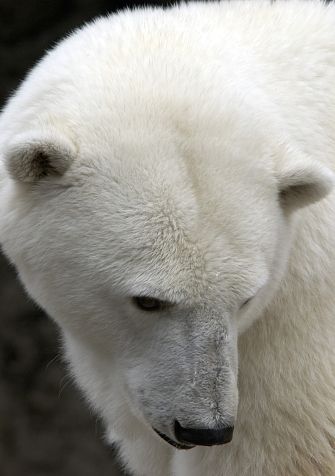 Portrait of a Polar Bear
Portrait of a Polar Bear
The polar bear is the largest of the eight bear species, and the largest land dwelling carnivore. Polar bears live across the frozen northern cap of the world called the Arctic circle.
They may be found in the U.S.(Alaska), Norway, Canada, Russia, and Greenland on numerous frozen seas and bays. They spend the majority of their lives on water- either frozen sea ice cap or the ocean water itself, only rarely touching true solid earth in the short Arctic summer.
Having evolved from the brown or grizzly bear only some 100,00 years ago, the polar bear has specialized teeth, fur and foot structure, that allows it to survive and flourish in a harsh, frozen world.
The polar bears eyes have adapted to see well under water, and this huge bear can swim like a fish, diving if necessary, and holding its breath for up to two minutes at a time.
The semi-webbed front paws have become huge paddles in the sea, and sturdy, skid-free snowshoes on the ice cap.
Once a forest-dwelling omnivore, todays polar bear is a true carnivore, dining on very large prey like seal and elk, and is so dependent upon the sea that it is considered a marine mammal.
Capable of swimming dozens of miles without rest, and surviving for months in sub-zero temperatures without a meal, this is a very rugged animal, whose personality and playfulness defy its circumstance.
Bears are considered the most intelligent order of mammals after the great apes, the whales and the elephants, and although they have a fearsome reputation, polar bears actually rarely attack humans, and are not particularly aggressive with each other either.
They also make some of the most fiercely protective, loving and snuggly mothers in the entire animal kingdom. - Polar Bear Facts
The Polar Bear Club
The polar bear has numerous special physical traits that allow it to survive in its Arctic environment.
While there is nothing unusual about regional factors causing evolutionary changes, what is unique about the polar bear is the relatively short length of time that these adaptions took place.
Fossil remains of polar bears only begin to appear about 100,000 years ago, when brown bears venturing north began to develop new biological tools that helped them cope.
With each successful evolutionary step, these bears were able to withstand and overcome more obstacles. Changes to coat color and the composition of the fur were probably some of the first adaptations.
Animals with lighter coloration were naturally more successful in the stark white conditions of the Arctic. Since they were able to avoid detection - an aid in both defense and hunting - light colored brown bears were more likely to survive, and the darker color was slowly bred out.
Other winter wonderland changes include an elongated body and head, tiny tail and ears, and massive feet for a snow-shoe effect, and for paddling in icy waters. - Polar Bear Facts
Polar Bear Reproduction
Polar bears mate in the early spring when they come together at the seas edge during fine hunting season.
Once a male finds a receptive female he may have to fight off other males to retain her company. Occasionally these battles are very violent, but usually they are more of a wrestling match to demonstrate strength and superiority.
When paired up a couple may stay together for a week or more, courting, playing and copulating often. Interestingly, the female does not begin ovulation until after being courted, and it is these days of sexual activity that induce ovulation.
In another very unique aspect of polar bear reproduction, the females fertilized eggs will actually remain in a state of suspension, not growing or developing for the first four full months of pregnancy.
During these vital months, the female must eat as much as she can, and will usually double her body size, gorging on seal blubber to the tune of an additional 400 pounds before her babies even begin to grow! She will need this mass for the most critical time in any polar bears life, for what mother does now is truly astounding.
Sometime in the fall, September or November, the pregnant female will dig a massive snow cave for herself, and once she settles in, she will not venture out again for 4 to 5 months, not even to eat.
She does not hibernate, which would require a slowing of the heartbeat, but her metabolism does slow, and in the dark of the den, in the dead of winter, after 6 months of pregnancy, she gives birth to her tiny cubs.
Twins are typical, although up to four cubs are possible, and these babies are only about the size of a guinea pig.
Exhausted and starving, the mother emerges from the den in the spring with her vulnerable troop in tow, and sets out on a long journey back to the ice leads.
These first months are extremely dangerous times for cubs, and the survival rate is very poor.
After almost three years with mom, the young bears will leave her company. Polar bears have a very slow reproductive rate, and the care and skill of the mother bear is extremely critical.
Because the factor is so vital, the maternal instincts are extremely strong, and mother polar bears shower their cubs with love and affection. - Polar Bear Facts
What Do Polar Bears Eat?
One major difference between polar bears and brown bears is diet.
Brown bears are omnivorous, eating a wide variety of foods including items as small as berries and moths.
The polar bear is almost entirely carnivorous. While they will eat things other than meat when available, they otherwise consume seals.
They don't even eat a large variety of seals, mostly just ringed seals and bearded seals. These two species of seals live under the ice during winter months, coming up for air at breathing holes throughout their range.
Occasionally the seals will come out and rest on the ice beside the hole, but usually they are nabbed by a lurking polar bear the moment they poke up out of the water for air.
During the spring these seals are forced to come out of the water to mate and raise their young. These weeks are critical for polar bears, especially females with cubs, who must hunt as many seals as they can to fatten up for the summer months.
Once the summer thaw comes, the polar bears world melts away and the dining room is closed.
Polar bears are forced to fast for two months, munching on whatever pittance they can find on dry land till the Arctic seas freeze over again.- Polar Bear Facts
Climate Change And The Polar Bear
Today, our beautiful polar bear is in danger of extinction.
Climate change is causing massive changes to their environment. As the sea ice thaws earlier and earlier in the season, polar bears have a much shorter time frame within which to hunt the seals they exist on.
Normally the bears are able to fatten up on seal pups during springtime. It has always been a race for them to gorge as much as possible because as spring comes into bloom the sea ice melts, and the seals return to open water.
Traditionally, large populations of polar bears have gone without food for the summer, but have had enough fat stores to survive.
Now, with a shorter winter, polar bears are starving to death, and populations, particularly in the southern regions, have declined as the climate rises.
A polar bear in a green environment is probably a hungry bear, and their environment is getting greener every year. Because of this, the polar bear may soon be in critical danger of extinction in the wild - Polar Bear Facts.
A Few More Polar Bear Facts
- The polar bear is the largest land carnivore
- Polar bears spend about 90% of their lives in - or on- the water, walking, running, and rolling around on the frozen ice cap, which is - after all- not land, but sea!.
- Polar bears and brown bears occasionally inter-breed in the wild. Some think their reddish-colored offspring are mistaken for Bigfoot!
- A polar bears fur is not white - the hairs are actually translucent
- Polar bears have black skin.
- Polar bears can smell a seal coming up for air over 1/2 a mile away.
- A new-born baby polar bear is smaller than a guinea pig Amazing Polar Bear Facts!
Giant Panda Facts

The giant panda is one of the world's eight species of true bears.
Although for a number of decades there was some controversy over whether the panda was actually a bear at all, the recent consensus is that the panda is, in fact, all bear.
.Some scientists argued that the giant panda and the red panda which share many characteristics were both more closely related to raccoons than bears. Closer study of the giant pandas molecular structure, however, puts them in the family ursidae - the true bears.
Giant pandas live in the densely vegetated mountains of central China, where mist, heavy rains, and high humidity promote thick forests.
The panda dines almost exclusively on one type of plant material, bamboo, which makes up over 95% of its diet. On rare occasions pandas will consume other types of plants, small animals, or insects, but the bamboo diet is so dominant, and has been consumed by the panda for so many thousands of years, that it has evolved into a bamboo eating machine, and has even evolved special paws with bony "pseudo thumbs" for handling bamboo shoots.
The giant panda lives a solitary life and each individual marks, patrols and maintains its own territory. Giant pandas will actively avoid each other upon seeing or hearing another nearby, and females in particular will chase strangers out of their range and then actively and agitatedly re-mark the boundary lines with claw scratches, sprays of urine and strategic droppings.
Pandas will occasionally enter caves or hollowed out trees to sleep or den for a few days but do not have permanent living arrangements. They do not hibernate as some other bear species do, but they will make short migratory moves to warmer climates depending on the season.
Although not officially the national symbol of China, (the dragon is) the giant panda can be found on many Chinese coins and its likeness even appears on many of the nations official government documents. -Giant Panda Facts
The Giant Panda Bear Club
With such a limited diet and such high dependence on the delicate ecosystem of the bamboo forests, the Giant Panda has been critically endangered for many decades, but vigorous efforts by the Chinese government have managed to maintain the wild population.
In fact, the punishment for killing a wild Giant Panda is twenty years hard labor. The lesson here? Cute counts! - Giant Panda Facts
Giant Panda Reproduction
The giant panda reaches sexual maturity at 4 to 7 years. The female ovulates once a year and there is only a 2 to 3 day period during which she can conceive.
The pair will only remain together a matter of days. The pregnancy will last about 4 1/2 months. The newborn baby panda is a writhing, red, hairless creature the size of a cell phone bearing very little resemblance to its mother.
With the exception of kangaroos and some other marsupials, a brand new baby panda is the smallest new-born in relation to it's mother's body - only about 1/1000th of her size! It is extremely difficult for the mother without the benefit of a marsupials pouch, to protect the precious offspring, and though twins are often born, perhaps in anticipation of difficulties in the early months of life, it is very rare that both siblings survive.
The giant panda, like all bears, has a very slow reproductive rate, so the survival of the remaining cub is critical, and panda mothers are vigilant parents who will defend their cub with great ferocity and fearlessness. Close and cuddly, the young giant panda will stay with its mother for about 3 years before heading out on its own. - Giant Panda Facts
The Red Panda - A.K.A. "Firefox
The red panda, sometimes referred to as the "lesser panda" or "firefox", was originally considered to be a type of raccoon.
More complex study of its gene structure has recently placed it in its own family, Ailuridae as the only member, although it is still classified within the super-family Musteloidea, a classification of animals that includes raccoons, but also skunks and ferrets.
Centuries ago the red panda and the giant panda were thought to be related because the red panda shares some of the giant pandas unusual traits. It dines on bamboo, also has a false thumb, and lives in territory that overlaps that of the giant panda, but this is the result of "concurrent" or" convergent" evolution not because the animals are related species. - Giant Panda Facts
What Do Pandas Eat?
All bears were true carnivores at one point in their evolution, but all bear species except the polar bear have turned to different diets to survive. Teeth in the back of the jaw that were once sharp cutting and tearing instruments developed into flat- molar type grinders to process once inedible materials.
The pandas switch to bamboo as the staple of its diet happened thousands of years ago for reasons one can only theorize, but it most probably saved it from extinction. Its teeth have slowly changed, and its stomach acids and saliva have evolved a new chemistry that breaks down the woody plants, but much of its body remains unchanged.
Because it originally evolved as a carnivore, the giant panda is now a meat-eater surviving by ingesting plants. The giant panda spends most of its waking hours eating bamboo, often in a fully reclined position.
They consume about 30 different species of bamboo so there is at least some variety in taste. And there are different edible parts of the plant as well. Giant pandas can be found munching on fresh new bamboo shoots in the spring, bitter green bamboo leaves in the summer, and tough and chewy bamboo stems in the winter.
Driven to consume as much as 50 pounds of raw bamboo a day to sustain it's massive body, but without the furnace-like stomach of a horse, cow or rhino to burn the limited nutrients that bamboo provides, the panda is a lethargic, slow-moving animal, and even cubs are more likely to just tumble around on the ground than lift their bodies up into a run or a jump. Ultimately, the life of a giant panda has one giant theme: lie down and eat! - Giant Panda Facts
The Pandas Pseudo-Thumb
The panda dines almost exclusively on one type of plant material, bamboo, which makes up over 95% of the diet. However, if you look at the teeth, stomach and digestive system of the panda, it would appear to be designed to consume a mostly meat diet. Large sharp teeth for tearing flesh, and the stomach chamber required to digest a deer, not a stalk of bamboo.
What evolutionary crossroad caused the panda to alter it's diet so drastically? We do know that this once carnivorous bear has been eating bamboo for so long that it evolved a small knob of bone at the perimeter of each paw that allows it to maneuver the sometimes unruly stalks of bamboo.
Called the "false thumb" or "pseudo thumb" it developed on the front paw which is large and flat with five digits all facing in the same direction- no opposable thumb. The knob is an extension of the small sesamoid bone in the wrist. Located at the bottom corner of the paw, opposite the five digits, it allows the panda to grasp slim bits of bamboo almost as if it had hands. Amazing!
A Few More Giant Panda Facts
- Although scientists have debated for years about this one Giant Panda fact, recent DNA research has proved that the Giant panda really is a true bear.
- The giant pandas diet is over 95% bamboo
- A newborn panda weighs only 3 to 5 onces and is 1/1000th the size of its mother!
- The red panda or "firefox" is more closely related to a ferret than to a bear.
Otter Facts
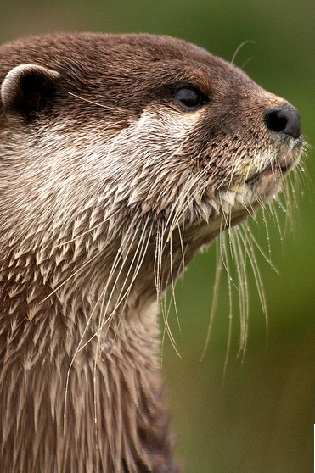 Portrait of a River Otter
Portrait of a River Otter
The coolest of all otter facts is that they use tools to crack open the shells of crabs and clams. Furry, playful and very, very smart, otters are beloved for their adorable antics and sweet appearance. Otters regularly engage in many activities that appear to be positively precious, for instance, sea otters may hold eachothers hand to keep from floating away from eachother.\
They will also wrap themselves in seaweed for the same reason. And river otters love to play on slippery rocks or ideally, snow banks, which they will body-surf down the length of, running back up to the top to do it all again. Their antics appear on memes, go viral, and can definitely make you smile, but looks can be deceiving.
Otters are members of the mustilid, or weasel family which includes skunks, wolverines and the honey badger, an animal considered to be one of the toughest creatures on Earth.
Otters are tough as nails too, and well known by zoo curators and wildlife specialists to be dangerous to handle. They are true carnivores, and have powerful jaws that can crack open clam shells with large, curved canine teeth for snagging salmon. Sea otters even have retractable claws on their front feet, which keeps them particularly sharp.
There are 12 species of otters, (13 until the Japanese river otter was declared extinct in only 2012), found all over the world except Australia and Antarctica.
Some are almost exclusively aquatic, like the sea otters that live in the Pacific ocean, and some spend more than half their time on land, like the giant otter that lives in the tropical rain-forests of South America. They all eat fish, clams, lobsters and small animals occurring along the shore. Giant otters regularly feed on piranha, and have also been known to take down alligators.
The smallest otter species is the oriental or Asian small-clawed otter, a beautiful, expressive little otter that doesn't weigh much more than 10 pounds or so. Small-clawed otters live in family groups of 6 to 12 individuals. They have, as the name suggests, small nails on their paws that are shorter than the length of the digits. They are found in wetlands and along lake and river banks throughout the south of Asia, but their numbers are dwindling as habitat is lost.
The European otter, also known as the Eurasian otter, or the common otter, has the widest range of all otter species. They tend to be more adaptable than other otter species, and can survive on a large assortment of foods from fish to crab to muskrats and young beavers. They can be found throughout all of Europe, many areas of Asia, and some territories in northern Africa too. These otters are basically solitary, and very territorial. They are active both day and night hunting both in and out of the water.
The giant otter is the longest of the otters, sometimes reaching 7 feet from nose to tail, and weighing up to 85 pounds, but sea otters are much stouter and large male sea otters in particular are bulkier and heavier than giant otters. Giant otters are the most social of the otter species and have a lifestyle that is somewhat similar to wolves in that the group has an Alpha pair that are the only members who mate and reproduce. They also hunt in packs like wolves and have been known to kill and eat caiman, monkeys and anacondas, but fish is their main meal.
The North American river otter is a medium sized otter about 3 to 4 feet long from nose to tail and weighing up to 40 pounds. They usually live in small groups, but may be solitary as well. These otters eat a variety of fish, invertebrates and small mammals including the occasional rabbit. They are notorious for body surfing down snowy hills.
The sea otter is the heaviest of the otter species with large males weighing as much as 100 pounds. They are marine mammals, existing almost exclusively in the Pacific Ocean, and rarely coming ashore. They float on their backs with their feet out of the water, and dine on shellfish while using their bellies as plates.
Sea otters use rocks obtained from the ocean floor as little anvils they can crack clams open with. This tool use involves the selection of a suitable rock, and the storing of it in the loose skin under the forelimbs. Storing the tool while diving or resting is particularly intriguing evidence of intelligence, suggesting a bit of long term planning - very smart!
River Otter Facts
River otters are long-bodied, well-muscled animals, with relatively short legs, five webbed toes on all four feet, (most carnivores have 4 toes on the rear foot), and a long flat tail used as a rudder in the water. The head is broad and somewhat flat with small ears and a powerful, well defined muzzle framed by very long, highly sensitive whiskers, called vibrissae.
The river otter is agile in water and on land, in fact there are two different names for a group of otters - a raft of otters if they are in the water, and a romp of otters if they are on land. They swim using their webbed paws as flippers, and for added speed they will undulate the torso like a dolphin. On land they use a rolling gait like a horses canter, or hop-like movements. They can climb rocky areas and steep shorelines fairly well, and they will regularly slide down appropriate surfaces as a happy short cut.
Although some species of river otters are solitary, most are social, playing, sleeping, and sometimes even hunting together. They require a permanent water source and maintain territories of a few square miles revolving around a lake or river. Some species are very territorial and mark the perimeter of their territory with piles of scat, called spraint.
Many of the river otter species look alike with medium brown fur and similar shaped heads and faces. The giant otters however, are fairly distinctive, with noticeably darker fur that looks almost black when wet, and a unique, round head shape. The muzzle is much more blunted, and the eyes sometimes have a bulging appearance. The giant otter has an unusual nose as well, because it is furred and looks almost like the nose of a monkey.
All river otters are designed for semi-aquatic life. Most have webbed toes, but all have incredibly dense fur that has water-shedding qualities, and is still used to make coats, boot and glove linings, and hats.
Most river otter species are in danger because of their need for a specific habitat. As human encroachment increases, they may all suffer the fate of the recently extinct Japanese river otter. Once numerous, but last seen in the wild in 1979, the Japanese river otter was officially declared extinct in 2012 by the Japanese Ministry of Environment.
River Otter Lifestyle
River otters spend equal amounts of time on land and water, and will build a den, called a holt, on the banks, or sometimes in the middle of their lake or stream. Holts may be a burrow, dug directly into the ground, with several entrances, and exits both underwater and on land, or converted beaver dens that otters may add their own flair to. Some holts are caves or stone outcroppings that the otters will partially enclose with a collection of sticks.
Depending on what food is available, otters may forage across a territory of several square miles, eating any small animals within their grasp, from baby bunnies, to insects and grubs, to frogs, snakes and turtles. They will often forage alone, but sometimes hunt in groups, and have been known to attack animals larger than themselves if the numbers are on their side. This was discovered by the Bronx zoo recently, when a group of otters swarmed on a monkey that was being housed in the same exhibit. The otters worked as one swift and merciless unit, and displayed a bit of frenzy behavior.
Giant river otters are the most social of the species, and display the most organized cooperative lifestyle. They live in a pack-like community, with an Alpha pair, their offspring, and assorted relatives, and go out hunting as a group, taking down animals like small deer and rabbits, but also dangerous stuff like anacondas and caiman.
River otters are extremely playful and engage in lots of social bonding, mutual grooming, wrestling and snuggling. The whole family may take part in the rearing of young. Most river otter species are generally monogamous and they may even mate for life.
Females give birth to 2 to 6 babies called pups, that are well-furred, but otherwise helpless with closed eyes and ears. They stay in the den with their mother for several weeks, during which time she may be brought food by family members, and some trusted assistants may even babysit while the mother goes out for a bit of fresh air.
The pups eyes will open at about 4 weeks, and they will begin venturing out of the den at 6 to 10 weeks. River otter mothers have been known to push or drop their youngsters in the water to teach them to swim, which comes naturally of course. Most baby otters are fishing on their own by about 4 months, but they will stay with mom for at least a year.
Some young otters will remain with their romp for life, others will head out on their own when they are between 1 and 4 years old to establish a territory.
Sea Otter Facts
There is one species of sea otter and three subspecies, the California or Southern sea otter is found off the central coast of California, the Northern sea otter is found in the waters off Alaska and Canada, and the common or Asian sea otter is found along coastlines of Japan and Russia.
Although giant otters can be quite a bit longer, sea otters are far bulkier, heavier and ultimately largest species of otter. They are actually the largest member of the weasel, or mustelid family, but they are considered the smallest marine mammal. They can spend almost their entire lives in ocean waters, rarely coming onshore. They sleep, eat, mate and give birth in the water.
Sea otters don't venture far from shore, and spend their days diving to the ocean floor to scrounge up any number of different sea creatures. They prefer clams, mollusks and crab, using their muzzle full of sensitive whiskers and their dexterous, retractable claws to search through coral and kelp.
They take dives an average of 90 seconds long, but can stay under for over 4 minutes. They can store a few food items and rocks in the loose skin under their forelimbs that form pseudo-pouches, tucking away as many as a dozen clams or other small items.
When they surface, they float on their backs and use their belly as a lunch counter. They empty their pouches and pile their clams and crawfish on their chest, pull out a rock they picked out of the sediment, and proceed to grasp each shellfish with their front paws, bashing it against the rock to open it.
Sea otters are perfectly designed for life in chilly, sometimes frigid water, and they exist in some of the coldest regions of the world, spending over 90% of their lives in the desperately cold ocean. They have the densest, basically warmest fur of any mammal, including their relative the mink, but the fur must be kept meticulously clean in order to do its job.
The one-million-hairs-per-square-inch coat keeps them warm with its own thickness, but also serves to trap a layer of air between it and the otters skin, acting like a puffed-up parka and a life jacket at the same time. The insulation only works if the fur is clean, straight and free of any foreign material so the otter spends about 1/3 of its life grooming, but its a matter of life and death. If the fur gets dirty, the otter won't float, and will loose body heat. A sea otter that has been soiled in an oil spill will die without intervention.
This incredible fur almost led to the near extinction of the sea otter, which was hunted down to only a few colonies. Fortunately, Russia, Japan, Canada and the U.S. signed a treaty to ban the hunting of sea otters and fur seals in 1911, and the recovery of the species has been, for the most part, a success.
Sea otters are a little like seals in that they may be found in very large groups, floating in the water in what is called a "raft of otters", but don't have particularly close relationships, or friendships.
Sea Otter Reproduction
Male and female sea otters generally live in separate groups and come together during mating. Dominant male sea otters claim territories and defend them from younger, older, or less aggressive males. The dominant males will mate with all the females in their territory, and sometimes try to steal or lure females away from other males.
Mating itself is often forced on females. Male otters will bite and hold females by the face or nose in order to mate with them, and researchers actually identify some female sea otters by the scars they have received from violent males.
The female is pregnant for about 4 months and gives birth in the water. Baby sea otters are born quite precocious, or well-developed. They are fully furred have eyes and ears open and are fairly active shortly after birth. The babies fur is a different texture from the adult coat, and the mother pays special attention to grooming the newborn, pulling the fur away from the body and fluffing it out.
The fluffy baby fur is designed to trap air, and once fully groomed by the mother, the newborn baby otter will actually float on the surface of the water, essentially unable to drown, but also unable to swim or dive. The mother will leave the baby on the surface while she dives for food, often safely tucked in a bed of floating kelp. Some mother sea otters have also been observed hoisting their babies up on boat decks or docks to rest while they dive.
It takes 12 to 14 weeks for the adult fur to grow in, the last 2 to 3 weeks of which time the baby slowly loses its extreme buoyancy, and begins to experiment with diving and foraging itself.
The sea otters unique feeding style and fascinating tool use are passed down from mother to baby. Babies are taught to choose stones from the ocean floor that are the appropriate size - large enough to be used as an anvil, small enough to be tucked under the arm and carried to the surface. Otters may also use stones at the ocean floor to knock abalone and other crustaceans free from coral beds.
Mothers teach babies the proper selection of food items as well, and will even hunt and forage in areas with smaller creatures that the baby can manipulate, even though the mother otter would prefer larger prey.
Tool use in sea otters extends beyond stones. They use kelp to prevent themselves and their babies from drifting in the currents, and they also wrap crabs up in kelp to keep them from escaping.
All of these behaviors are passed down from mother to baby, and different uses and preferences for tools can be seen among different populations. It takes a long time to teach all this to a baby otter, and they don't have all the knowledge they need to survive until they are 6 to 8 months old.
A Few More Otter Facts
- Giant otters eat piranhas
- River otters love to body surf in the snow
- Mother sea otters wrap their babies in kelp or seaweed while they dive
- Otter poop has its own special name - "spraint"
- The sea otter has the densest coat of any mammal
- Sea otter fur has one million individual hairs per square inch
- Sea otters use rocks as tools to break open clams and crab shells
- The sea otter is the smallest marine mammal
- Fisherman in Bangladesh used trained otters to help them net the catch of the day
Orangutan Facts
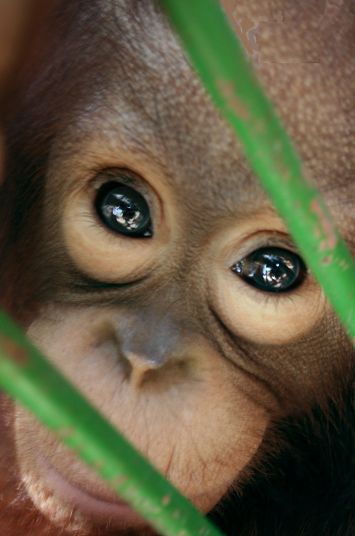 Portrait of an Orangutan
Portrait of an Orangutan
Although the word orangutan may sound like a reference to the orangutans orange colored hair, it is actually a combination of two Malaysian words "orang" meaning "person" and "hutan" meaning "forest".
These "people of the forest" are one of our closest relatives sharing over 96% of our DNA.
Orangutans are the largest arboreal animals in the world and spend the vast majority of their time in the rainforest canopy. They eat, sleep, breed and give birth, sometimes hundreds of feet above the ground.
They are climbing machines, with remarkably long and powerful arms, and feet with opposable big toes that have a grip strength 4 times that of a human hand.
Cumbersome and graceless on the ground, even the largest male orangutans are aerial artists in the trees.
Orangutans and tropical rainforests were once plentiful all across the Southeast of the continent of Asia, but today, only two small populations of two separate species of orangutan remain.
The Sumatran orangutan, which can be found only on the Indonesian island of Sumatra, is lighter in color with longer hair than the Bornean orangutan.
The Bornean species can be found only on the Malaysian island of Borneo. Bornean orangutans have darker hair and males have more pronounced cheek flanges that curve forward.
There is considerable sexual dimorphism in the orangutan with males generally growing to at least 2 times the weight of females.
Males start to develop large cheek "flanges" when they are in their teens. The flanges are thick pads of flesh that frame the face and develop more prominently in dominant males. Some less dominant males never develop cheek flanges.
The orangutan is the only member of the great apes that does not live in large groups. Females raise their infants and have their company for up to ten years, but adult males live solitary lives with little socializing.
Seasonally, groups of adults may come together at select fruit trees, and young females may "hang out" together for a few days at a time, but mostly these "people of the forest" are loners. - Orangutan Facts
The Spectacular Face
When it comes to examples of great ape masculine extreme, the gorilla has the silverback, the human being has 'The Rock,' but only the orangutan has the flange.
Young male orangutans look just like their female counterparts until about the age of twelve, and then they begin to develop fatty deposits on their cheeks in the shape of large semi-circles. They also develop a large deposit of fat on the top of the skull, and a large throat pouch that allows them to create very loud warning yells called "long calls."
The flanges of the Bornean orangutan in particular, are sometimes quite massive, and curl in towards the face. One theory on this curved shape is that it may act as a sounding board for the long calls.
Sumatran males flanges are smaller and flatter, but they develop a long "cape" of hair that hangs from their arms and looks very cool when they are swinging through the trees.
Adult male orangutans have loosely defined territories that overlap with other males, and usually includes the territories of several females with their infants.
The calls they sound out across the rainforest serve notice for other males to keep clear.
Occasionally confrontations occur, but are rarely serious. When fights between mature males do occur though, they often include them biting each others flanges.
The most interesting part of all of this, is that not all males develop flanges. There is no real understanding of why this is, but "un-flanged" male orangutans seem less dominant, and are often considerably smaller.
They may still find receptive females however, and so the flanged male is not really "alpha" in the sense that it dominates breeding.
In the most interesting twist to this orangutan tale, there have been several documented cases of orangutan populations in captivity that had one flanged male in residence. When he was removed or passed on, the unflanged male rapidly developed a full face of flanges - fascinating! - Orangutan Facts
Orangutans In Peril
The wonderfully expressive and soulful orangutan, is now limited to two tiny islands and about 60,000 wild individuals.
There are many different studies and conservation efforts occurring simultaneously to save the wild orangutan, but the task starts, of course, with saving the rainforests they call home.
Recently, the most pressing force against the survival of the orangutan has been the development of palm oil plantations.
Thousands of items that we use every day, from shampoo to ice cream, contain palm oil as an ingredient, and the demand is on the rise for this product.
Believe it or not, one of the reasons for the increase in the use of palm oil is the health craze in developed nations. The use of trans-fats in many notoriously unhealthy snack foods is being replaced with palm oil.
These plants are actually native to Africa, but are being grown and supplied to the industry enmasse by plantations in Borneo and Sumatra. In order to start growing the palm, thousands of acres of rainforest are burned to the ground.
Sometimes communities of orangutans and hundreds of other animals are killed in the process. Sometimes communities of indigenous peoples are displaced as well, and all for a healthier snack.
Orangutan Reproduction
The orangutan has a very long childhood, similar in length to humans and elephants.
It is probably one of the most intense mother-child bonds, and youngsters don't tend to "leave the nest" until they are about 10 to 12 years old. Mothers may have become pregnant and given birth to another infant while they are still caring for one, and little "families" of varying ages are not uncommon.
Although the dependency on the mother is very long, once they head off on their own, orangutans tend to become sexually active fairly quickly. Orangutans generally mate when the female is in cycle, but like human beings and bonobos, they occasionally engage in sexual activity of a more recreational nature.
Even pregnant females have been observed engaging in sexual activity.
Beyond that, and most unusual, orangutans regularly have intercourse face-to-face. Whales do this of course, but among land animals it was once thought that only humans had sex in this position.
Observation has revealed that both orangutans and their very sexy cousins the bonobos also have face-to-face relations, and while nowhere near as sexually active as bonobos, orangutans use this position more often percentage wise than any animals other than human beings.
Young female orangutans usually have their first infant at about 14 years of age. Males must wait a bit longer to mature, but a dominant young male who is aggressive, develops impressive flanges and begins to "long call" to announce his presence, can attract a willing female by the time he is 15 or 16.
Females cycle every month and are receptive for about 4 days, during which they will nest with the male of their choice. There are some altercations between males for territory and mating rights, and most older males display small scars and injuries as they age, often on their flanges.
These altercations involve loud bellows, slapping and biting, and a style of shoving similar to Sumo wrestlers, but are rarely, if ever, fatal
Once pregnant, the female prepares a particularly elaborate nest which may actually include more than one level for her to store food or just move about.
She gives birth 100 feet off the ground, and her newborn although wide-eyed and furred, is virtually helpless. Infant orangutans have one pressing goal- to grab onto mom as tight as possible.
They have long, strong fingers and toes that lock on the hair of their mothers chest and belly for the first two weeks, and then grasp her head, and neck hair for a ride on her back.
The youngster may be carried for up to four years, and will nurse for up to six. Mother orangutans spend time carefully teaching their youngsters the intricacies of rainforest life.
They chew fruits and offer bits from their mouth for the baby to sample.They demonstrate how to open a wide assortment of seeds and nuts. They move about their territory demonstrating where, when and which trees have the best bounty. They use simple tools like sticks that they have removed the leaves from to catch ants and termites, and they carefully demonstrate these skills.
Most importantly, they pass on the skills of nest building.
Nest building for orangutans is virtually an art, and they build the most elaborate nests of all the great apes, sometimes even including blankets and pillows.
Youngsters spend years learning the craft, first assisting mother, then attempting their own nest off to the side. At 8 years or so, many young orangutans are building their own nests every night and sleeping next to their mother.
The mastery of nest building is a major milestone for the youngster who will soon head out to start adult life..
A Life In The Trees
As the worlds biggest tree-dwelling animal, large male orangutans can reach heights of well over 5 feet and weights of over 250 pounds, but they are like slow-motion acrobats when they make their way through the rainforest canopy.
With all of their food sources in the trees, orangutans have little reason to come down to earth. The thick connection of canopy trees form a continuous highway above the ground sometimes miles long.
Orangutans get the majority of the moisture they need from their fruit-filled diet, but drink fresh rainwater that has collected in the crooks of trees and on large leaves as well The Sumatran orangutan almost never comes down to the ground, except when water is scarce.
The bornean orangutan spends a little more time on the ground, and even females with youngsters may occasionally be found on the forest floor.
The most probable reason for this difference is the lack of tigers on the island of Borneo. Tigers are by far the biggest predator of orangutans in Sumatra, but on Borneo the greatest threat to adult orangutans is crocodile, and youngsters who wander too far may occasionally fall prey to clouded leopards..
When they do come to the ground they walk on all fours and appear very cumbersome. They may also scoot about on their rumps.
Orangutans are not knuckle-walkers like gorillas and chimps but instead walk on their palms or balled-up fists. In the trees their long curved fingers and toes serve as hooks to latch on from branch to branch in a style of locomotion called "brachiation".
When making their way through thin vines or flimsy vegetation the fingers are so long that they can curl around smaller branches almost 1 1/2 times to secure themselves. The tops of the first two digits of each finger lock against the inside of the palm in an orangutan super-grip.
Infants are born with this gripping instinct and can hold on to thin strands of hair with ease.
Orangutan Intelligence
All the great apes are extremely intelligent creatures, but the question of which non-human great ape is the most intelligent is often asked.
Among the great apes the gorilla, the bonobo and the orangutan live relatively peaceful lives compared to human beings and chimpanzees, and it is certainly possible that levels of expected conflict in daily life create minds that emphasize different gifts.
The chimpanzee is an organized hunter, regularly uses weapons like clubs and rocks,, and is generally a more active and busy creature than the relaxed and slow-moving orangutan.
This outward spark leads many to believe the chimp is the brightest of the great apes, and in scientific experiments that involve food rewards, chimps excel, but this may be because their natural lifestyle involves strenuous competition for food.
A recent, in-depth study of orangutans done in 2011, shed some light on just how intelligent orangutans may be. At a research facility in Indonesia, scientists from the University of Manchester spent an entire year observing, documenting and filming orangutans building nests. The study concluded that orangutans possess complex knowledge of mechanical design and material properties.
They select specific types of limbs when constructing the base of the nest, smaller, more flexible branches for the sides, and even have multiple additional structures they may build such as blankets, pillows and roofs.
Their nest building skills are more complex than any of the other non-human great apes, and the techniques are carefully taught from mother to youngster.
The creation of pillows out of soft shoots, and blankets out of large leaves was unique to orangutans and the attention to detail was astounding.
Orangutans have long been known to use any available item - mostly palm leaves, as umbrellas during rain showers, but their specific style of nest construction involves a complex series of steps, including the gathering of the correct materials, that appears to represent truly advanced thinking.
A Few More Orangutan Facts
- A group of orangutans is called a "congress"
- The orangutan is the only great ape native to Asia
- Orangutans are the largest tree-dwelling animals in the world
- An orangutan has incredibly strong arms that are twice as long as its legs
- Adult male orangutans develop large "cheek flanges" that are thick pads of fat that frame their faces
- The orangutan is the only great ape that does not live in large groups
- Orangutans share about 96.4% of our DNA
- Orangutans love a fruit called Durian which smells like strong garlic
Opossum Facts
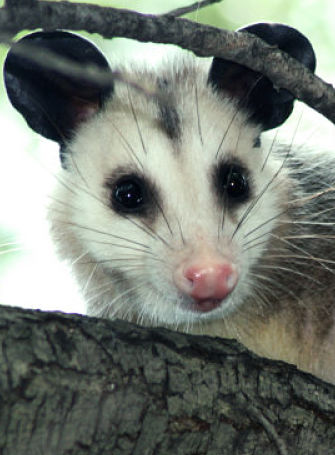 Portrait of a Common Opossum
Portrait of a Common Opossum
One of the coolest common opossum facts is that newborn opossum babies are only about the size of a raisin! The common opossum, also known as the Virginia opossum, is a somewhat maligned but fascinating creature.
What is a possum? Well, it is not a rodent, although it resembles a very large and slightly eerie looking rat, with a scruffy coat of coarse grey and white fur, and a flesh-bare tail. The common opossum lives in trees, can hang by its prehensile tail, and is the only non-primate to have opposable big toes, but it is not a monkey.
The opossum is actually a marsupial, which means opossum babies are raised in a pouch on the mothers belly, just like a kangaroo. The word opossum comes from the Algonquin Indian language, and is said to mean "white animal." The "o" is sometimes silent, and is often left out all together.
In fact, possum without the "o" is the common spelling and pronunciation throughout much of the United States, and there is little confusion in those circles when referring to the American animal, although it is scientifically inaccurate.
There are about 70 different species of marsupials called "possums" found in Australia and Indonesia, which are members of the zoological families Phalangeridae and Petauridae, including brush-tail possums and the little sugar glider often kept as a pet.
And there are over 100 species of marsupials called "opossums" found in the Western hemisphere, which are members of the family Didelphimorphia, including the common or Virginia opossum we will be covering here.
Opossum Rabies
Facts about possums often include claims that they are disease-carrying dangerous creatures. However, the Center for Disease Control reports that in the United States, the vast majority of recorded rabies cases come from the bite of 4 animals - raccoons, skunks, foxes and bats.
Rabies is a terrible virus that attacks brain function.
Sometimes, infected animals act erratically and show disturbing symptoms such as drooling, disorientation and aggression, but it can also be carried and transmitted by some animals without them ever actually contracting the disease, or showing any unusual behavior
Often, the first sign that an animal has rabies is a change in behavior patterns. When people see opossums out and about during daylight hours, they assume there is something wrong with the normally nocturnal animal. If you approach a opossum, they will greet you with a startling defense display, gaping their mouths wide, hissing and writhing in an attempt to intimidate, and this can be misinterpreted as rabid behavior.
Even the opossums classic defense of playing dead adds fuel to the perception that there is something very wrong, especially when they pick their head up to check if the coast is clear and then fling themselves back on the ground again if it isn't.
But despite all their weird behavior, it is considered very rare for the common opossum to contract, carry or transmit rabies. It seems the rabies virus thrives in animals with higher body temperatures than that of the possum. For instance, the normal body temperature of a raccoon is 102.8, while the opossums average body temperature is about 95 degrees, sometimes less.
This does not mean they are immune from rabies however, and a handful of opossum rabies cases are reported pretty much annually.
But, the common possum is a carrier of leptospirosis, a bacterial disease that appears to be a simple flu, but, If left untreated, can cause kidney damage, liver failure, respiratory complications and even meningitis. Leptospirosis is spread through the opossums urine and excrement, so keeping outside surfaces they may frequent clean, and making sure your pets are protected from exposure is a good idea. And if you see a possum out in your yard in the middle of the day, just assume it is out for a little stroll, but keep your distance anyway!
What Do Opossums Eat?
What possums eat has much to do with where they live. In rural or wild areas, they may be limited to local fauna and flora, but in towns and cities, they enjoy a host of foods provided by the humans that live there.
An extremely successful animal that has existed for thousands of years, the opossum has an impressive array of 50 teeth, designed both for ripping and grinding. Although they will often bare their teeth in a bluff display to ward off predators, they are really eaters, not fighters.
With large canines, pointy incisors, and powerful molars and premolars, the completely omnivorous opossum is prepared to consume practically anything.
The common possum is an intelligent, resourceful opportunist, and will eat fruits, vegetables, roots, tubers, worms, insects, small rodents, reptiles, carrion and roadkill.
They may raid garbage dumps and garbage cans, gardens, ponds and even chicken coops.
They don't just scavenge, but will actively hunt small birds and animals, and vigorously dig up insects they detect below ground or in hollow logs. They will use their strong claws and dexterous front paws to rip open burrows, have been known to hunt and eat rats, and will open food bins to get to goodies like dog kibble and cat food.
One of the most remarkable things possums eat are ticks. In fact, most opossums will remove and eat 90% of the ticks that try to bite them. A healthy opossum population can actually reduce the risk of tick-borne diseases such as Lymes, due to their unusual tick-hunting abilities.
Opossum Babies
The opossum is the only marsupial found in North America, meaning, like kangaroos and koalas, the female opossum carries her young in a pouch.
Opossums are generally solitary animals that come together only to mate. After just 12 days or so (the shortest pregnancy of any mammal in North America) the female gives birth to as many as 18 babies, called neonates, because they are still in an embryonic from.
They are incredibly small, only about the size of a raisin, and must make their way to the mothers pouch to continue to develop. Immediately after birth they are compelled to move in an involuntary swimming motion, across the mothers belly to her pouch, a trip of about 4 inches. Eyes and ears are not open, but their sense of smell guides them, and the mother opossum will lick her belly, making a trail for the opossum babies to follow.
The mother does not help them to the pouch, and some believe this may be a way of weeding out weaker babies. When they reach the pouch, called a marsupium, they latch on to a teat. Once latched on, the teat fills with milk, and the baby opossums are basically locked in place for 8 to 10 weeks as they continue to develop, protected from the outside environment.
The babies are remarkably safe inside the pouch, and are often found unharmed, even after the mother has been hit by a car. It is recommended that one always check the pouch for baby opossums in the event that a dead adult is found.
Once the opossum babies, called joeys, are old enough, they will ride on their mothers back, clinging with strong claws and their little prehensile tails.
Only baby opossums hang from their tails. Adult opossums are too heavy to support themselves with just their tail, instead, they use it as a sort of fifth limb while climbing.
Possum babies start off super small, but grow quickly and are mature and on their own by the time they are about 4 months old. Mother opossums often have more than one litter a season.
Other Possum Species
There are two entirely different families of animals called possums. The family Didelphimorphia includes the opossum discussed in this article, but there are over 100 other species in family. Only the Virginia opossum, also known as the North American opossum or the common opossum, is found in North America. The remaining species are found throughout Mexico and Central and South America.
Another zoological family not closely related to Didelphimorphia is Phalangeridae, which includes about 70 species of small marsupials. This group is referred to as "possums" without the "o".
Native to Australia and Indonesia, the old world "possums" include some very familiar little animals. The brushtail possum is the most wide-spread marsupial in mainland Australia, and is similar to the North American opossum in size. It also has a prehensile tail and spends a great deal of time in Eucalyptus trees where it feeds on leaves.
The beautiful little sugar glider belongs to the family Petauridae, another dozen or so little possums native to Australia, Indonesia, Tasmania and New Guinea. The sugar glider has a membrane of skin draped between the wrists and the ankles that act as a sort of parachute, allowing them to glide long distances between trees.
These animals have become popular pets as well, although one look at their massive eyes will tell you they are quite nocturnal, and that doesn't stop just because they are living in an apartment. Noisey nighttime activity, including lots of vocalizations is the number one negative of sugar gliders as pets, but if you don't mind a little action after midnight they can be very sweet and charming companions. No relation, however, to the Virginia opossum.
A Few More Common Opossum Facts
- Opossum rabies is actually more rare than in skunks, raccoons or foxes
- The opossum is often called possum, leaving off the "o"
- Old World "possums" and New World "opossums" are not closely related
- Opossums have prehensile tails and opposable big toes
- The opossum is not a rodent, it is a marsupial like a kangaroo
- Opossums raise their young in a pouch called a "marsupium"
- The common opossum is the only marsupial in North America
- Opossums "play opossum" or "play dead" to confuse predators
Monkey Facts
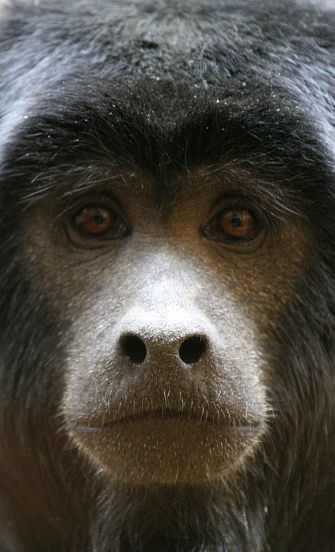 Portrait of a Howler Monkey
Portrait of a Howler Monkey
Monkeys, gibbons and apes are all primates, but belong in different families. The most obvious difference between monkeys and apes is that apes do not have tails.
A few isolated monkey species do not have tails either, but they are the exception rather than the rule.
The great apes, which are the human being, the orangutan, the gorilla, the chimpanzee and the bonobo, are much larger than monkeys and much more highly evolved.
The gibbon, which has many aspects of both monkeys and apes, is truly its own separate creature, although it is often lumped in with either apes or monkeys by virtue of many different arguments, both scientific and not so scientific.
We have separated the gibbons and offer their own article. We have also separated the baboon into it's own page because it is so well known, but the baboon is in fact an Old World monkey with the customary large size and non-prehensile tail..
Monkeys are highly intelligent and active primates that are broken into two groups known as Old World monkeys and New World monkeys.
The Old World monkeys (including baboons) inhabit Africa and Asia, and are more closely related to apes. They are generally larger than New World monkeys, have more elongated faces, and have a tail that is not "prehensile".
New world monkeys are five families of primates that inhabit Central America, South America and some parts of Mexico. New world monkeys are generally smaller, have more flattened faces and have "prehensile tails" which they are capable of gripping with.
The prehensile tail is slim, muscular and very long, usually longer than the body length, and can easily support the weight of the entire monkey. These tails often have a patch of bare rough skin called a tactile pad or friction pad, that helps in grasping objects.
While the tail is used primarily to assist in climbing and keeping the hands free for foraging and carrying, some monkey species will use it almost as an extra hand to hold and manipulate food items.
New world monkeys often use their tails to grab each other during wrestling and play, and will wrap their tails around each other for comfort.
The Old World baboons are the largest of the monkeys with males reaching almost 4 feet long and weighing nearly 80 pounds. The tiny pygmy marmosets of the New World rain forests are the smallest monkeys and can be as tiny as 4 inches and 4 ounces!
Of Monkey Hands And Tails
Old World monkeys are most quickly differentiated from New World monkeys by looking at their tails.
The Old World monkeys have non-prehensile tails that can not grip. The New World monkeys have long. slim prehensile tails that they may climb with and that they can carry and manipulate items with.
The most dexterous tail in the monkey kingdom belongs to the spider monkey. These monkeys can hold, carry and even catch items with their tails, and will gesture with them as well.
There is a small bare area of rough skin on the underside of the last vertebra in the tail. This "tactile pad" has many nerve endings like a fingertip, which aids in delicate tasks like peeling a banana.
The prehensile tail is surely a product of the New World monkeys densely forested environment. Most New World monkeys are largely arboreal, spending the majority of their time high in the forest canopy, and some never leave the trees at all.
While many Old World monkeys like the baboons, spend most of their time on the ground walking around on all fours like a dog.
Another area of monkey anatomy that shows some variety is the hand. All of the great apes have opposable thumbs meaning that the thumb can be swiveled around so that the pad of the thumb faces the pads of the fingers and can be brought together in a "pincer" grip.
Likewise, all of the Old World monkeys have opposable thumbs.
But many New World monkeys, including marmosets, spider monkeys and capuchins do not have opposable thumbs.
These animals thumbs range from completely unopposable where the thumb can not be rotated, as in the marmoset and the tamarin, pseudo-opposable where there is partial rotation of the thumb to the side of the hand, and a third situation, as in the spider monkey, where the thumb is actually a very small digit - only 15% the length of the other fingers, and has very little use at all.
The New World monkeys life high in the trees no doubt plays a part. Using all five digits together to encircle a branch with more of a cupping motion rather than grasping, seems more effective when speed and mobility are of the essence.
With a tail that is able to help as well as its hands, the spider monkey swings from limb to limb with incredible ease, and with a thumb that is always in harmony with the rest of the hand.
Monkey Reproduction
Naturally the mating habits of 260 different species of monkeys will present some variety.
There are some monkeys, like the proboscis, that live in groups with one male and a harem of females. Bachelor males may live either in small groups, or completely alone. Proboscis are similar to lions in that when a new male displaces the dominant male, he may kill the existing infants.
This is not the typical monkey lifestyle however. Most monkeys live in social groups from 5 to 30 individuals, and separate into pairs for a few days while mating takes place.
Often there is a change that signals both the males and females readiness to mate, including swelling of the genitals, and reddening of both the genitals and sometimes the face.
Females may mate with several males and usually give birth alone.
Some species, like macaques and baboons, give birth on the ground, but many others make nests up in the trees.
One infant is standard, and the baby will be held close to the chest for a few hours to up to two weeks before they graduate to riding on the mothers back.
Infant monkeys live exclusively on mothers milk for as many as three months, but even after starting solid food, they will continue to nurse for up to a year.
In some species, there is some mild cooperation within the group in the rearing of young, but the mother is mostly responsible, and most male monkeys do not treat their own offspring with any special interest.
Young monkeys are agile, active and incredibly curious. The most advanced monkey species have their own culture, including greatly varied "accents" to their vocalizations, even from troop to troop of the same species.
Little ones are taught social codes, local ways to gather and handle food, hunting techniques, seasonality of fruits and nuts, the safest places to sleep and eat.
Like humans and apes, monkeys have been seen to demonstrate actions in order to teach young ones. In one such instance a mother macaque was observed repeatedly washing a piece of fruit until the toddler caught on and began dipping his own lunch in the river. - Amazing Monkey Facts
Monkey Face
There are over 260 known species of monkeys, all of whom display their own distinct look. Colors and patterns, Mohawks and mono-brows, variations in eye shape, skull, nostril, and ear structure, bare skin to fur ratios, and overall proportions produce a slide show of differences unrivaled by any other animal group. Forward facing eyes and color vision no doubt played a part in the development of so many wonderful mugs! - Monkey Facts.
Marmosets And Tamarins
The marmoset genus is made up of 22 species of New World monkeys including the worlds smallest monkey, the pygmy marmoset. There are 16 species within the tamarin genus.
Marmosets and tamarins differ in jaw shape and skull construction but otherwise have a very similar appearance and lifestyle. They are the smallest monkey species and differ from other monkey families in several ways.
Their teeth are specially designed to strip open the bark of trees exposing the sap inside. Some marmoset species may get up to 70% of their diet from tree sap. Otherwise they will eat insects, birds eggs, flowers and fruits.
Marmosets and tamarins have more primitive brains than other monkeys, and they have claws on their hands and feet as opposed to the flat nails that other monkeys and apes have.
These beautiful little monkeys have an amazing variety of face and head decorations, from the flowing red locks of the Golden Lion tamarin, to the feather like extensions of the cotton eared marmoset, to the outrageous mustache of the emperor tamarin.
These monkeys almost always give birth to twins. Double adorable!
Different Monkey Species
The tremendous variety of monkey species lead to differing lifestyles, habits and appearance.
Many New World monkeys are largely arboreal and some, like the marmosets and Tamarins may spend their entire lives in trees, never touching the ground.
The largest of the Old World monkeys the baboons, have a completely different experience. Living similiar to a pack animal, moving in fairly large groups on the ground, walking usually on all fours.
They are still good climbers and will hunt small prey and gather fruits in the trees, but also scavenge around on the ground like dogs might, with their noses low to the ground.
Many of the Old World monkeys are built for life on the ground, with stronger, wider and more developed lower bodies, while the New World spider monkeys have tiny hips and legs as thin as their arms.
Most Old World monkey species sit down fully on their buttocks much as humans do when resting and eating giving them a sort of "little old man" quality, while the New World monkeys rest on flexed haunches, more like a cat.
While the majority of monkey species are diurnal - out and about by day- there is an entire family of New World monkeys known as "night monkeys" eleven nocturnal species who have large forward facing round eyes like an owl for night vision.
Equally diverse are the temperatures and habitats monkeys may be found in. Many monkeys naturally live in hot - even sweltering- desert or rain forest environments, but there are some species that live in ice and snow like Japans amazing macaques.
These monkeys range farther North than any primate species living in the highlands of central Japan where the snowfall is extensive. Also known as snow monkeys, they are known for bathing in the hot springs there, grooming each other meticulously while soaking up to their necks .
A Few More Monkey Facts
- A group of monkeys is called a "troop"
- Some Old World monkeys have cheek pouches that allow them to save food and chew it later.
- Many monkey species, like capuchins, use tools regularly.
- Only one monkey species exists in Europe, the Barbary macaque of Gibraltar
- Howler monkeys can be heard for 5 miles
- Some New World monkeys may live their entire lives in rain forest treetops and never touch the ground.- Monkey Facts
Meerkat Facts
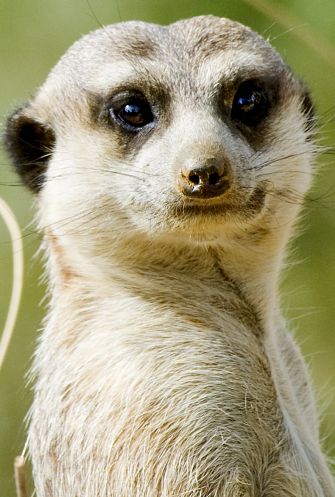 Portrait of a Meerkat
Portrait of a Meerkat
Meerkats are a small mongoose species known for their intensely watchful nature and the endearing upright stance they take while scanning their desert home for danger. The meerkat lives in the deserts of Southern Africa, in bustling social groups of 6 to 30 members, known as a "mob" or a "gang".
Meerkats have long, non-retractable claws designed for digging up the insects they love to eat, but also for building elaborate underground homes, with several rooms and many exits. The mob usually maintains between 6 and 12 separate dens throughout their territory, and they will rotate among them, spending only a few days at a time in any one place.
Food supply is one reason for the constant moving, but cleanliness is another bonus, as regular moves tend to prevent parasite populations from building up.
The mob also digs dozens of small, dead-end tunnels called "bolt holes". The entire mob knows the location of all of these holes, which are dotted liberally throughout their whole range, and they use them to dash underground, particularly when birds of prey threaten.
The amazing planning and cooperation in meerkat society continues with their communal lifestyle. Generally only the alpha male and female reproduce, and non-breeding members of the gang care for, and babysit the youngsters.
Decisions of who babysits or who stands guard at any given time tend to be seamless, often with the most well-fed stepping forward to volunteer their services to the group.
The mob is in constant communication, using guttural tones while foraging, so that, even while digging and scavenging about with their heads down they know where everyone is. These tones get louder when the group spreads apart, and softer as they come closer together.
Events like the changing of the guard and the feeding of youngsters are announced with distinct calls, and the alarm system used by sentries consists of different sounds that indicate whether predators are on the ground or in the sky.
Researchers have attributed approximately 20 different calls in the meerkats complicated dialogue that appear to stand for distinct bits of information. The meerkats exhibit an overall heightened vigilance and advanced communication, and are far from simple creatures.
Their unique adaptations and seamless cooperation have made them a particularly successful species throughout their range, and they are currently considered a low risk on the list of threatened species, despite the continual encroachment of their habitat by human populations, and the damage to their soil by alien species of plants and attempts at farming. - Meerkat Facts
Meerkat Lifestyle
Meerkat lifestyle is quite complex, and a bit of a paradox. While there is remarkable communication and cooperation, there is also a great deal of violence, infanticide, and even strategic acts of war waged against other troops of meerkats.
Most mobs are made up of an "Alpha" male and female, and 8 to 30 mostly related "Beta" members.
This is a matriarchal society, with the Alpha female in control, and the Alpha pair usually being the only two animals that reproduce. Others within the group may mate, but the Alpha female will usually kill any kittens that result from such a pairing.
Occasionally, a Beta female will successfully introduce her kits into the nursery, but she may also be cast out of the group, or even killed by the Alpha female.
Female meerkats are slightly larger than males, and the Alpha female is completely in charge, deciding what time the mob should wake up, leading them on foraging trips, and leading them into occasional wars with neighboring gangs of meerkats.
These are extraordinarily tough animals, despite their cuddly appearance.
Meerkats live in large, multi-chambered underground dens, with numerous entrances. The sleeping chamber may be as much as 8 feet underground, where the temperature is more constant year round.
Renovations are always being done, and the mob may have as many as 15 separate burrows within their 2 to 3 square mile territory that they use for a few days or weeks, before moving to the next.
When the Alpha female gives birth, the mob will stay put for 3 to 8 weeks till the kittens are strong enough to travel with the group.
Meerkats are diurnal, meaning they are awake during the day, and sleep at night. One or two individuals usually emerge from the den at sunrise, and after they scan the area for danger, the rest of the mob will casually arise.
The mob will lounge about for awhile, exposing their bare bellies to the sun to help them warm up, and then, led by the Alpha female, they will head out to forage. Babysitters will stay behind if the kittens are still too young to venture, but food will be brought back for them by several members.
Meerkats forage by busily digging through sand and vegetation for insects, small lizards, some roots and tubers, and their favorite treat, scorpions. They are immune to the scorpions venom, and will snap the hapless creatures pincers off, and chew heartily.
While foraging, the gang members are continually vocal, making a rumbling noise that will be louder or softer depending on how spread out they are.
Kittens are exceptionally loud, so everyone knows where they are, and the closest mob member can swoop them up at the slightest hint of danger.
A sentry is always on guard, and they will watch in hour-long shifts, seamlessly relieving each other throughout the day. While things are peaceful, the sentry will make constant, reassuring peeping sounds.
The mob will often return to their den for a nap during the heat of the day, and then head back out for a final feeding before it gets dark.
Meerkats are very small animals at about 12 inches tall standing on their haunches, and 2.5 pounds at the top of their range. They are preyed upon by an assortment of birds, animals and reptiles, from eagles and crocodiles to lions and jackals. But they have extreme resistance to the venom of some of the deadliest creatures in the world - cobras - and they will kill and eat cobras found on their territory.
While meerkats appear to be immune to scorpions, they are not completely immune to cobras. They have a very high tolerance to cobra venom, but in the very rare instance that they are bit more than once, they may suffer paralysis, coma and/or death.
Meerkat mobs will sometimes face off against large predators by crowding together and moving as a single unit, rising and falling in unison, growling up a storm and throwing in some jerky, aggressive motions.
Witnesses have seen these bluffs work on many occasions, baffling the likes of hyenas and lions and sending them off to fight some other, less confusing battle. Amazing! - Meerkat Facts
Meerkat Sentry
Living in barren and arid areas of Southern Africa, and weighing only about 2 pounds, the meerkat is a tempting morsel for its primary predators, and safety is a priority.
These fascinating little creatures have created a cooperative system based on trust, where one gang member at a time will watch for danger, while the group is above ground.
The sentry, or sentinel, will find a high vantage point to overlook the gang. When near the burrow, the huge mounds of dirt that develop at the entrance during excavation are a natural choice for good viewing, but when out foraging, meerkat sentinels have been observed climbing trees and scaling cliffs to get a better look around.
Meerkats have been observed as high as thirty feet up on tree limbs, and even when that high, they still stretch even further up on their hind legs, using their tail as a tripod for support. They survey the surrounding land, but also the skies, looking out for their number one predator, eagles.
Sometimes more than one will stand guard, but with their excellent vision and dedication, a solitary sentinel is usually sufficient.
The guardian will communicate with the mob constantly during the watch, making cooing or peeping sounds while all is clear.
If a threat is spotted in the distance, the sentinel warns with a mildly concerned beeping sound. If the danger gets closer, the red alert is sounded and will be distinctly different depending on the type of predator.
The vocabulary of alarm sounds is so exact, that the entire group will look up when the warning is for an eagle, or band together when it is for a jackal that they can run off with a joint effort.
- Mongoose Facts
A Few More Meerkat Facts
- The meerkat is also called the suricate
- The meerkat is not a weasel, it is a species of mongoose
- Like all mongooses, meerkats can kill cobras
- Meerkats have about 20 specific warning calls
- A group of meerkats is called a "mob", a "gang", a "pack", or a "troop".
- Meerkats have bare patches on their bellies that they expose to the sun when they need to warm up
- The meerkats favorite food is scorpions
Manatee Facts
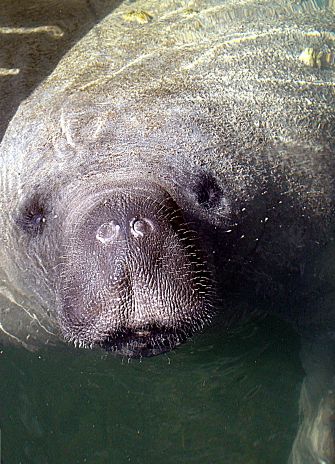 Portrait of a Manatee
Portrait of a Manatee
Undoubtedly the coolest of all manatee facts is that their seemingly hairless bodies are actually covered in thousands of short, whisker-like, "tactile hairs", that can help them "see" what's around them. Manatees and their cousin the dugong, are exceedingly gentle, peaceful beings, often referred to as "sea cows". There are three species of manatees, the West Indian, the West African, and the Amazonian, and one species of dugong, that make op the order "sirenia".
This word is taken from the story of the Sirens, who were mermaid-like creatures for which manatees have been mistaken by early explorers like Christopher Columbus! (more on that later..) Sirenians are all very similar in appearance, with smooth, rounded, massive bodies, flipper-like forelimbs, and a webbed tail. The West Indian Manatee is the largest species, averaging around 10 to 12 feet in total length, and weighing between 800 and 1200 pounds.
The West Indian manatee looks allot like a whale or a walrus, but is actually most closely related to the elephant,. Notice the flat toenails on each flipper, and the flexible, somewhat prehensile upper lip, that are reminiscent of elephant anatomy.
There are two subspecies of West Indian manatee, the Antillean manatee, and the Florida manatee.
Antillean manatees generally range down the coast of Mexico and South America, and can be found near the shorelines of Jamaica, Cuba and Haiti. Antillean manatees are sometimes called Caribbean manatees.
The Florida manatee lives along the South Eastern coast of North America, and has been found as far North as Cape Cod, although Georgia is more typically the peak of their range.
The West African manatee can be found in the coastal areas of West Africa. They look almost identical to the West Indian, but they have been barely studied, and not much is known about them.
Both the West Indian and the West African manatees can live in water with various degrees of salinity, from fresh, to brackish, to ocean.
Amazonian manatees are strictly a freshwater species found throughout the Amazon basin in countries like Brazil, Peru and Columbia. They are the smallest species, most easily recognized by a white or pinkish colored chest patch. They have smoother skin and lack nails on their flippers.
Manatees enjoy the warm, shallow waters of coastal marshes, rivers and estuaries. They are exclusively vegetarian, but may occasionally scarf in shellfish or other wildlife as they cruise for their favorite plants and algae.
The manatee is referred to as the "sea cow", since its life of munching on underwater greens and drifting from one watery pasture to the next, sometimes in large herds, might seem allot like a cow. They are the only marine mammals that live exclusively on vegetation, just like a cow, and this diet produces a great deal of gas, also like a cow.
Manatees are very flatulent, and the gasses that haven't escaped yet are held within their body cavity creating a great deal of buoyancy. To counteract this, the manatee has an incredibly dense skeleton, with marrow-less bones that allow it to sink to the bottom despite being a bit of a hot-air balloon.
They can remain submerged for a casual 5 or 6 minutes at a time, while using their flippers to walk along the bottom, or grazing mid-depth flora, using. When sleeping, the manatee can stay under for 20 minute stretches, bobbing just below the surface, or sinking deeper to rest on a sandy bed, and drifting up dreamily 3 or 4 times an hour to take a breath.
Manatee Lifestyle
Florida manatees are nomadic and non-territorial. They may come together in large herds in prime locations, or travel in pairs or groups to different feeding grounds or warmer waters, but they don't form close bonds, and they come and go as they please.
Although they look a little chunky, manatees don't have the layer of blubber that whales and seals utilize for warmth. They also have a slow metabolism, and very slow movements, so they don't warm up on their own. Warmth is important for survival, and they migrate to warmer waters seasonally, seeking minimum water temperatures of 70 degrees to protect them from disease. In fact, consistent temperatures below 68 degrees can be fatal to a manatee.
Their love for warm water which means manatees end up in allot of the places that people do. They may cruise various northern waterways from April to October, sometimes wandering as far as North Carolina or Maryland, but in the winter months, they migrate south to Florida's freshwater springs, where the water temperature is ideal at 72 degrees year-round.
They can also be observed in great numbers at sites like the Big Bend power plant, where discharge water creates a warm environment. The power company built an entire viewing center with observation stations to accommodate manatee lovers, and educate folks about these awesome creatures.
Manatees are quite friendly and curious about people too, and in Crystal River in Citrus County, Florida, tours are organized for people to swim and interact with them. This is the only place in Florida where people can legally swim with manatees, who are otherwise protected by both State and Federal law, and special areas are roped off so the manatees that want a little privacy can graze undisturbed.
Although many manatees appear to enjoy the interaction, and will actually gaze right in peoples eyes, there are fines handed out for anyone who actually touches one, and some concerns that the activity is impacting the animals well-being.
Manatees eat a wide variety of aquatic vegetation like shoal grass, water Hyacinth, mangrove leaves and a long, slender type of plant that's actually called manatee grass. They use their flippers to move sea grasses to their mouth, and their top lip, which is split into two prehensile halves, pulls the food in.
Generally, hair provides warmth and protection, but tactile hairs, known as vibrissae, have a completely different set of functions. The manatee has about 2,000 vibrissae on the face, and another 3,300 or so distributed sparsely over the body. Most other mammals have vibrissae only on the face, like the whiskers of dogs and cats. Some animals like raccoons have vibrissae on their paws and legs.
But the manatee is the only animal that has only vibrissae, and no other type of hair, not even eyelashes.
The tactile hairs on the face of the manatee, located in a circular region surrounding the mouth known as the oral disk, are said to be as sensitive as fingertips. They are used as we use our hands, to explore the environment and gather information on food, objects and other manatees.
The tactile hairs covering the body are believed to help manatees monitor changes in water currents, and may detect energy reflected off objects as the manatee navigates through murky water, allowing them to understand the size and location of things in the environment, somewhat like echolocation.
Manatees communicate with eachother through squeaks and squeals, and there is lots of chatter between mother and calf.
The manatee has a very small brain for its body size, and the brain is unusually smooth, without all the ridges seen in most mammals brain surfaces, but recent studies suggest they are rather intelligent and can perform some discrimination tasks with the same aptitude as seals and dolphins. Based on these findings, it has been suggested that maybe a manatee has a very big body, as opposed to a very small brain.
Manatee Facts On Reproduction
Manatees don't have a set breeding season, and females may come into estrous at any time of year. When they do, they attract numerous males - sometimes as many as twenty - and create what is known as a manatee mating herd.
This excited group may stay with the female for the length of her estrous, which may be up to 3 weeks. She will mate with numerous males at this time. Dugongs differ from manatees in that they form a pair, and are monogamous.
The female is pregnant for 12 to 13 months and gives birth to a calf that is about 4 feet long, and 55 to 70 pounds. The baby may be born either head or tail first, and the mother guides the newborn to the surface to take its first breath. The baby can swim immediately, and begins to vocalize within a few minutes.
Baby and mother manatees communicate continually with squeaks, clicks, moans and whistles. Babies have been seen on their mothers backs, but they usually travel next to her, and directly behind the flipper, which may allow them to "draft" in her current.
The baby manatee nurses from two nipples located behind each flipper, and usually continues to nurse for about a year. The baby is born with all its teeth, and begins to sample plants at about one week old.
Adult manatees are not usually threatened by predators, but babies can fall victim to alligators and sharks, and the Amazonian manatee has been known to be the prey of jaguars. Mothers may try to intervene, but they are slow and have little offense.
Youngsters stay with their mothers for about 2 years, learning migration paths, best feeding spots and the ins and outs of waterways. Since the manatees tend to be nomadic, with no actual territory, there is allot to be taught.
The reproduction rate of manatees is very slow. They are not mature enough to mate for several years, they give birth to one offspring at a time, and they spend 2 years raising the calf. This makes their status as a vulnerable or endangered species even more perilous.
Are Manatees Mermaids?
One of the more confusing manatee facts, is that they appear in the journals of some very famous people, who describe them as mermaids.
Captain John Smith mentions them, and Henry Hudson too. And none other than Christopher Columbus, who is referenced by a shipmate -
"On the previous day, when the Admiral went to the Rio del Oro [Haiti], he said he quite distinctly saw three mermaids, which rose well out of the sea; but they are not so beautiful as they are said to be, for their faces had some masculine traits." (Voyages of Columbus 218)."
This is considered to be the first written record of the manatee in North America.
There is no doubt that if they come up out of the water and the light is just so, it could definitely look like the head of a person, and it is also possible that the location of the nipples, on the chest like human beings, added to the presumption.
Skeletal remains of manatees might look somewhat human as well, with the forelimbs revealing five distinct fingers once the flipper webbing is gone.
And don't forget, dugong loosely translated means "lady of the sea" in the Malaysian language.
The fact that the manatees scientific name - sirenia - comes directly from the Sirens of Greek mythology, who lured sailors with their beautiful songs, implies that more than one sea-going fella saw them in this light...just the right light.
What's The Difference Between Dugongs And Manatees?
The dugong and the manatees exist together in their own taxonomic order known as the Sirenians, but they are split into two different families. There are numerous differences both physically and behaviorally.
The dugong is found in the Pacific Ocean along the coasts of East Africa, South Asia and Australia. They live exclusively in saltwater, and are the only living species in the family dugongidae. Its close relative, the now extinct Stellars sea cow, was discovered by German explorer and naturalist Georg Wilhelm Steller in 1741.
These amazing animals had tiny heads and enormous 30 foot long bodies. They were probably responsible for some of the mermaid stories, because they were said to bask partially on shore. Less than 30 years after Stellar discovered the fantastic sea cow, it was hunted out of existence.
Dugongs only grow to about 8 feet long, weighing about 650 pounds. They have a crescent shape tail, like a whale, and the upper lip is not divided as it is in the manatee.
The muzzle of the dugong has a steeper angle, and the eyes are higher up on the head.
Dugongs are more solitary, living alone or in pairs. It is thought that they might mate for life.
A major difference that puts dugongs at greater risk than manatees is that dugongs do not reach sexual maturity until they are about 10 years old, making their reproductive rate even slower the manatee.
A Few More Manatee Facts
- Christopher Columbus mistook a manatee for a mermaid
- Manatees may have the smallest brain-to-body ratio of any mammal
- When sleeping, manatees only need to take 3 breaths an hour
- Algae often grows on the backs of manatees - and acts as a sunscreen
- Manatees have thousands of whisker-like hairs all over their bodies
- The elephant is the closest relative of the manatee
- Manatees use their flippers to walk along the river bottom
- Manatees replace their molars as they where down
- Despite how it may appear, the manatee does not have a layer of blubber and can't stand the cold
African Lion Facts
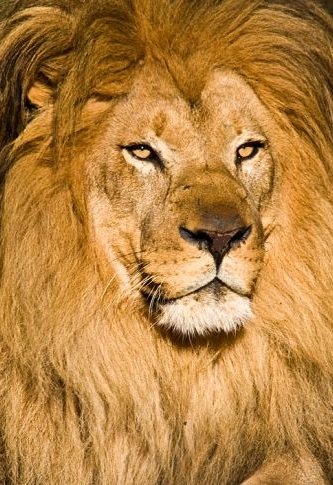 Portrait of an African Lion
Portrait of an African Lion
The African lion is a massive, tawny colored predator of the cat family. On average, the lion is the tallest of the big cats, but the Siberian tiger tends to be considerably longer and heavier.
The ultimate apex predator and an awesomely beautiful creature, the adult male lion has a flamboyant ruff of remarkably long hair around the head and neck known as a mane, which begins to develop when he is about 10 months old.
Although it has been speculated that the purpose of the mane is to provide protection in fights with other males, it is more likely an indication of fitness, condition and virility and it's color has been found to be linked to testosterone levels.
Lions with darker manes had more testosterone, and were found to be more appealing to female lions, and more intimidating to male opponents.
An adult male African lion is over 400 pounds and 4 feet tall at the shoulder. They are equipped with enormous fangs and incredibly powerful necks, forelimbs and claws that allow them to hunt, on average, the largest prey of any land animal.
Regularly taking down 600 pound plains zebras and 1,300 pound cape buffalo, African lions will also take on giraffes and even elephants in the right situation.
Compared to other cats, lions are very social animals and live in groups of 5 to 25 individuals called prides. The pride is made up of several related adult females, their cubs, and some adult males.
These pride males, often brothers, may come and go, and even be members of more than one pride at a time. They must continually prove themselves as established pride leaders, fending off all other males in serious, sometimes fatal fights.
The females hunt together, only occasionally being helped by the male members, but when the hunt is over, the adult males, generally 30 to 40 percent larger, eat first.
Many adult male lions, however, live alone or in small "bachelor" groups, not bold enough or strong enough to take on established males. And pride leaders themselves, worn down from constant battles, will eventually succumb to a stronger rivals and retreat back to a solitary lifestyle.
African lions roam the grasslands and vast savannas of central and south Africa, The smaller, lighter colored Asiatic lion lives in the jungles of south Asia in very small numbers. - African Lion Facts
King Of The Jungle?
King of the Jungle? Of the 20,000 lions in the wild, only 500 - 525 highly endangered Asiatic lions live in the Gir jungle of India.
The familiar African lion lives on the savanna grasslands of central and southern Africa.
Asiatic lions are also called Persian lions or Indian lions. They are a bit smaller than African lions, have distinctive skin folds that can be seen running along the sides of the torso, and a much sparser mane.
They have been actively protected by the Indian government for the last 30 years, and their small jungle territory was declared a national park where human activity is prohibited.
Thanks to this concerted effort the number of Asiatic lions in the wild has increased from a low of about 250 individuals to over 500 in a fairly short period.
African Lion Reproduction
The female lion is poly-estrus, which means she may ovulate up to 4 times a year until she is impregnated. When in estrus or "heat", she will pair up with a male of the pride for a few days during which time they will mate repeatedly.
Her pregnancy takes 3 1/2 to 4 months and when ready to deliver she will leave the pride to find a good nesting spot. She delivers 2 to 4 cubs and remains secluded with them for several weeks before returning to the pride and introducing the new members.
This is a dangerous time for mother and cubs, and she will usually fast for days while tending to her young. When she returns to the pride with the new cubs she is greeted with much nuzzling, inspecting and celebrating.
The cubs will be nurtured by the whole pride at this point, and if cubs are orphaned, another lioness will usually adopt them and even nurse them.
Female cubs will live with the pride their entire lives and never leave. Male cubs will leave the pride, usually driven off by the adult males, when they are about two years old. They will live alone, or band together in small groups of "bachelor" males called "coalitions" Many male lions will never return to a pride, and will never mate.
Only the strongest and boldest will attempt to takeover a pride by driving the established males out. Once a new male or new group of males take over, they will often - but not always- kill the youngest cubs in order to begin their own families.
The mothers are helpless against this, but in the life of a lioness this doesn't happen often. New males may come in every two years or so, and if the timing is right, the cubs may be old enough not to be harmed.
The main catalyst for the killing of the cubs appears to be an attempt to free up those mother lions to mate again, and, in fact, lionesses who lose their cubs for almost any reason will come back into heat very quickly. - African Lion Facts
A Dogs Life
Far more canine than feline in behavior, the lion pride is a close-knit, social group where individuals maintain long term, often life-long relationships, cooperate in the raising of the young, and hunt down dinner as a unit.
Unlike any other cat species, members of the lion pride will participate in the raising of cubs, lionesses have been known to nurse orphan cubs and raise them as their own, and even males have been observed protecting, correcting, and babysitting.
A Thorny Crown For The King Of Beasts
While it's often said the lioness does "all the work", the truth is that the life of a male lion can be much tougher.
As young adults, males are pushed out of the pride by the dominant males of the moment. They may spend years alone or in small bachelor groups of other males called rouges, often made up of brothers.
As they mature and grow, they prepare to return to the pride or neighboring prides and unseat the dominant males, in fierce, sometimes fatal battles. If they succeed they will often kill any cubs from the former king.
Now, as the dominant males, they will mate with the females in the pride as they come into season, and otherwise doze in the sun or sleep in the shade up to 20 hours a day, waiting for the females to catch dinner.
They will battle any males who try to overthrow them, and eventually they will loose the fight, after only a few months or short years of glory, and sometimes to one or more of their own sons.
Banished again from the pride, older and war-weary, they most likely spend the rest of their years on the outside of the pride looking in.
Kind of a thorny crown, don't you think? - African Lion Facts
Good Hair Goes A Long Way
Rivaled only by the horse, the male African lion in full mane is a true icon of the animal kingdom. His unmistakable image has graced some of the oldest coins, works of art, and jewelry in history. We humans have found ourselves awestruck for many thousands of years and for fine reason.
A Few More African Lion Facts
- Lions can consume up to 40 pounds of meat in a single meal.
- African lions sleep - or doze, rather- about 20 hours a day
- The "big cats" are the tiger, lion, leopard and jaguar - the only 4 members of the genus Panthera.
- The "big cats" are the only cats who can truly roar.
- Big cats roar thanks to a specially designed larynx (a part of the throat).
- The African lion has the longest larynx - and the loudest roar.
Leopard Facts
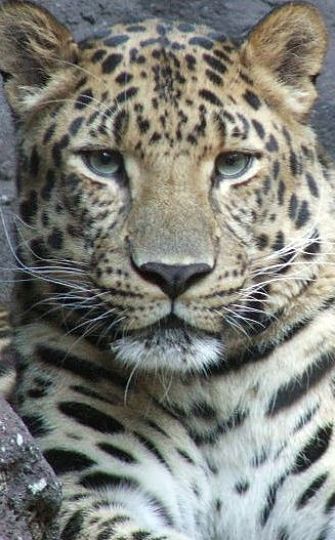 Portrait of a Leopard
Portrait of a Leopard
The leopard is the smallest of the four Big Cats, but is probably the most powerful pound-for-pound. They have amazingly strong necks and shoulders, and are able to carry prey often heavier than themselves, high up into the branches of trees where other predators can't reach.
The leopard's climbing ability sets it apart from the other big cats and has made it the most successful of the group as far as its numbers in the wild.
Although leopards in Asia are critically endangered, the African leopard is quite numerous and estimates are that there are close to 500,000 wild leopards in existence.
That number is nearly ten times the number of all wild lions, tigers and cheetahs combined.
Their tree climbing prowess doesn't just give them the means to keep their kills safe, it also provides them a quick escape from the many animals on the African plains that can make life tough.
The leopard is a gifted, swift and effective hunter, but it is less than half the size of a mature lioness, has nowhere near the pugnacious tendencies of a hyena, and wouldn't stand a chance against a pack of African wild dogs.
While the cheetah hunts in daylight in plain sight of any other predators that might want to steal it's prey, the leopard hunts almost exclusively by night, and it is a notoriously silent killer. One of the things that makes the rare man-eating leopard so incredibly lethal.
An older or injured leopard that can no longer take wild game, may find an easier mark in a nearby African village.
While the man-eating tiger will kill humans mostly out in its own territory, leopards who resort to preying on humans are so swiftly deadly that they have been known to take people from their beds without other house mates hearing. - Leopard Facts
Cool Leopard Facts
The leopard is a stunningly beautiful animal with a coat of buff to bright orange strewn with circles of spots called "rosettes". Sometimes their spots are actually square in shape.
There is also a type of coloration known as melanism which is an increase in dark pigment of the skin and fur which occurs in about 6% of all leopards and results in what is known as a "black panther".
From a distance, Black panthers appear to be solid black in color, but close up you can actually see black spots on the coat.
The other spotted big cat, the jaguar, is very similar in appearance to the leopard and easily mistaken for one. Jaguars are generally much larger and more bulky than leopards and have much broader, rounder heads with smaller ears and eyes.
Because of their bulk, they do not share the leopards excellent climbing abilities, and so their lifestyle is more like that of a tiger than a leopard.
Melanism occurs in jaguars as well, at approximately the same rate as in leopards, and the term "black panther" applies to melanistic individuals of both species.
Leopard Reproduction
Leopards are loners and live the most solitary lives of all the big cats.
In fact, unless they are paired up during a few short days of mating, adult leopards are almost never seen together.
The only time leopards spend in close company is the first 1 1/2 to 2 years of life spent with mom. After that, and once the youngster leaves, they have no further contact with their mother, and no contact at all with their father who never hangs around after mating is over.
Leopards mark their territories in the same way as many cats do, with scent marking using urine sprays and sight markings leaving deep claw marks in selected tree trunks.
A male leopards territory is thought to be three times as big as the females, and will overlap or completely encompass one or more females home ranges. Even so, they will avoid each other, making husky coughing type sounds as they patrol to let others know its time to clear out.
Confrontations are rare because great effort seems to be taken to have no close contact, but they will keep tabs on each other by visiting the sites that their neighbors regularly mark and scent.
Females come into season several times a year until impregnated. When looking for a mate she makes a rowling sound similar to a house cat in heat.
A male and female will pair up for 4 or 5 days, after which the male leaves for good.
The pregnant female will find a safe den and have a small litter of 1 to 3 cubs on average. More than 3 is possible, but rare. Newborn leopard cubs are a dark grey in color, an abundance of fuzzy fur, and very faint - if any- spots.
Leopards, particularly in Asia, regularly give birth to just one cub. Because of this, and because of the leopards naturally seclusive lifestyle, survival rate is actually very good for young leopards compared to some other cats.
One of their most common enemies are snakes who may find little cubs alone, waiting for their mother to return from a hunt. Lions are a threat as well, and lions will kill young leopards if given a chance.
Lions have also been known to actively pursue and kill adult leopards without any interest in eating them. Solitary male lions in particular seem to make almost a sport out of trying to catch both leopards and, even more often, cheetahs.
The leopards greatest defense and greatest asset is how it lives its life, quietly and with unparalleled stealth. - Leopard Facts
The Leopard Slipping Away
There are currently 9 known subspecies of leopard in the world.
By far the most common is the African leopard which is not presently endangered. The other subspecies, spread through little pockets along Southern Asia, India, and up through the Russian far east.
At the highest Northern altitudes, leopards can be found living in mountain regions where the temperatures regularly dip below freezing. In some areas they live alongside Siberian tigers, but tend to exist along the snow line and avoid areas that get any real snow accumulations.
All of the Asian subspecies are endangered, and some may even be extinct to date.
The exceedingly rare Amur leopard of Korea, China and East Russia is on the crest of extinction with numbers of less than 30 in the wild.
The leopards notorious stealth, however, makes it hard to determine true numbers, and the leopard, no matter where its home range may be, remains by far the most difficult big cat to record and photograph.
The Balancing Act
The leopard is a very large carnivore with exceptional hardware that would give it the edge in allot of tough neighborhoods.
In areas of Asia where tigers are not in their range they are king of the jungle. But out on the African plains, the leopard is definitely not the apex predator. Surrounded by lions, hyenas and African wild dogs, harassed by vultures, jackals and even baboons, a hungry leopard must not only kill quickly and quietly, but also take its bounty to the trees in a hurry.
Leopards stash large kills in the crooks of branches where they can eat in peace and even leave the carcass for a few days with some confidence that heavy lions and non-climbing pests just can't reach the cache.
Having the power to take down and maneuver very large prey, coupled with the agility to climb higher than the competition, works hand in hand, as a large kill does not go to waste on the floor of the savanna..
With a large kill the leopard will climb to a safe height, eat its fill, and then return for a number of days to feast on the carcass, occasionally having to fetch body parts from the ground if they become detached while it feeds.
A somewhat surreal and gruesome sight to see, a leopard may have a favorite tree with particularly handy niches for hanging corpses, and in Central Africa it is not unheard of to see whole antelope, gazelle, even immature giraffe carcasses hanging from a tree thirty feet off the ground. - Leopard Facts
And The Leopards Far Removed
There are two cat species regularly referred to as leopards that are not closely related to the true leopard. Both the snow leopard and the clouded leopard are in the subfamily pantherinae and are not big cats.
There are attempts to classify the snow leopard as a member of panthera, with the belief that it is actually related to the Siberian tiger, but the snow leopard lacks the ability to roar, which has separated that genus for decades.
Both the snow leopard and the smaller clouded leopard live in mountainous areas of Asia including the Himalayas.
The snow leopard exists in higher altitude and is specially equipped for freezing temperatures with exceptionally thick fur and a very stocky build.
The clouded leopard lives in dense forest and is rarely seen. It has massive fangs and claws for its size, and a beautifully marbled coat.
Both of these cats are considered an evolutionary stepping stone from smaller cats like the ocelot, to the true big cats.
A Few More Leopard Facts
- The leopard is the best climber of the big cats..
- Leopards can drag prey twice their size high up into trees to keep them from scavengers
- There are more leopards in the wild than lions, tigers and cheetahs combined.
- A leopards spots are really circles of spots called "rosettes" that may be round or square in shape depending on the region.
- Leopards hang their kill in trees.
- Although they are rarely in groups, a group of leopards is called a "leap" or a "prowl"
- Leopards can be found both in rainforests and in the snow covered wilderness of Siberia
- Leopards are also known as panthers.
- A black panther is a leopard with melanistic coat coloration.
- Black panthers have faintly visible spots..
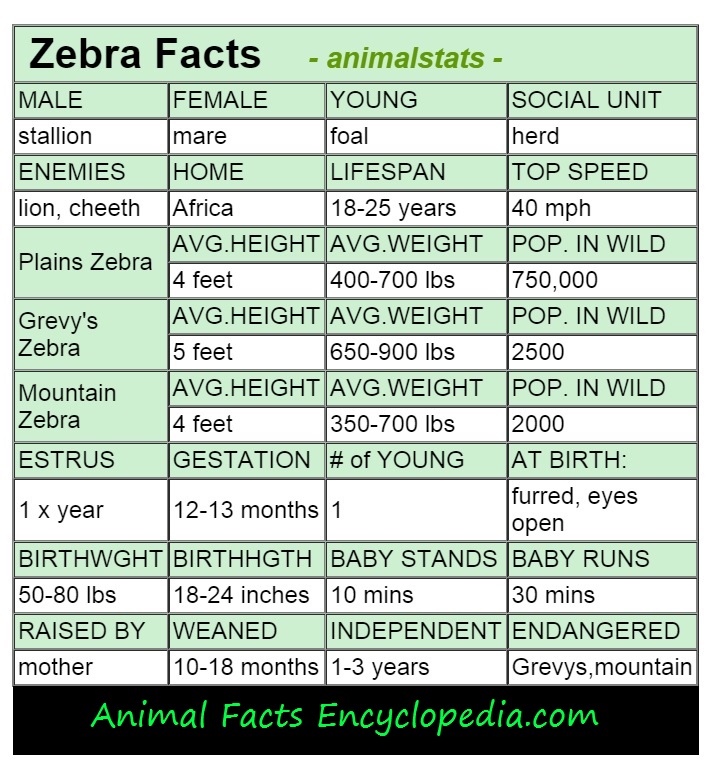
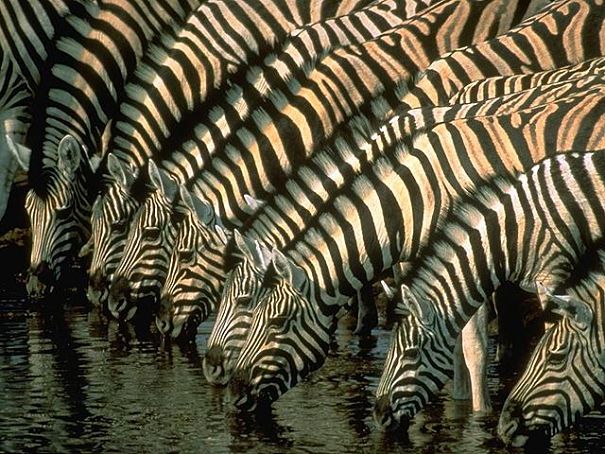
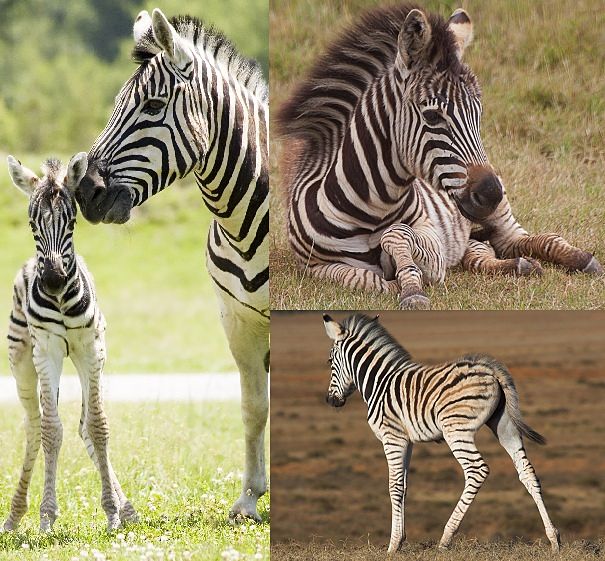
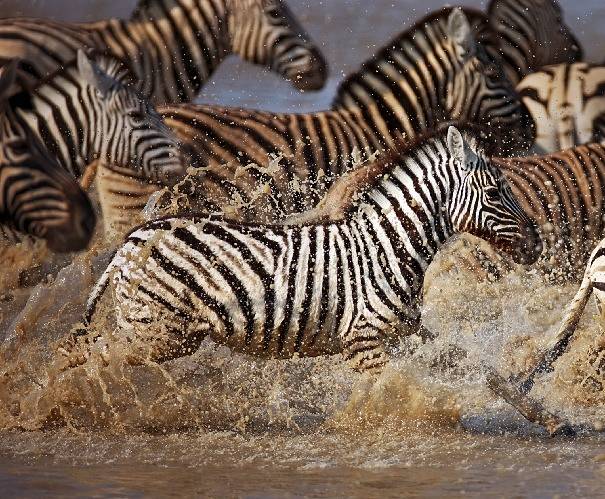
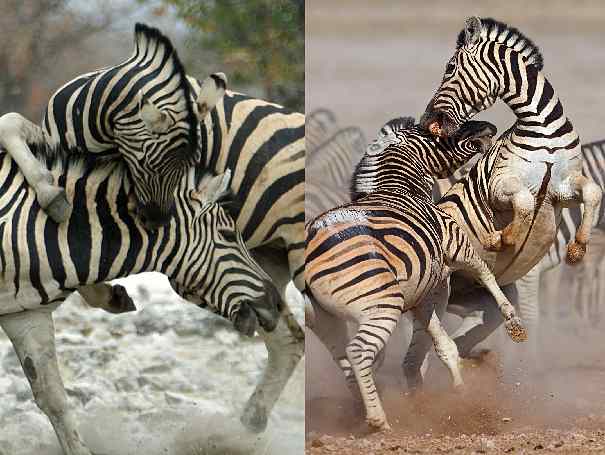
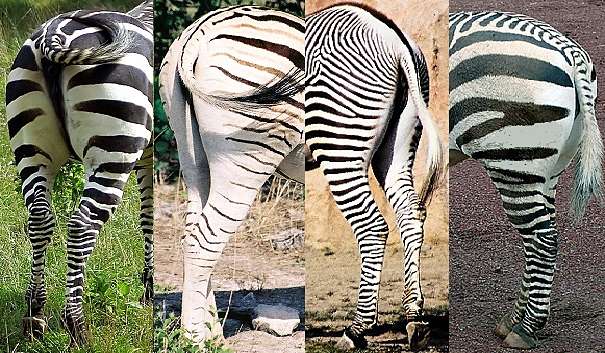

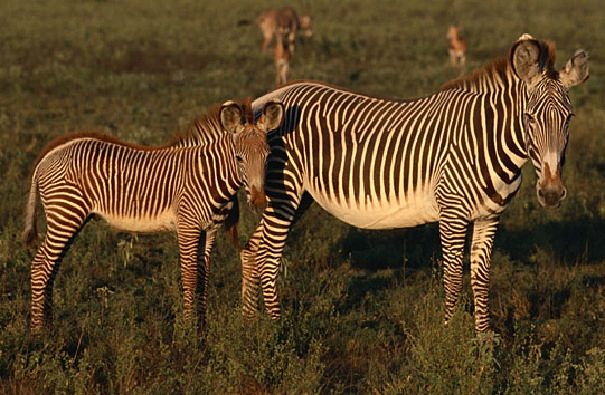
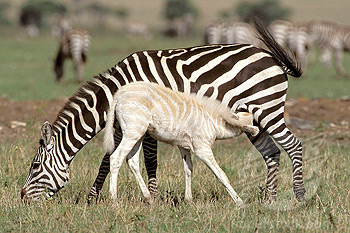
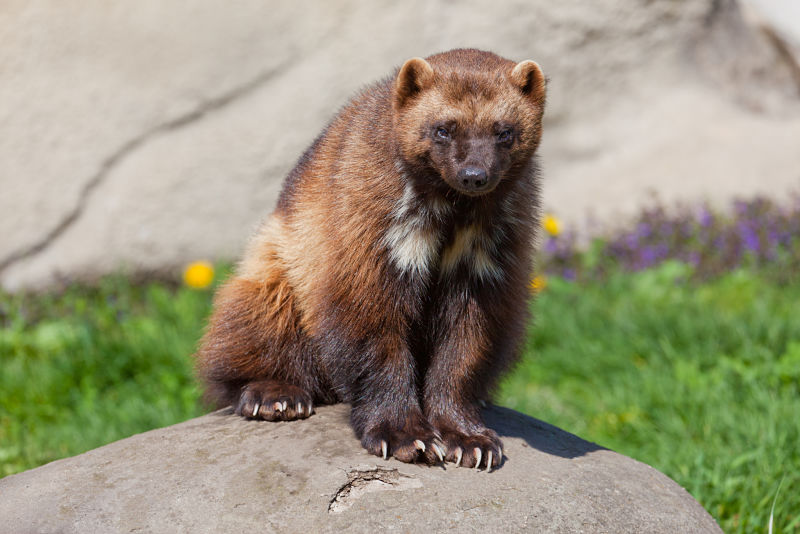

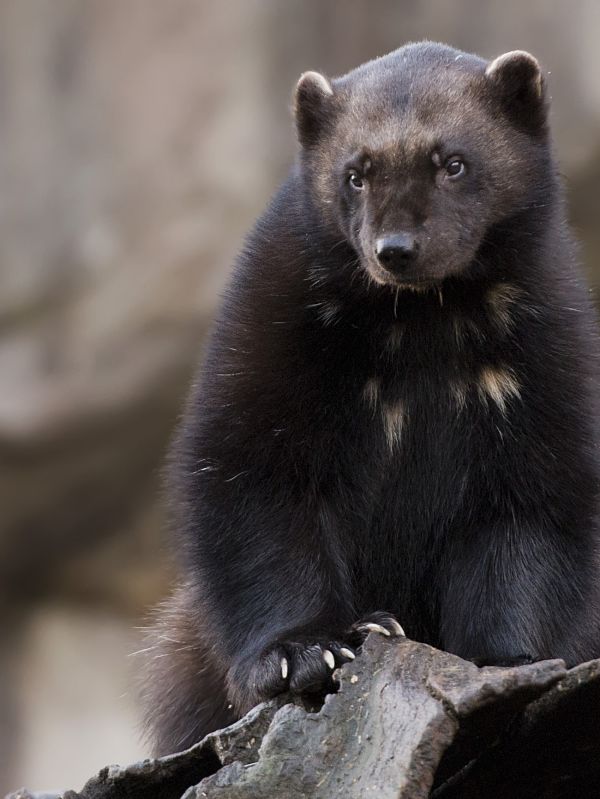
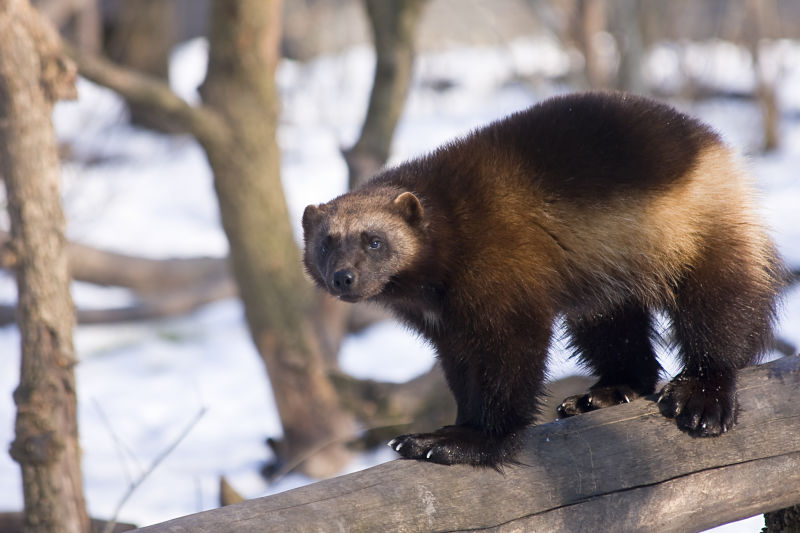
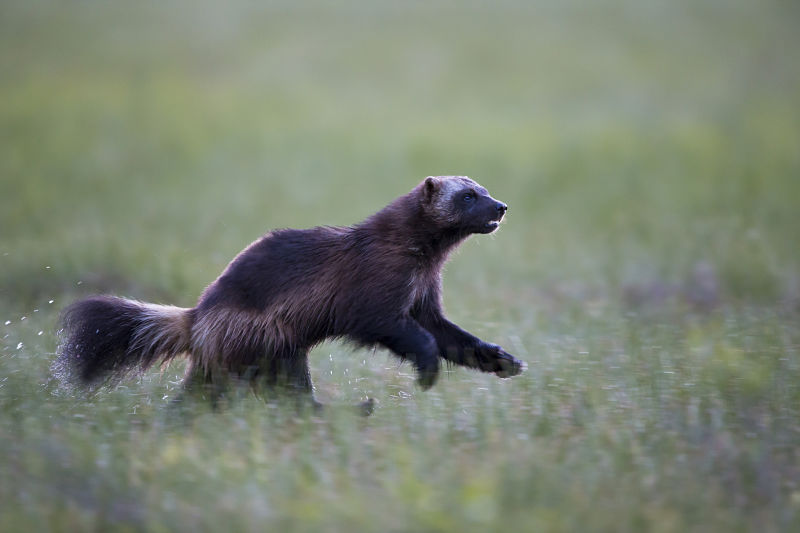
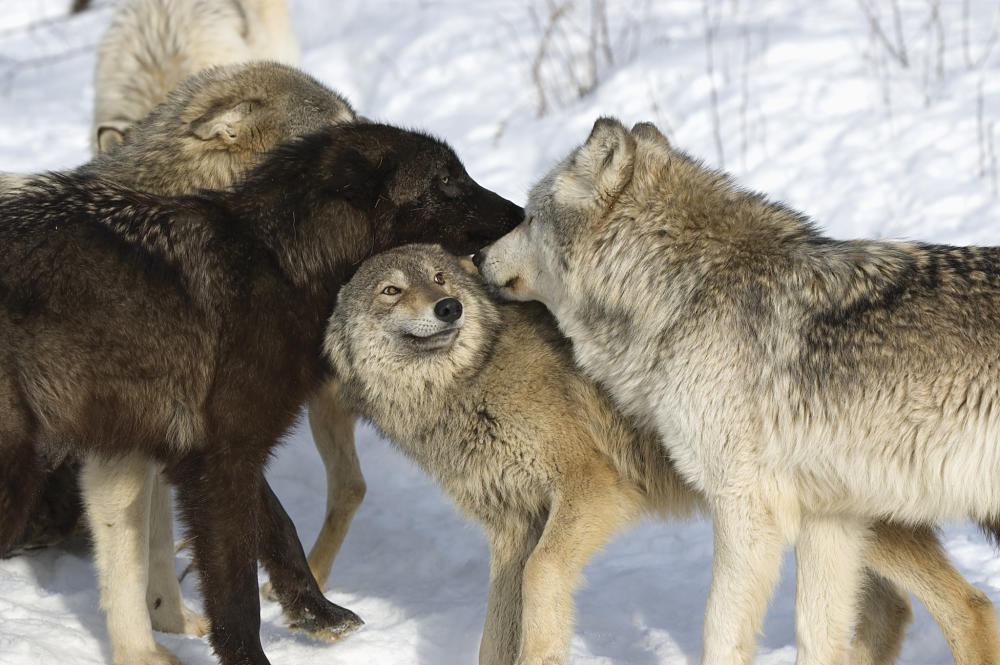
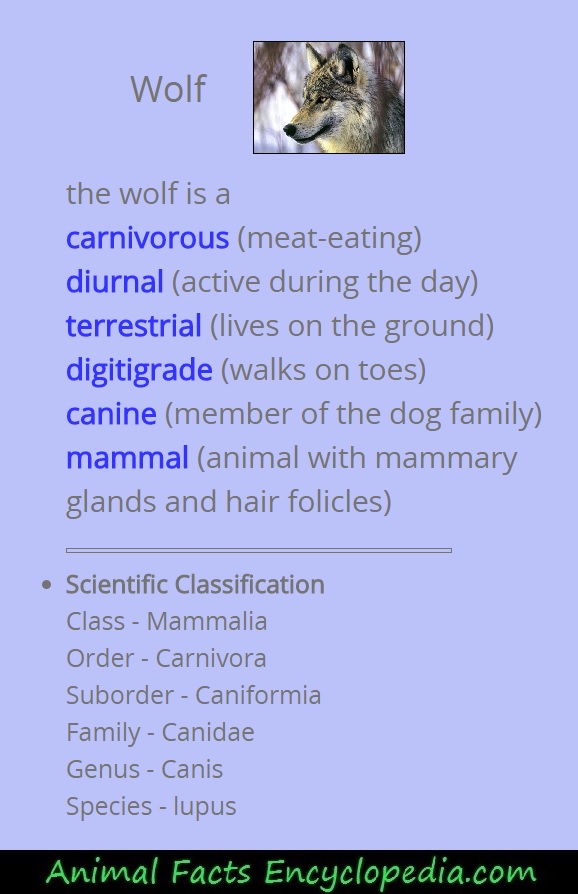
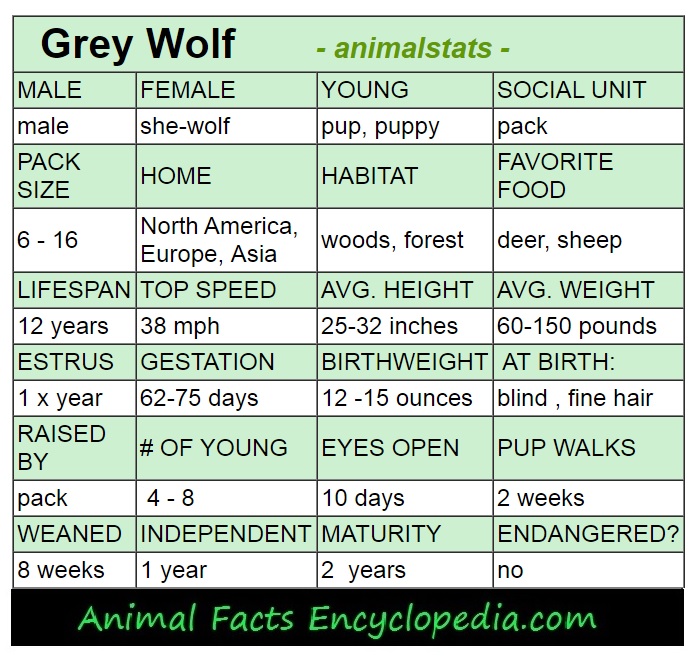
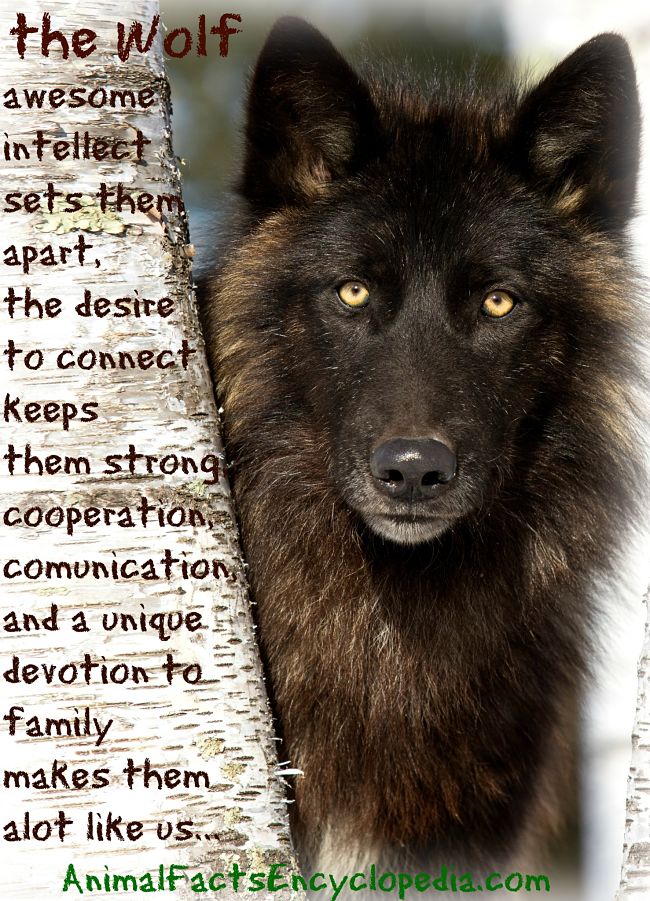
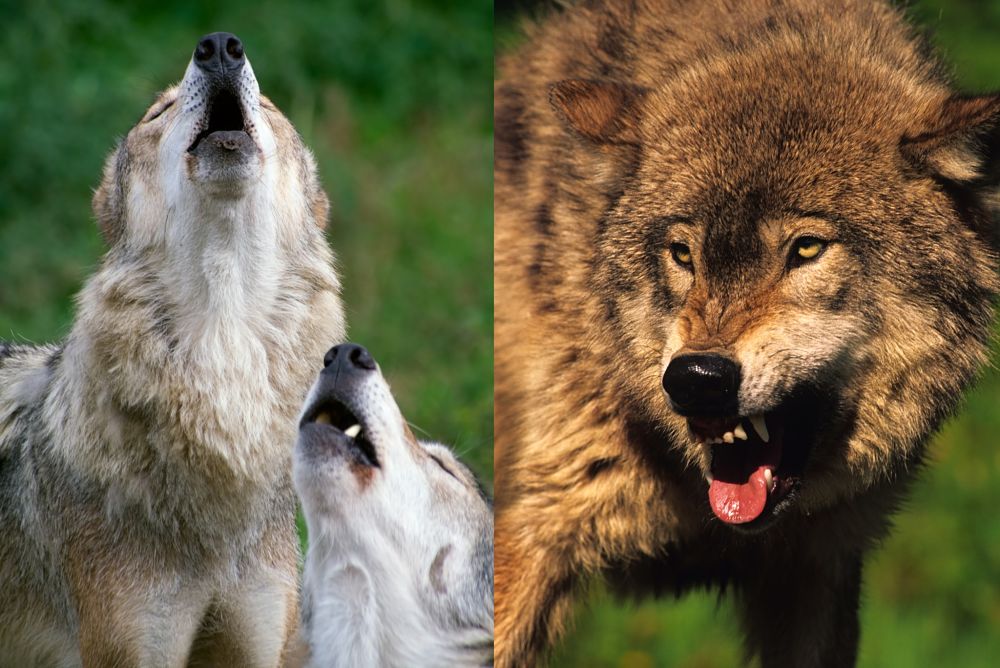
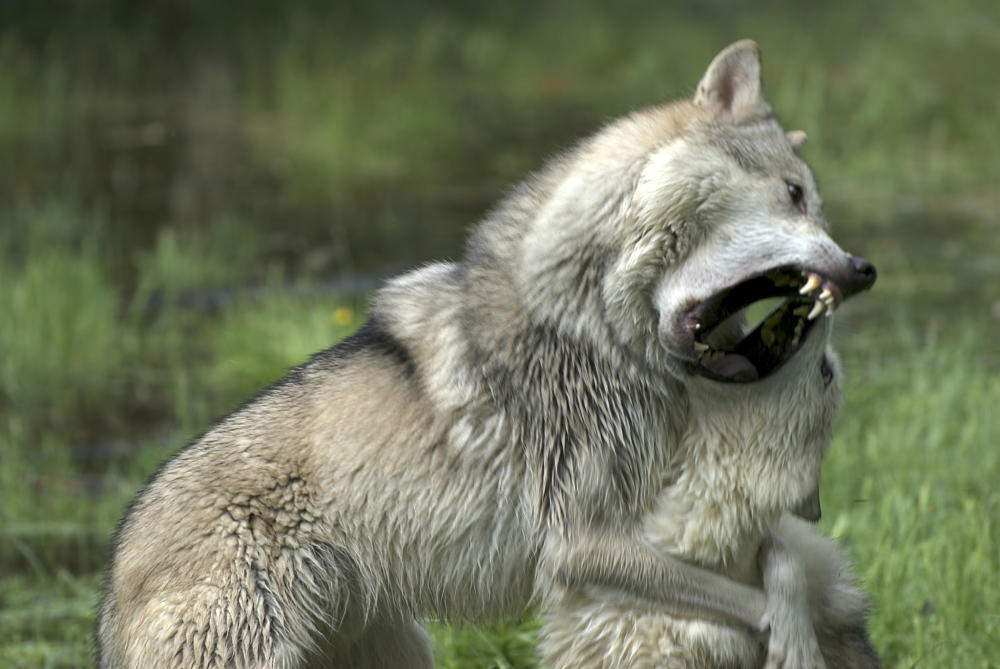
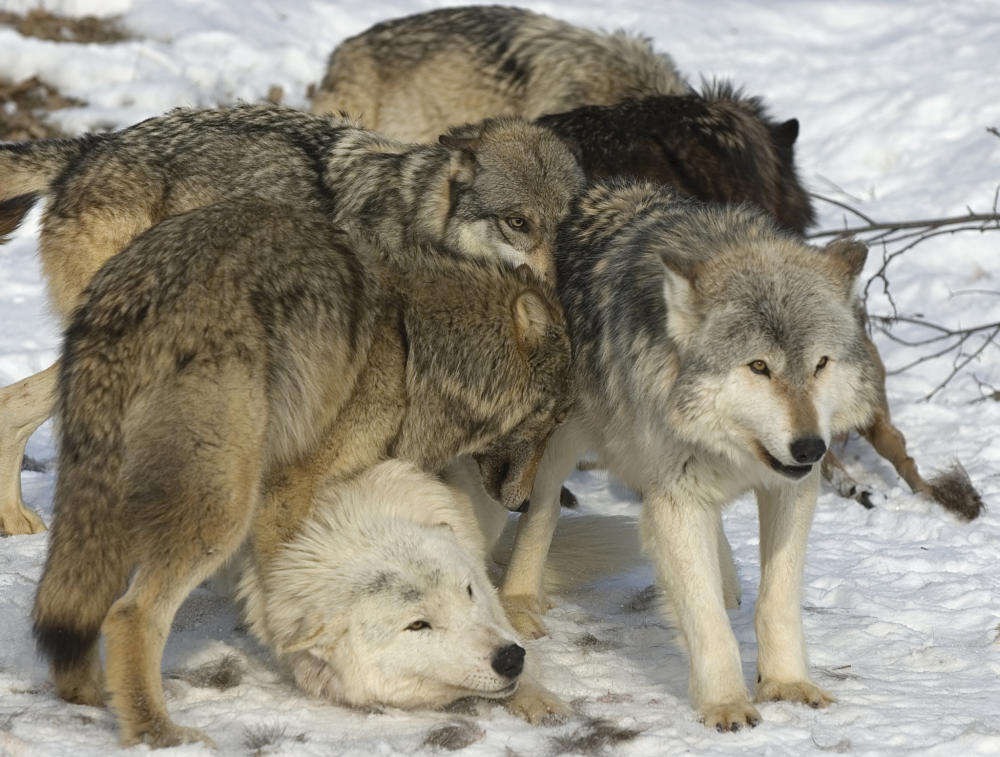
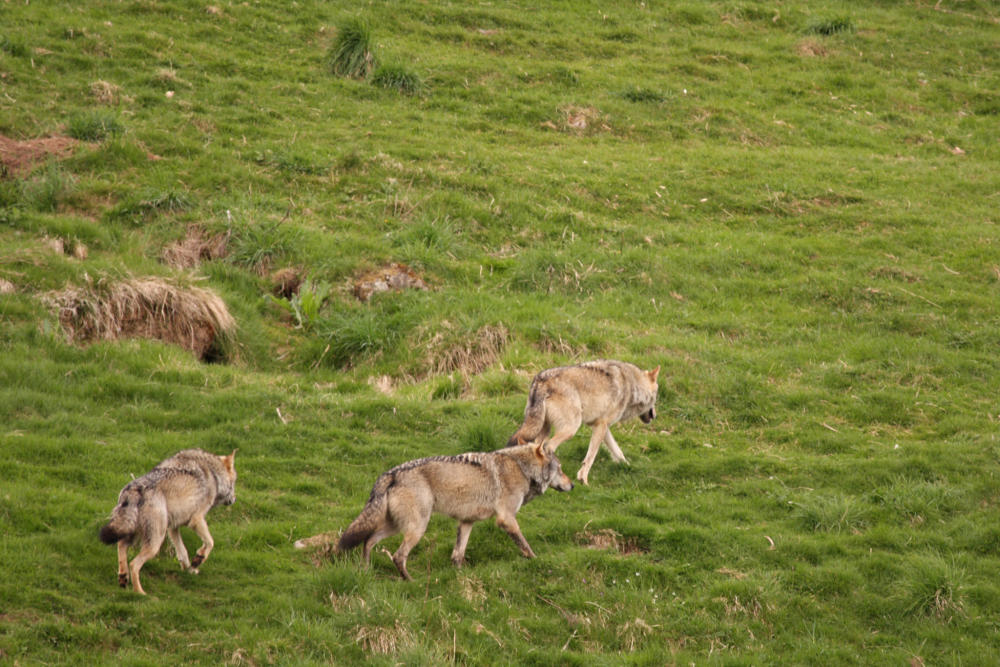
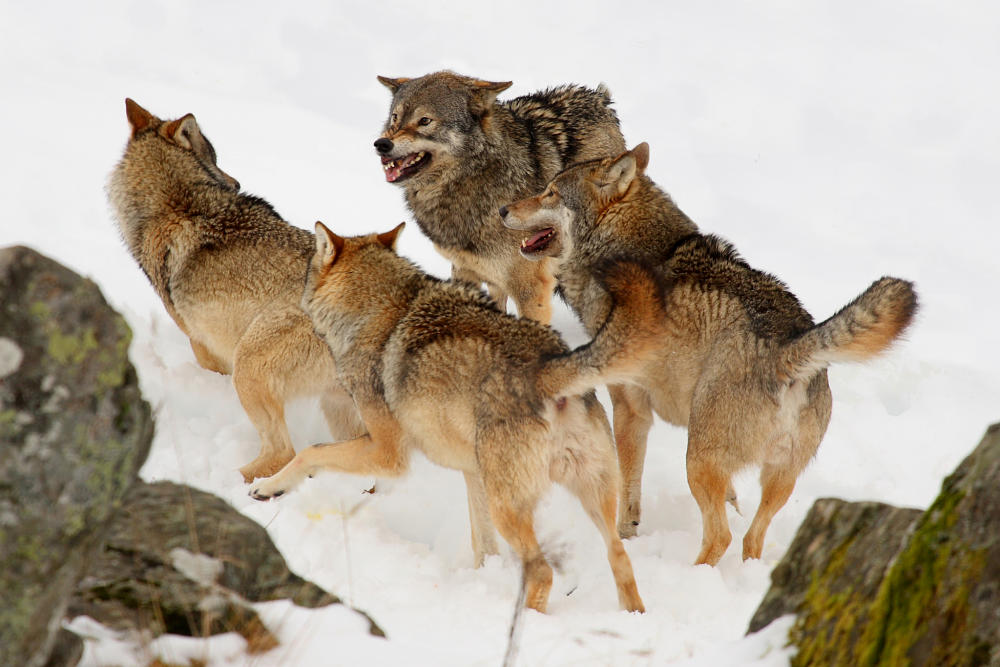
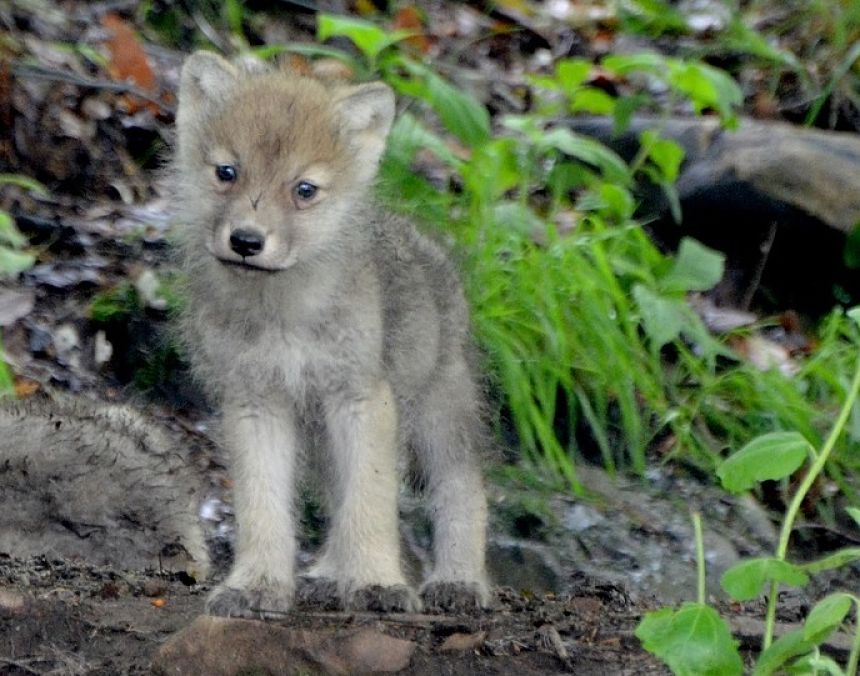
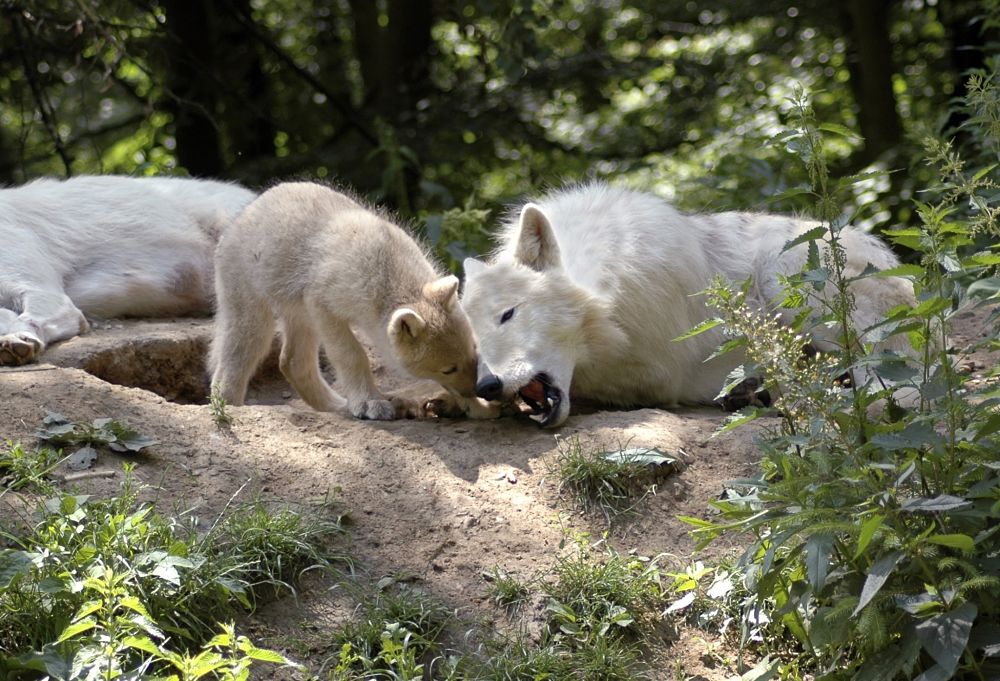
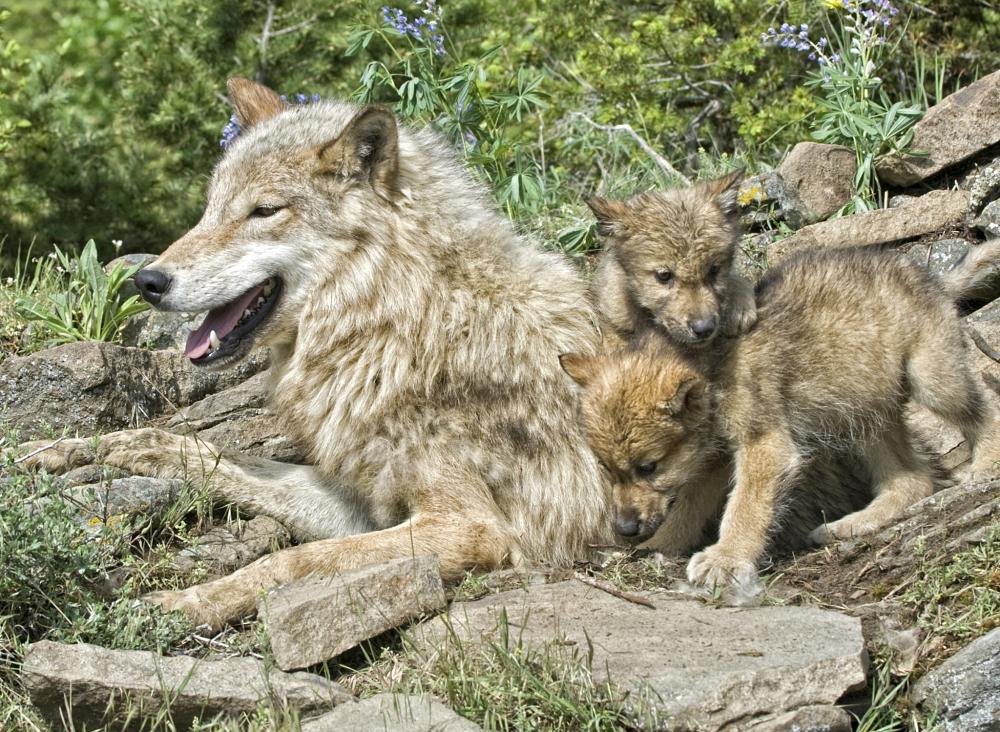
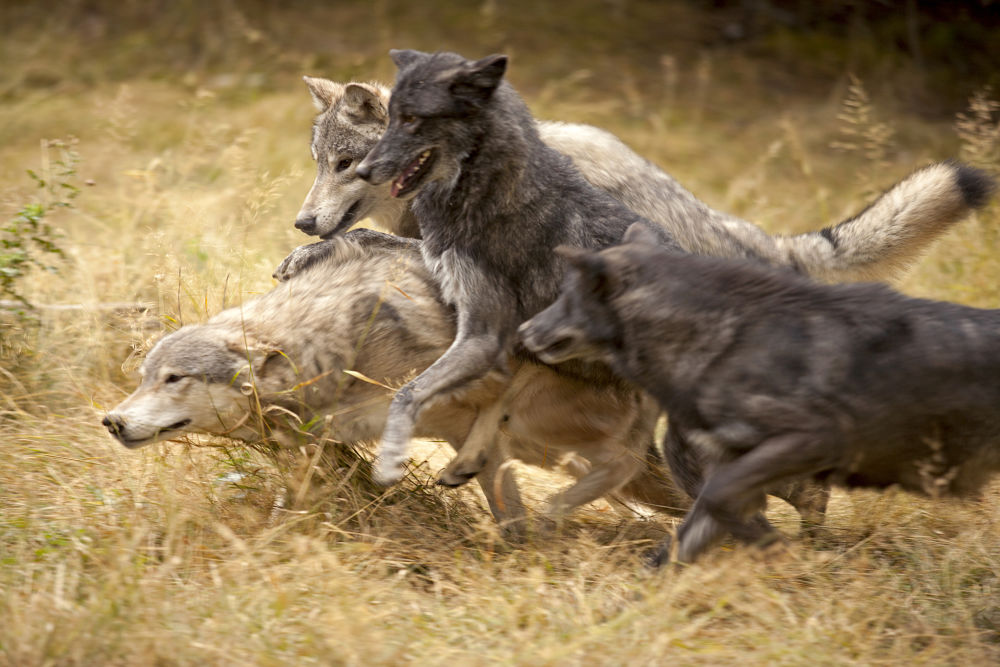
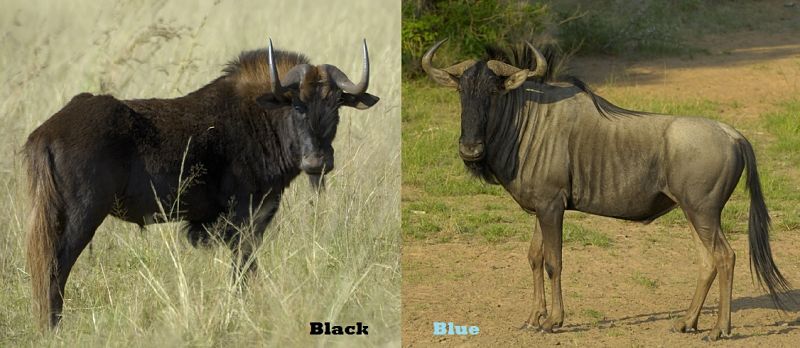
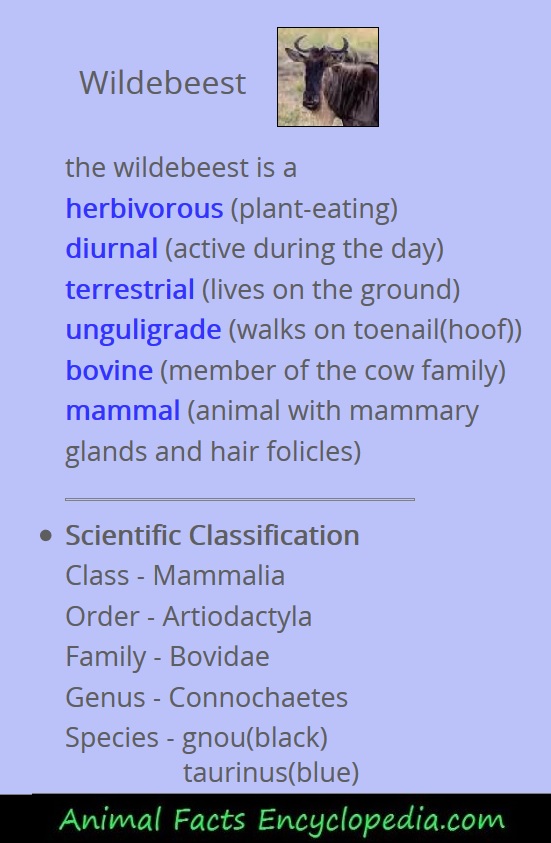
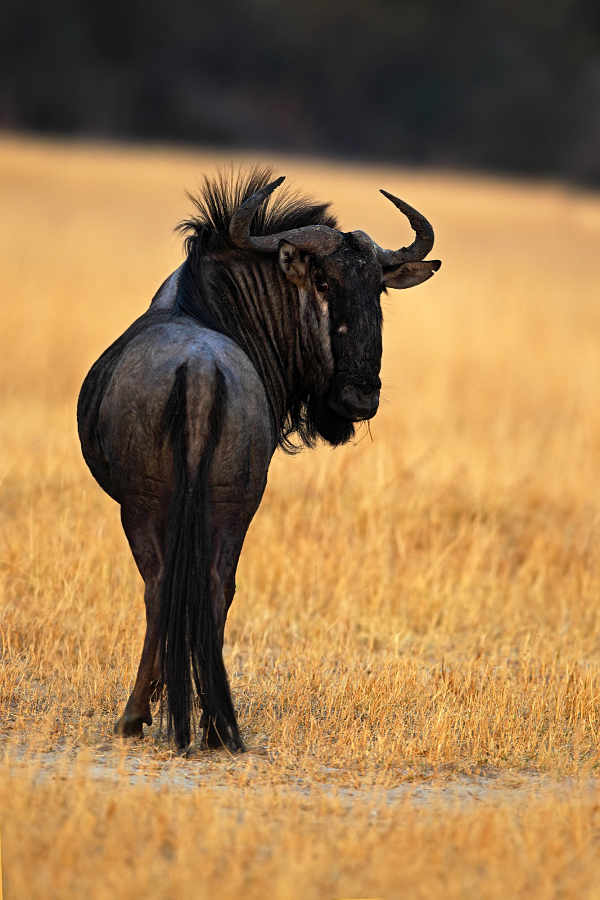
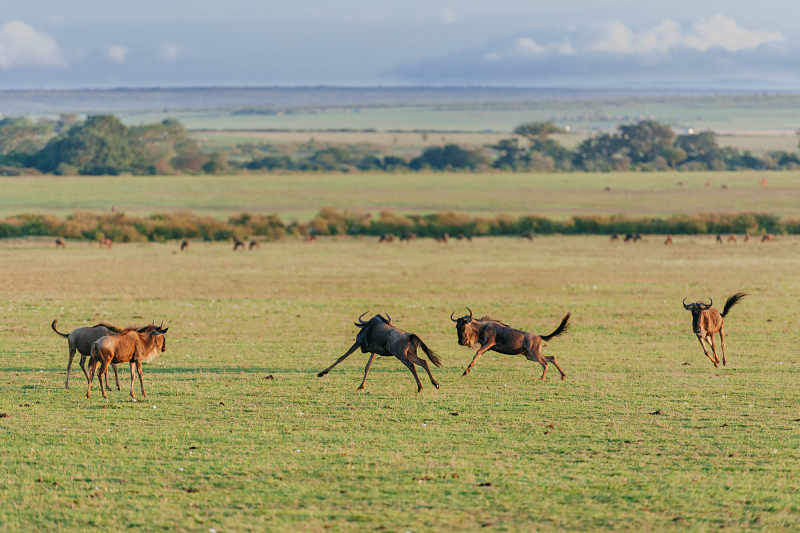
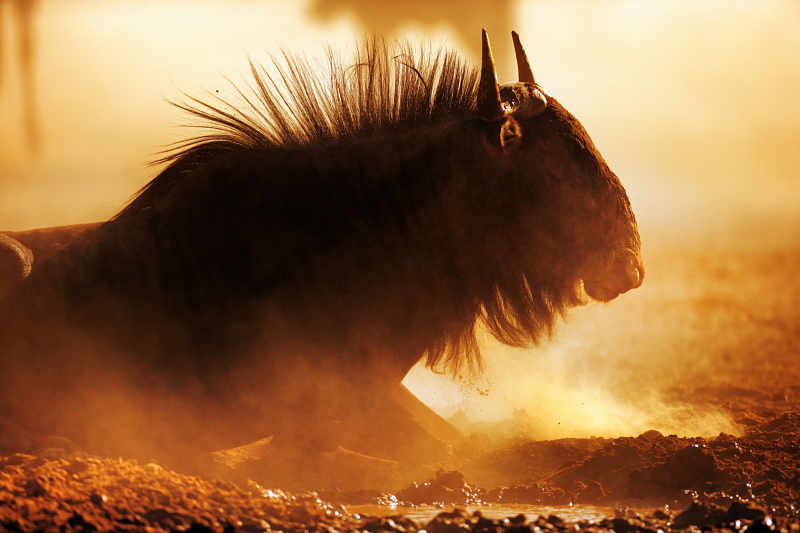
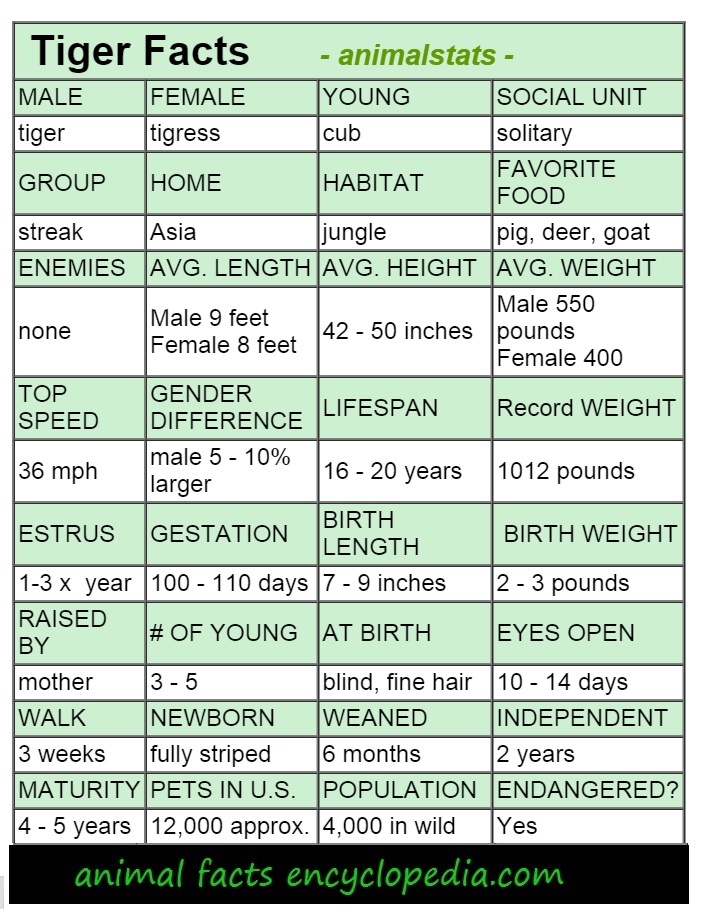

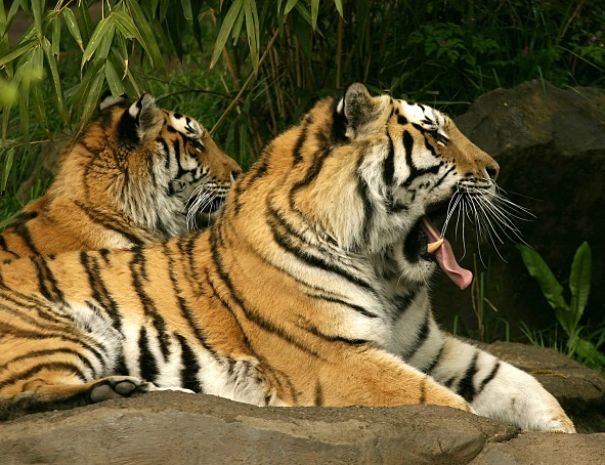

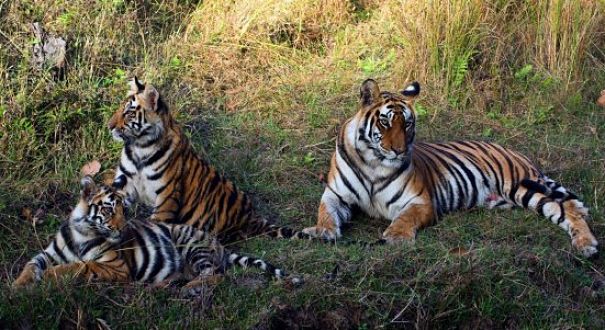
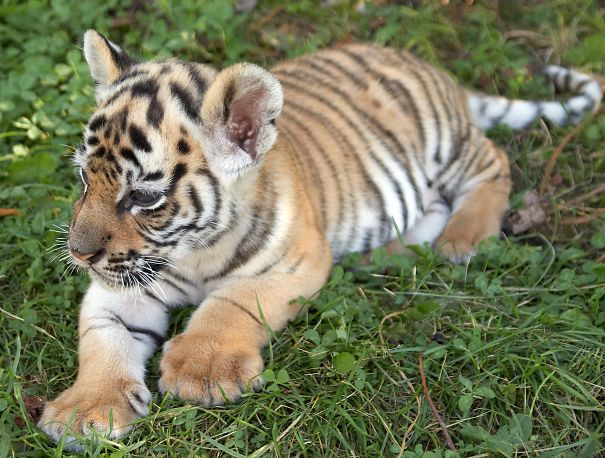
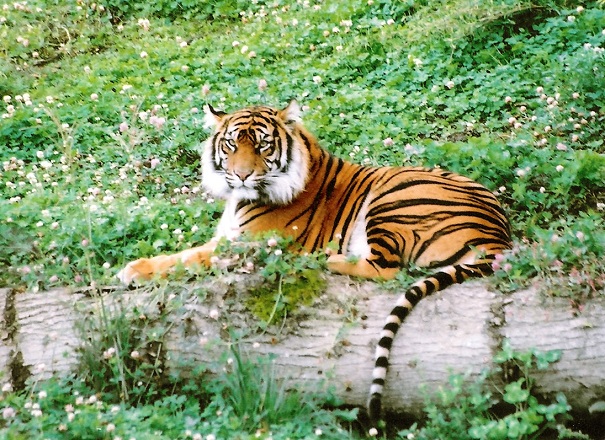

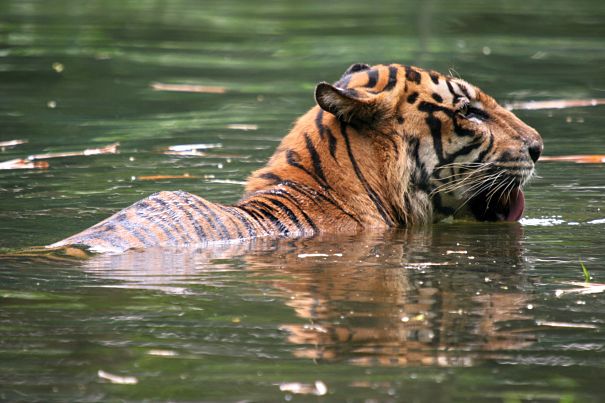
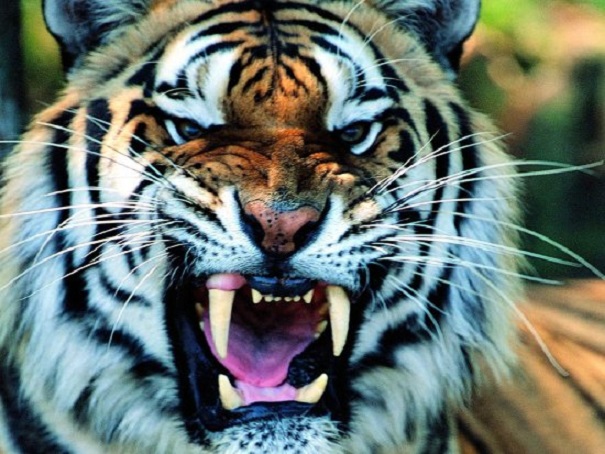

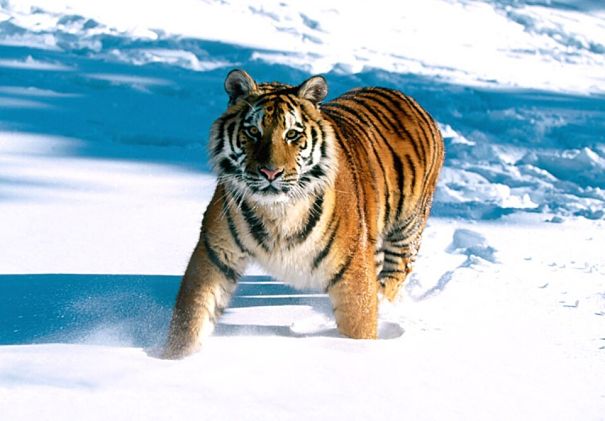
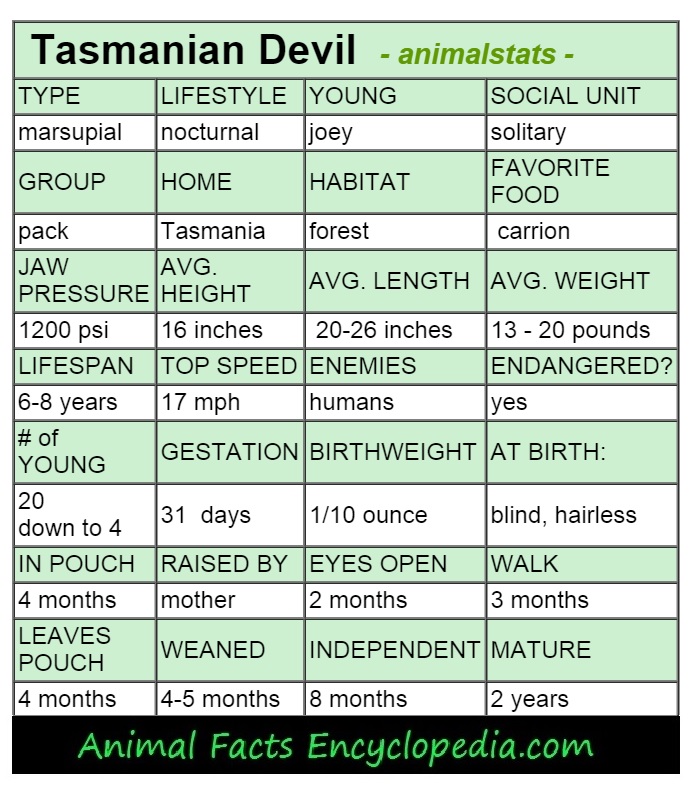
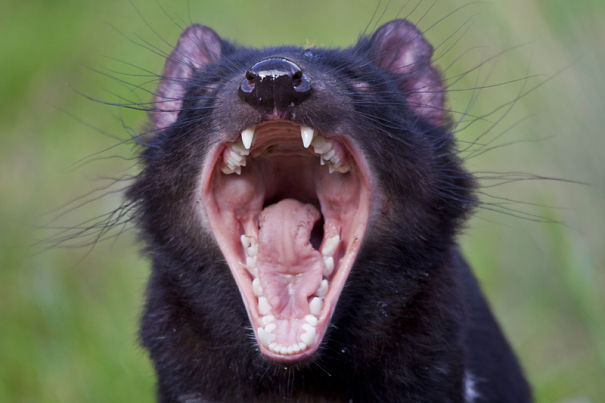
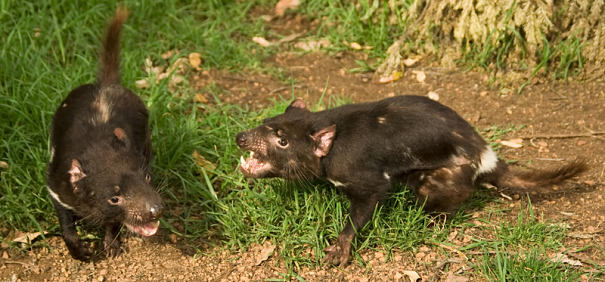
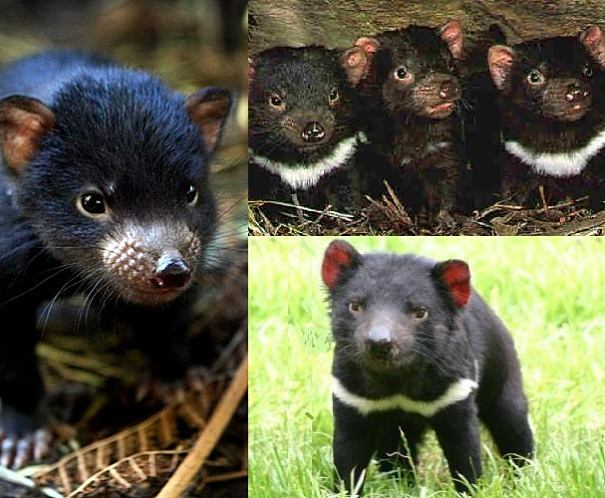

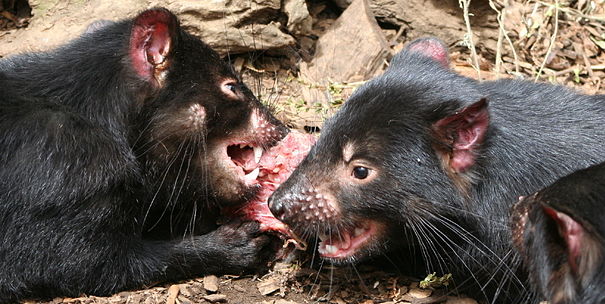
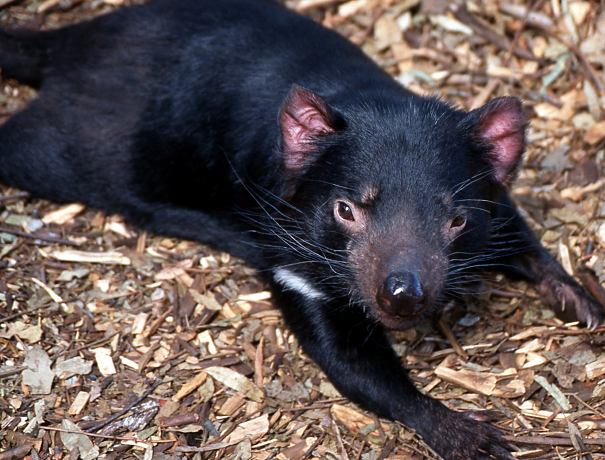
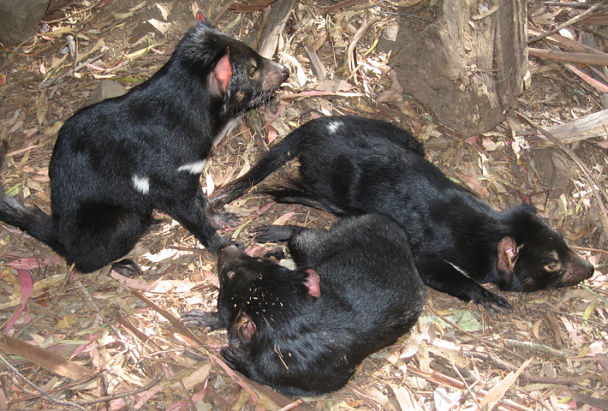
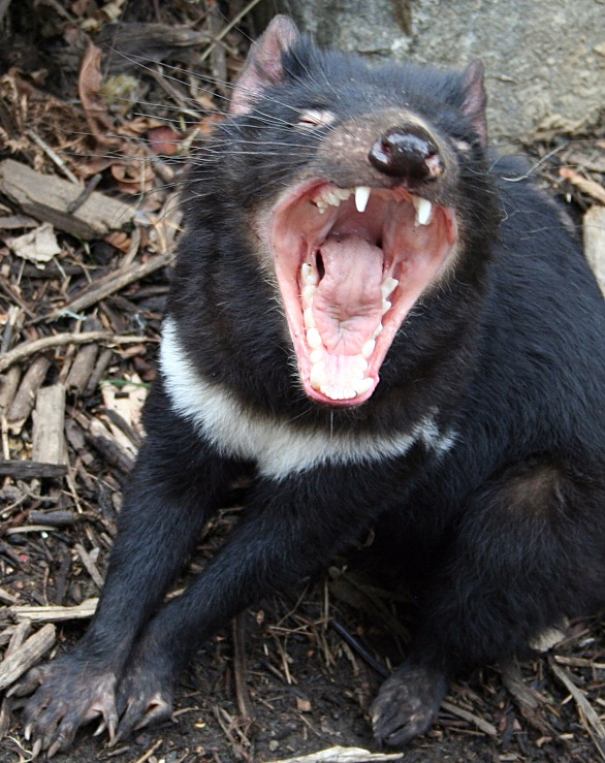
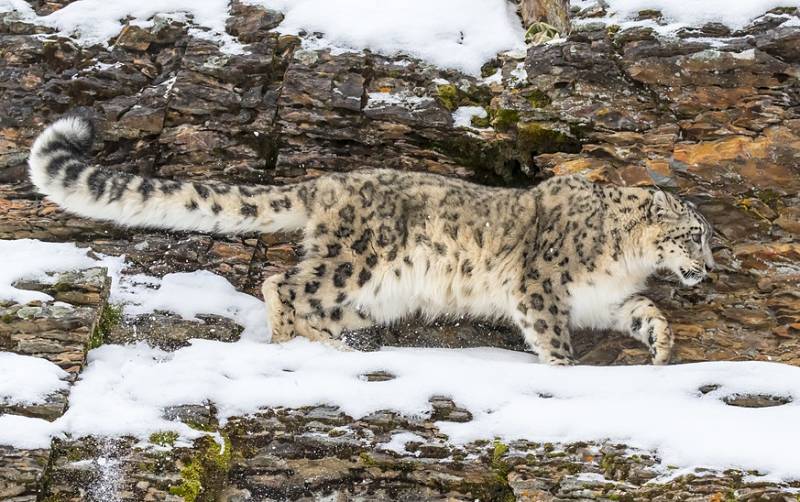
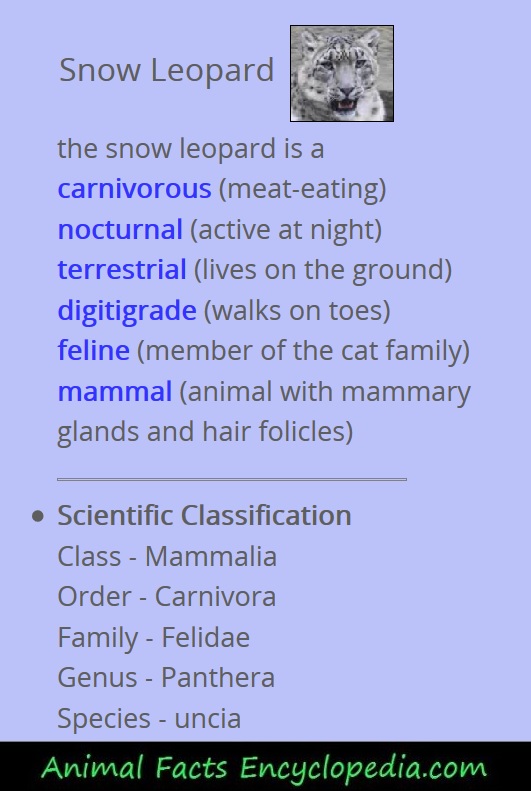
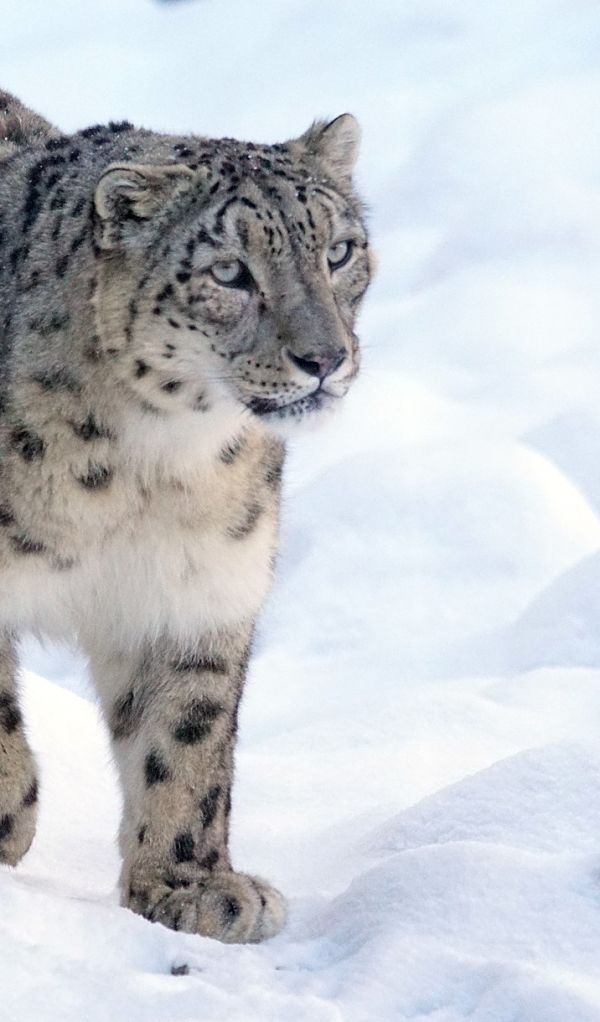
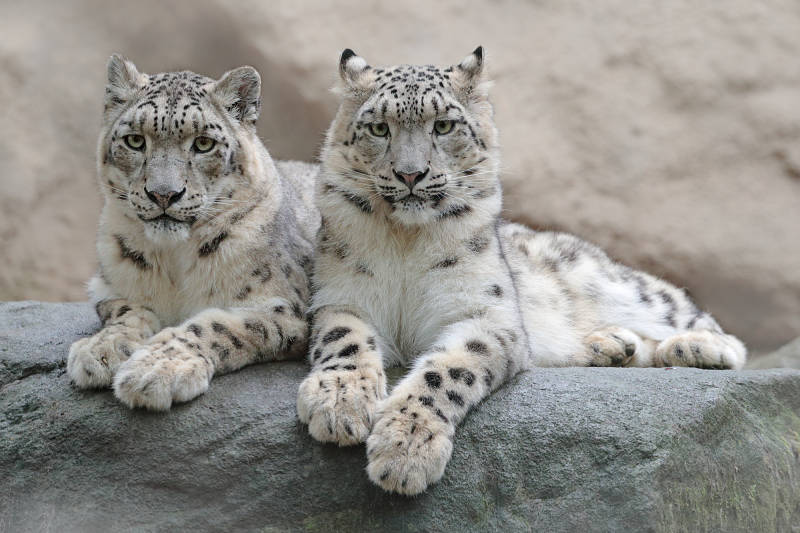
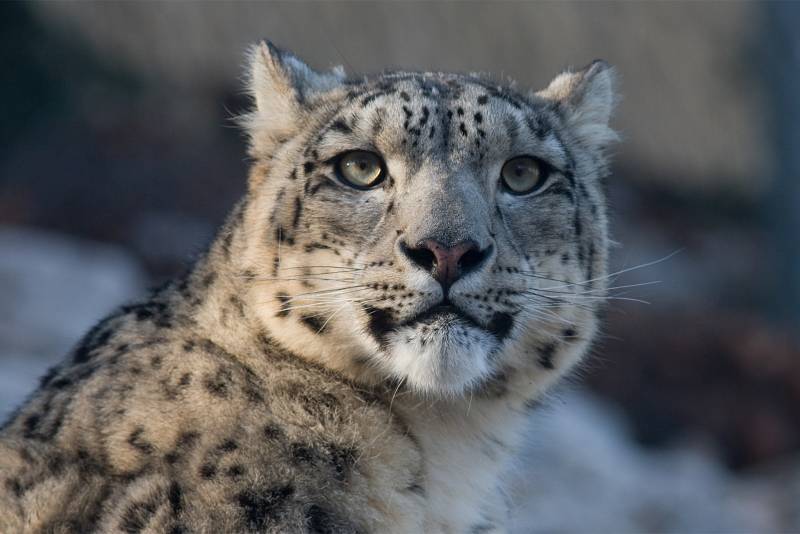
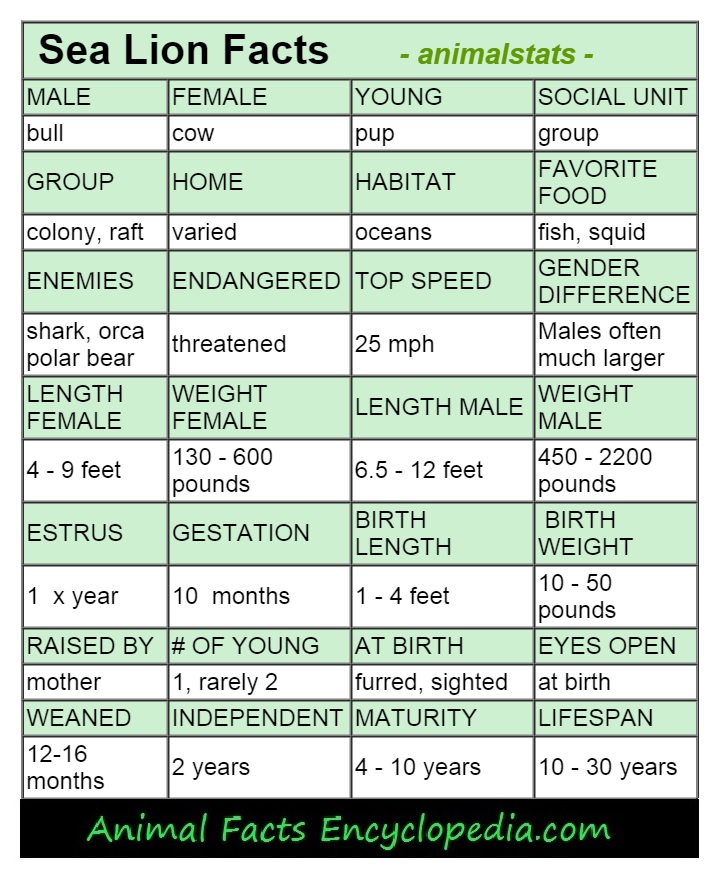
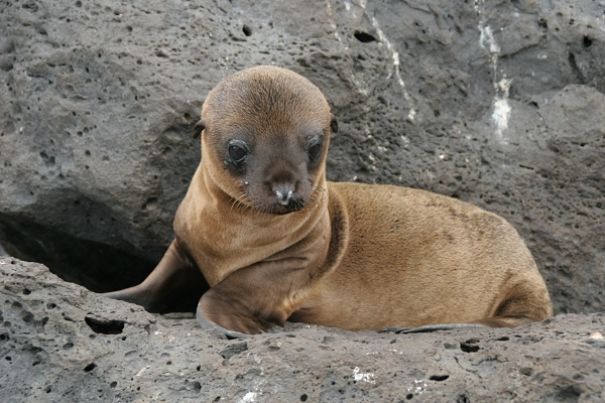
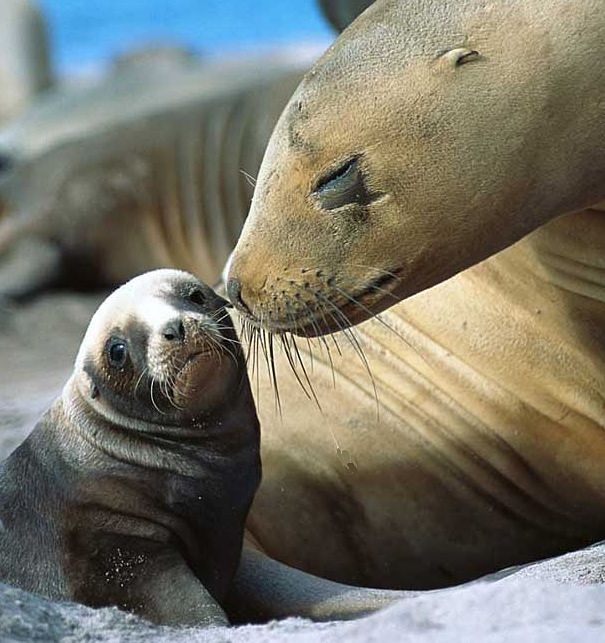

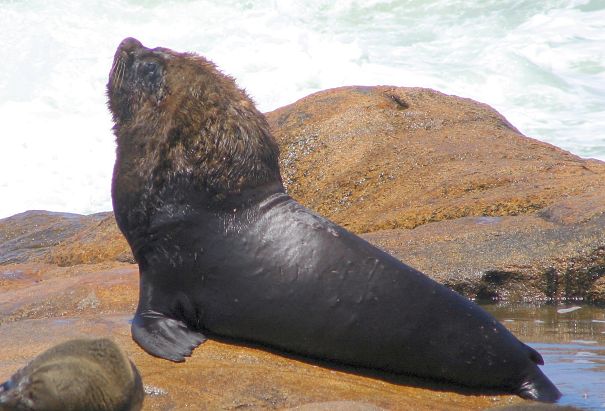
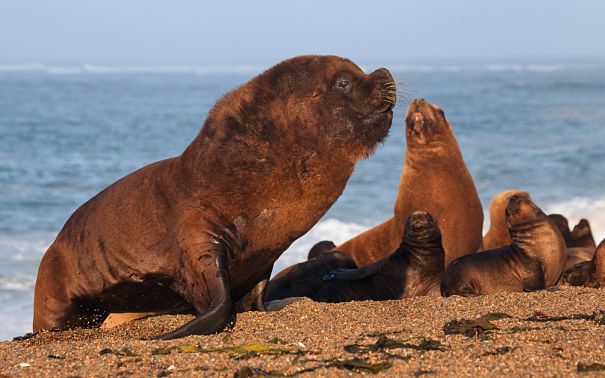








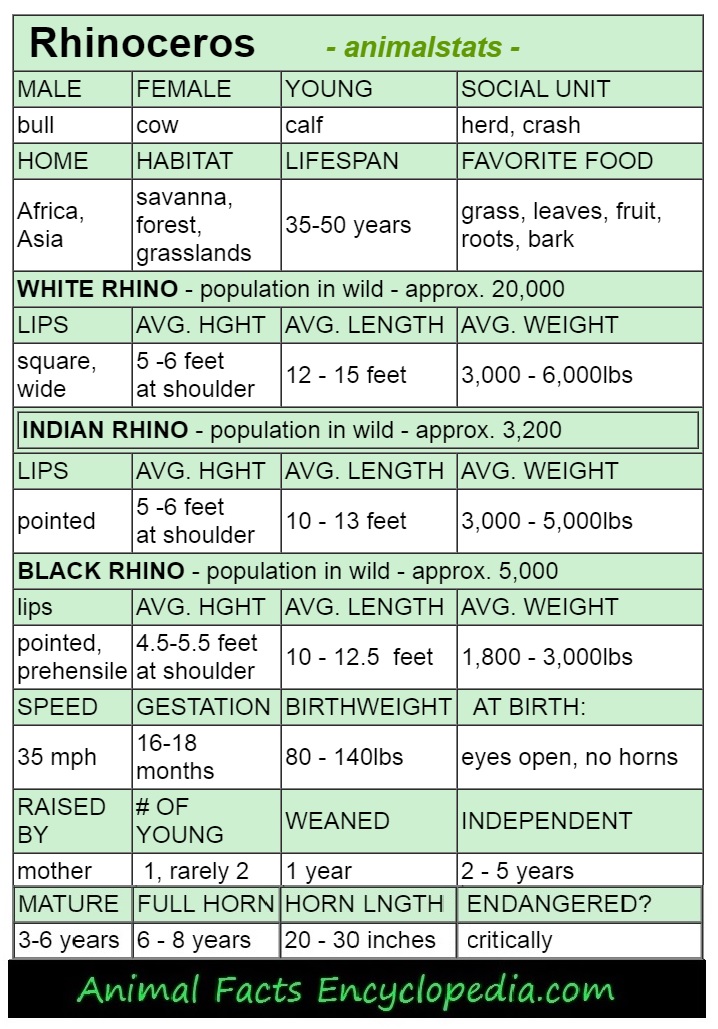


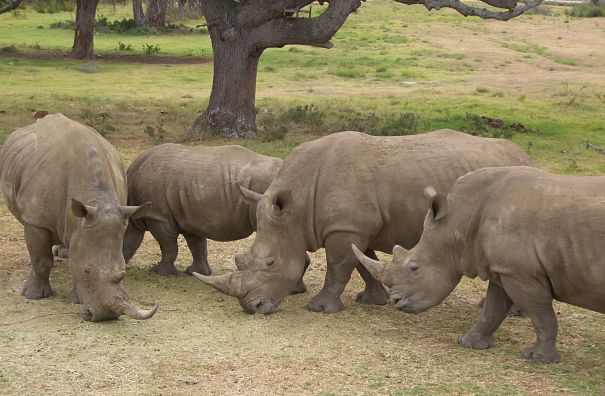
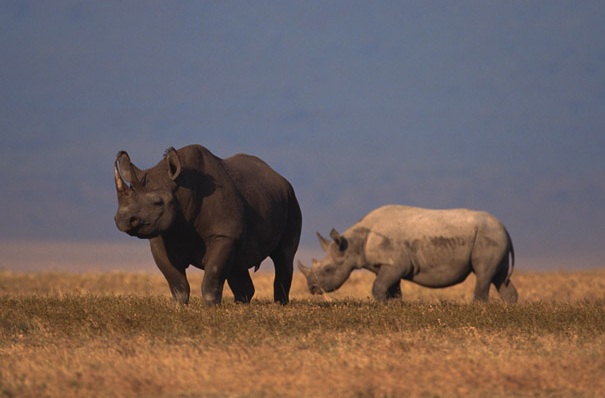
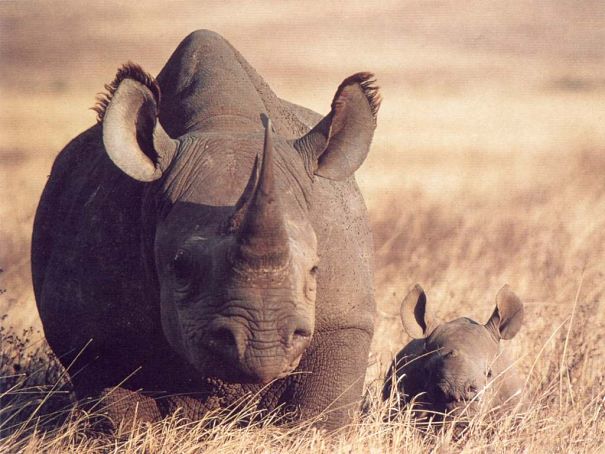
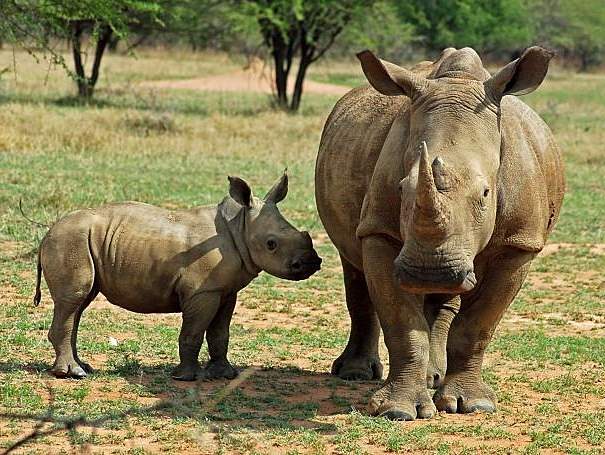
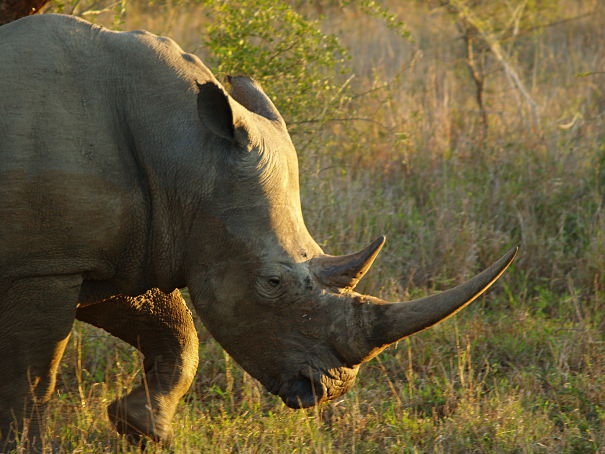

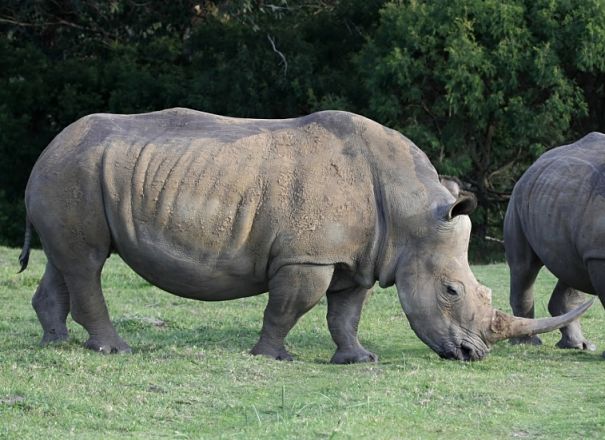
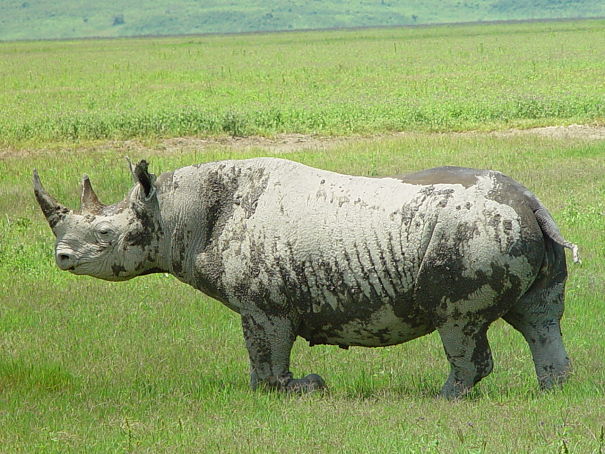
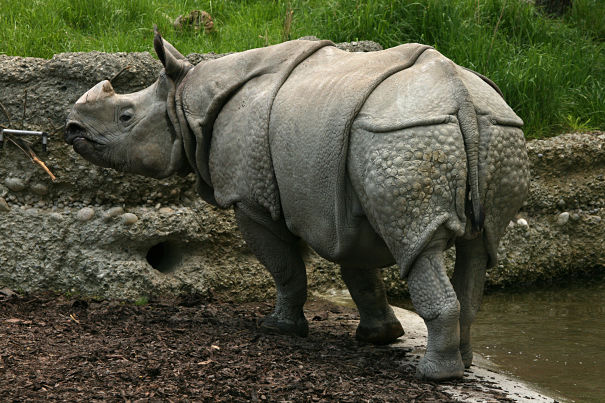
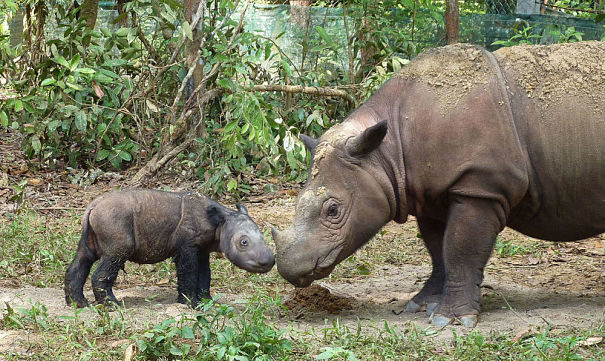
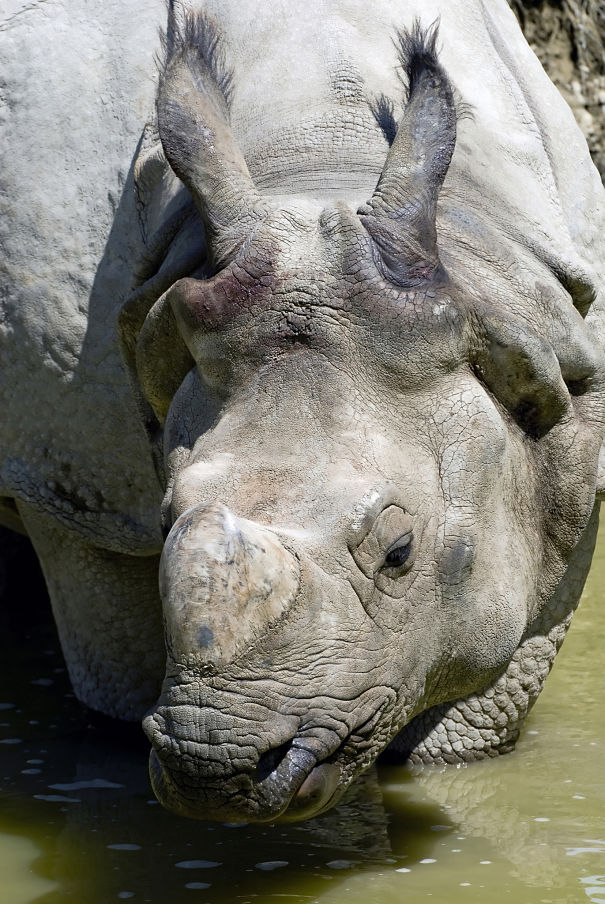
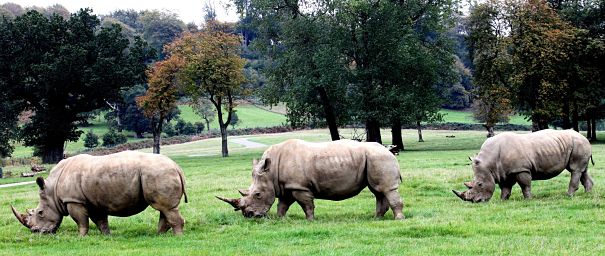
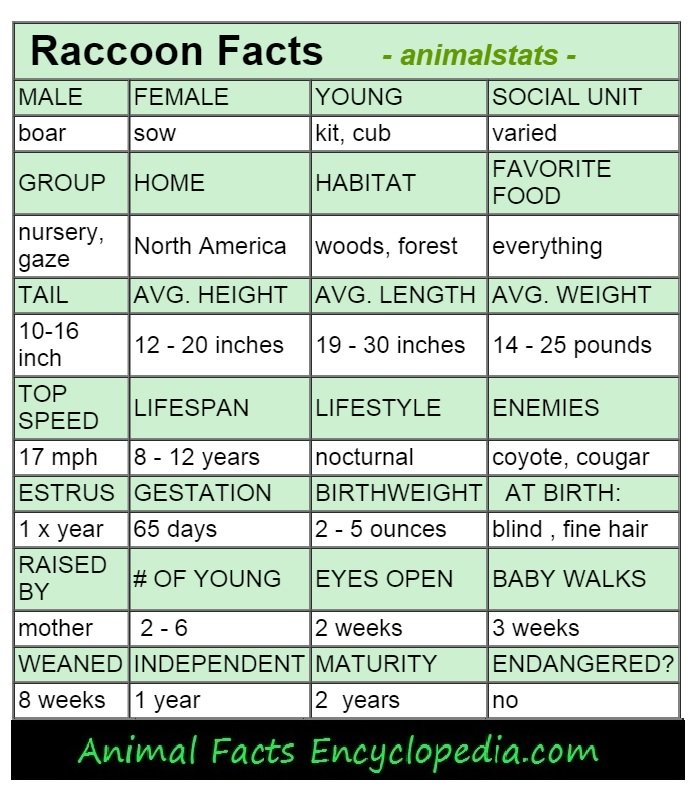
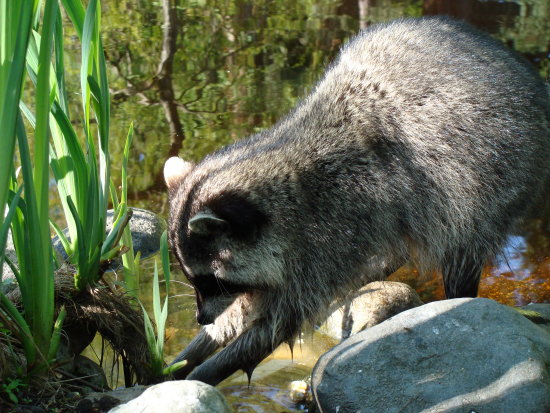 raccoon "washing" food
raccoon "washing" food
